Shedding pounds often revolves around endless cardio sessions, but what if there was a more effective way to reach your weight loss goals?
Studies have shown that people who lose weight without strength training experience significant muscle loss, up to 30% in some cases [*].
This can leave your metabolism sluggish and hinder long-term weight management.
This guide unlocks the power of strength training for weight loss, revealing beginner-friendly exercises and strategies to build muscle, boost your metabolism, and sculpt a toned physique.
Understanding Weight Loss and Strength Training
Unveiling the Mystery: Weight Loss vs. Fat Loss
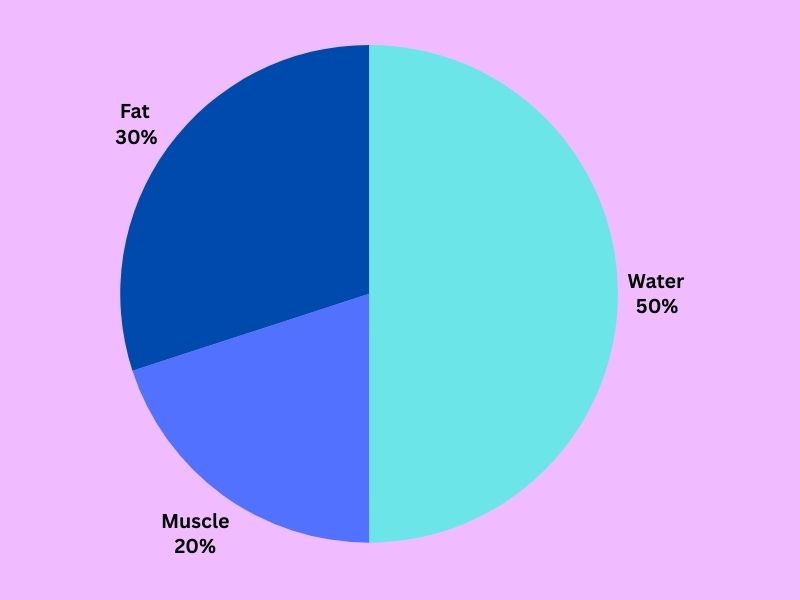
First things first, let’s clear up a common misconception. The number on the scale doesn’t always tell the true story. Weight loss can encompass both muscle and fat loss.
Here’s the breakdown:
- Weight Loss: Simply losing weight, regardless of whether it’s muscle or fat. This can happen through various means, including drastic calorie restriction or dehydration.
- Fat Loss: Specifically targeting and reducing body fat, which is the primary goal for most weight loss efforts.
Here’s the kicker: When you rely solely on cardio or calorie restriction, you might be losing precious muscle along with fat.
Weight loss can encompass both muscle and fat loss, and that’s where the problem lies.
Muscle is denser than fat, meaning you can lose significant fat while maintaining your weight, leading to a slimmer, more toned physique – even if the number on the scale doesn’t change dramatically. [*]
So, What Exactly is Strength Training?

Strength training, also known as resistance training, involves using weights, resistance bands, or even your own bodyweight to challenge your muscles.
It’s like giving them a workout, making them stronger and more resilient.
Here’s the magic: muscle burns more calories than fat, even at rest.
This is known as your Basal Metabolic Rate (BMR), the number of calories your body burns just to function.
By building muscle mass, you essentially increase your body’s natural calorie-burning furnace, even when you’re not actively exercising.
Why Strength Training Matters for Weight Loss
Let’s face it, traditional weight loss advice often emphasizes endless cardio sessions – pounding the pavement or getting lost on the elliptical trainer.
While cardio has its place, it’s not the whole story.
In fact, many people hit a plateau or feel discouraged because they’re missing a crucial piece of the puzzle: strength training.
Here’s why strength training should be your secret weapon for achieving your weight loss goals:
1. Muscle: The Ultimate Calorie Torch (8% vs 3%):
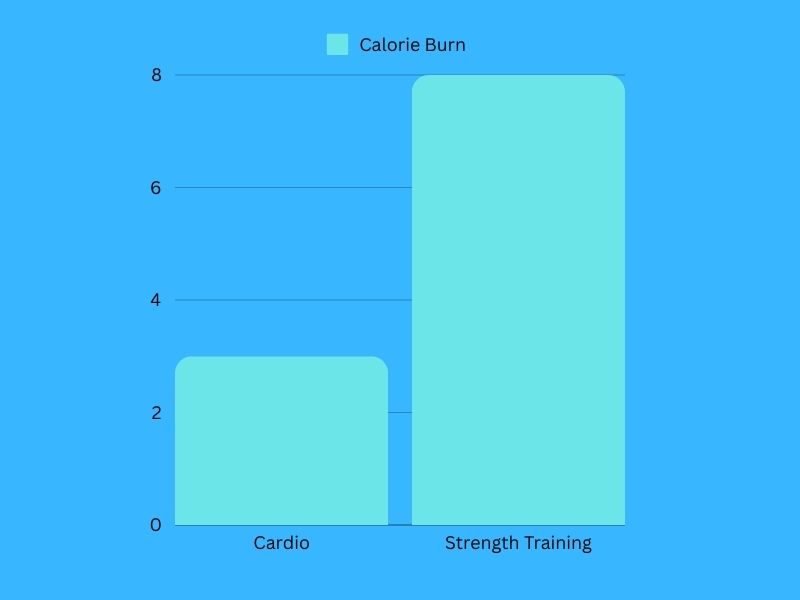
Imagine this: a pound of muscle burns around 8 calories at rest, while a pound of fat burns a measly 3 calories.
That’s a whopping 266% difference.
Strength training helps you build muscle, gradually increasing your Basal Metabolic Rate (BMR), the number of calories your body burns even while you’re chilling on the couch.
2. Bye-Bye Flab, Hello Definition:

So you might not see a drastic shift on the scale right away.
That’s because muscle is denser than fat, meaning you can lose fat and gain muscle while maintaining your weight.
But here’s the cool part: your clothes will start to fit differently.
You’ll see a more toned and defined physique as fat sheds away, revealing the sculpted muscle underneath.
3. The Afterburn Effect: Calories Keep Burning (Even After You Stop):
Ever feel like your body is buzzing with energy after a tough workout?
That’s the afterburn effect in action.
Strength training creates microscopic tears in your muscle fibers (don’t worry, they repair stronger!).
This repair process burns extra calories even after your workout is done, a phenomenon called Excess Post-exercise Oxygen Consumption (EPOC) [*].
It’s like your body is working overtime to rebuild and get stronger, all while burning extra calories – a win-win!
4. Building Strength = Building Confidence:

Strength training isn’t just about aesthetics; it’s about empowerment.
As you get stronger, everyday tasks become easier.
You can carry groceries with ease, conquer those stairs without huffing and puffing, and feel a newfound sense of confidence in your physical abilities.
This boost in confidence can translate into other areas of your life, making you feel more capable and energized.
5. Long-Term Benefits: A Healthy Habit for Life:

Strength training isn’t just a weight loss fad; it’s a sustainable lifestyle choice.
Studies have shown that strength training can help improve bone health, reduce the risk of chronic diseases like heart disease and diabetes [*], and even improve your mood and cognitive function.
By building strong muscles and bones, you’re investing in a healthier, happier you for years to come.
Getting Started with Strength Training
Okay, you’re convinced strength training is the missing piece in your weight loss puzzle.
Let’s face it, venturing into the weight room can be intimidating, especially for beginners.
Fear not. This section will be your roadmap to getting started with strength training safely and effectively.
The only way to get started, is to get the membership of the gym. Just kidding
When you step in the gym for the very first time, you will be face some issues which is crowd, big people, fear of judgement, etc.
With those you will be mindless, like where to begin, where to start, which exercise should i do first, and many more questions like this.
So, the main breakdown is not to panic and not to feel intermediated.
As your are very new to workout and your body is not habitual with the exercises, so start with full body workout for at least a week.
It will help your body to get aquatinted with the gym and help your body too. As first gym goers may find some pain in their body it is due to the microscopic pores that open ups when you do exercises.
After the full body equip Bro-split workout routine, it is just training single body parts, like Monday-chest, Tuesday- back.
It will help you to train your each body part once a week.
For some starting month, let say 2-3 months, of doing these bro-split workout routine, i would advise you to experiment with different types of exercises like say you’re training chest and hitting flat dumbbell press, so in next chest session try different variation for the exercise which can be machine press or the barbell press.
It will allow you to choose and find which exercises fits for you, there is no specific exercises which will fit for everyone.
Also, it is also to consider proper form while doing strength training. Next section will guide you.
Why Proper Form is Your Best Friend (and How to Achieve It)

We can’t stress this enough – proper form is paramount.
Using the wrong technique can lead to injuries, and that’s definitely not what we want.
Throughout this section, we’ll be hammering home the importance of form with clear instructions and helpful video demonstrations for each exercise.
Consider this your cheat sheet to nailing proper technique and keeping your workouts injury-free.
Bye-Bye Blunders: Common Mistakes to Avoid

Even the most dedicated gym newbie can make mistakes.
Here are some common ones to watch out for:
- Ego Lifting
- Form Fumbles
- Neglecting Rest
Weight It Right: Finding Your Perfect Match
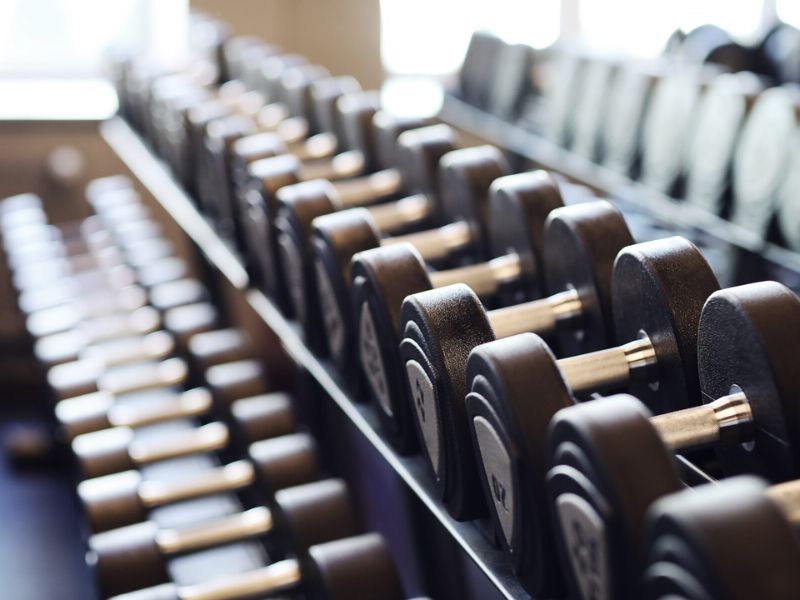
Choosing the right weight is key. You want a weight that challenges you but allows you to maintain proper form throughout the entire set of repetitions.
Here’s a good rule of thumb:
- You should feel challenged during the last few repetitions of each set, but still be able to maintain proper form.
- If you can breeze through a set with perfect form, it’s time to increase the weight slightly.
- Conversely, if your form starts to break down before the end of the set, the weight is too heavy.
Bonus Tip: When it comes to strength training, many people wonder whether it’s better to do high reps with lighter weights or low reps with heavier weights.
Here’s the solution: If you’re new to resistance training and still getting the hang of exercises, it’s best to start with high reps and lower weights.
This helps you get used to using weights and focuses on building a good connection between your mind and muscles. For intermediate lifters who have some experience, using higher weights can be beneficial for building more strength.
And importantly, if you’re overweight or not in the best shape, opting for higher reps and lower weights is a smart choice. This approach can help you sculpt your body more effectively than lifting heavier weights.
So, the key is to tailor your approach based on your experience level and fitness goals, always focusing on proper form and gradual progress.
Building a Sustainable Routine: Frequency is Key
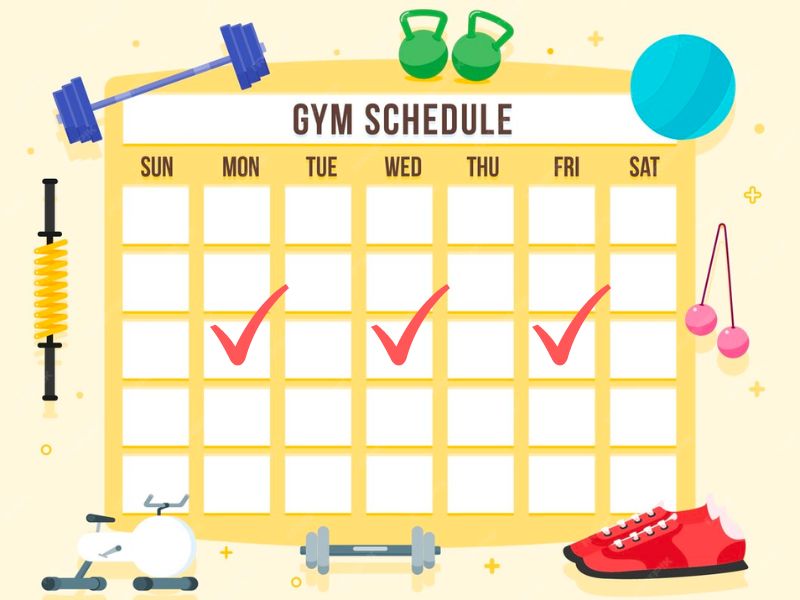
We all know that consistency is key to achieving any goal. The same holds true for strength training.
Aim for 2-3 strength training sessions per week, with rest days sprinkled in between.
Why rest days?
Because during your workouts, you create microscopic tears in your muscle fibers.
Rest allows your body to repair and rebuild these fibers, making them stronger.
Think of it as your muscles getting a well-deserved power nap!
Best Strength Training Exercises for Weight Loss
Here are the list of Best of the Strength Training exercises for weight loss, but:
Your body is unique, so your workout should be too!
- Think of it like clothes shopping – one size doesn’t fit all.
- Exercises that work great for someone else might feel awkward or uncomfortable for you.
Why does this matter?
- Exercises that fit you better help you:
- Feel the right muscles working (mind-muscle connection).
- Get better results from your workout.
- Avoid injuries.
How to find your perfect exercises?
- Try different variations of exercises (e.g., dumbbell vs. machine).
- Pick exercises that feel natural and comfortable, not painful.
Dumbbell exercises:
chest:
Dumbbell Bench Press:
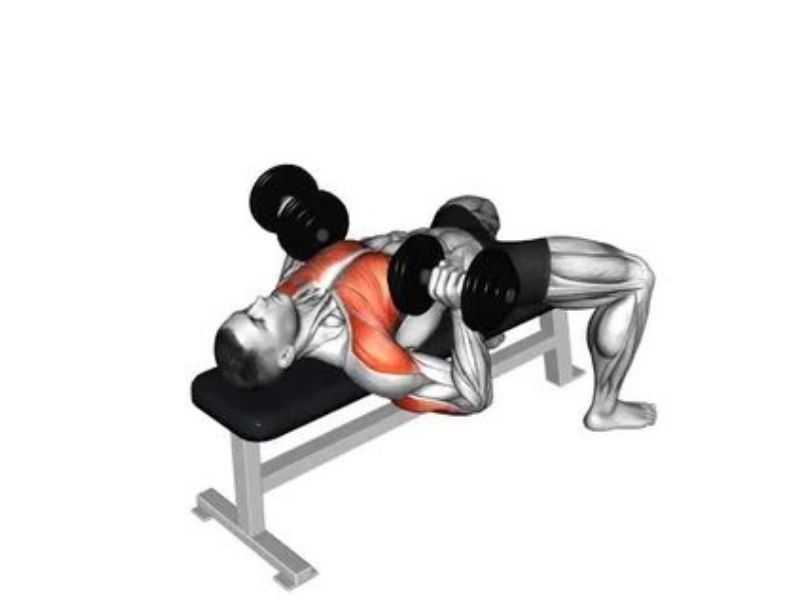
- Lie on a flat bench with a dumbbell in each hand.
- Hold the dumbbells above your chest, arms extended but not locked.
- Lower the dumbbells slowly until they are just outside your chest.
- Press the dumbbells back up to the starting position, exhaling as you push.
- Keep your elbows slightly bent throughout the movement to protect your joints.
Dumbbell Flyes:
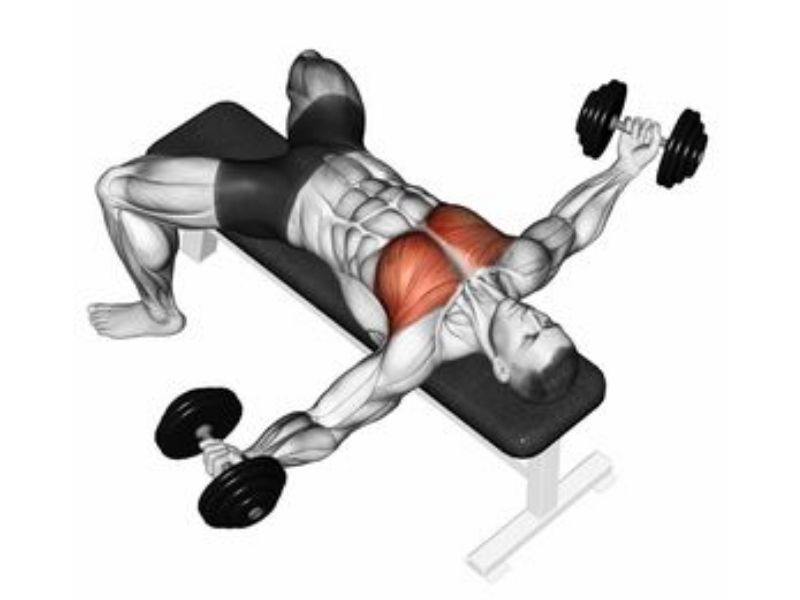
- Lie on a flat bench with a dumbbell in each hand, palms facing inward.
- Extend your arms above your chest, elbows slightly bent.
- Lower the dumbbells out to the sides in a wide arc, keeping a slight bend in your elbows.
- Stop when your elbows are in line with your shoulders or slightly below.
- Bring the dumbbells back together over your chest, squeezing your pecs.
Dumbbell Pullover:
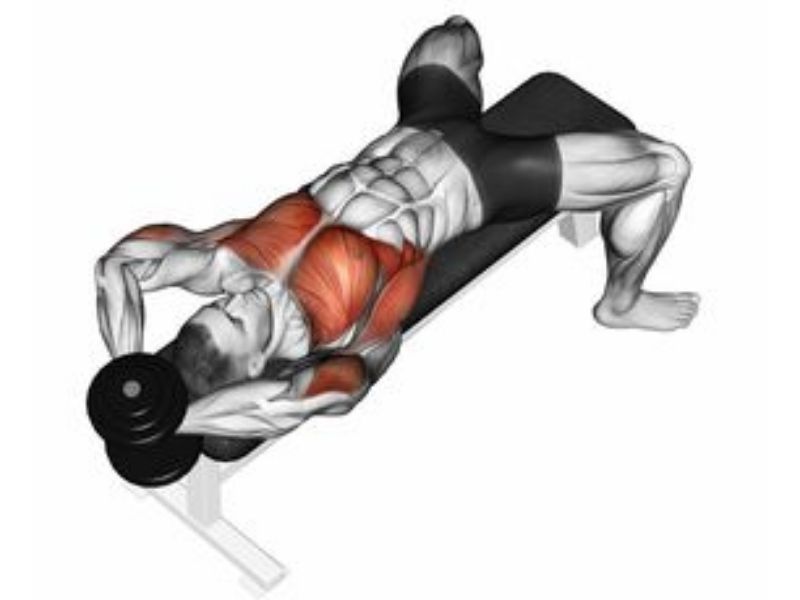
- Lie on a bench with only your upper back and shoulders supported.
- Hold a dumbbell with both hands above your chest, arms extended.
- Lower the dumbbell behind your head in a controlled motion, keeping a slight bend in your elbows.
- Stop when your arms are parallel to the floor or slightly below.
- Bring the dumbbell back up to the starting position, engaging your lats and chest.
Incline Dumbbell Press:
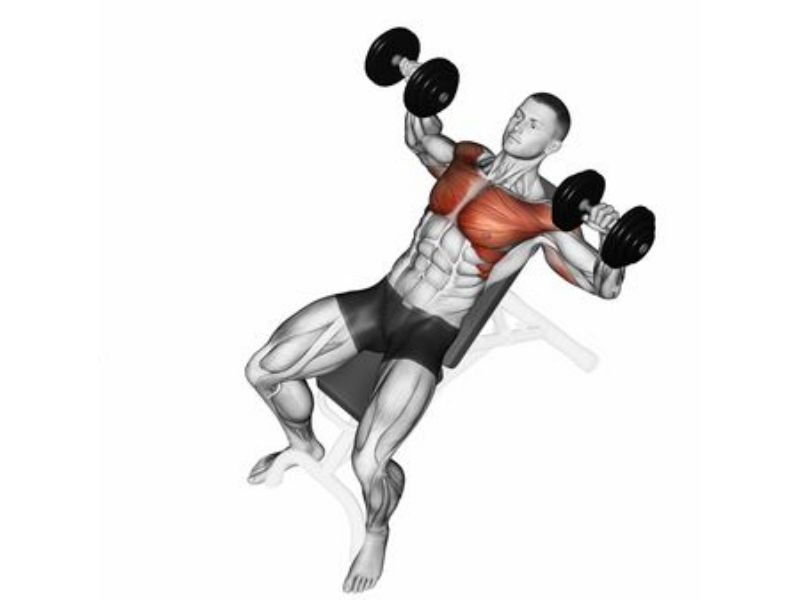
- Set an incline bench to about a 30-45 degree angle.
- Lie back on the bench with a dumbbell in one hand, arms extended above your chest.
- Lower the dumbbells down to your chest.
- Press the dumbbell back up to the starting position, exhaling as you push.
- Keep your shoulder blades retracted throughout the movement to stabilize your shoulders.
Decline Dumbbell Press:
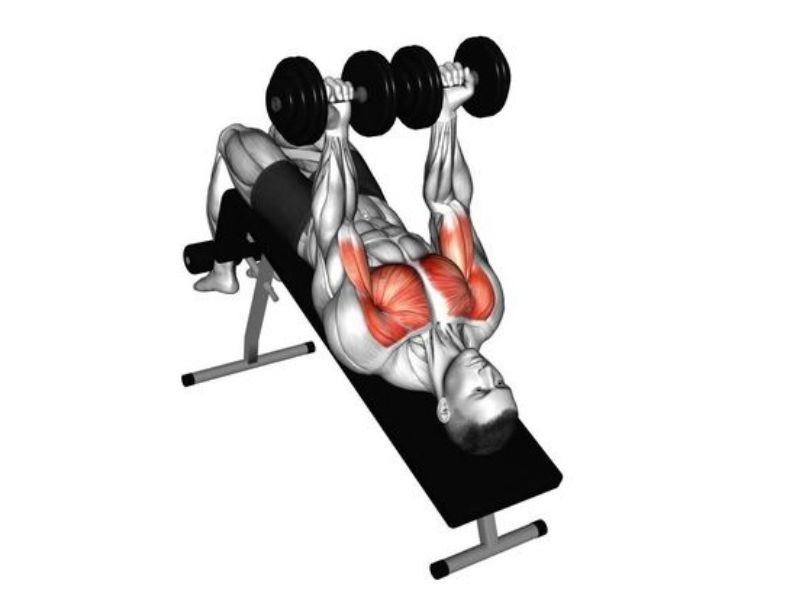
- Set a decline bench to about a 30-45 degree angle.
- Lie back on the bench with a dumbbell in each hand, arms extended above your chest.
- Lower the dumbbells down towards your chest, elbows at a 90-degree angle.
- Press the dumbbells back up to the starting position, exhaling as you push.
- Maintain control throughout the movement, focusing on engaging your chest muscles.
Back:
Dumbbell Rows:

- Stand with your feet shoulder-width apart, holding a dumbbell in each hand.
- Hinge at your hips, keeping your back flat and chest up.
- Pull the dumbbells towards your hips, squeezing your shoulder blades together.
- Lower the dumbbells back down with control, fully extending your arms.
- Keep your core engaged throughout the movement to stabilize your spine.
Renegade Rows:

- Start in a high plank position with a dumbbell in each hand, wrists directly under your shoulders.
- Keeping your core tight and hips level, row one dumbbell up towards your ribcage, elbow pointing towards the ceiling.
- Lower the dumbbell back down with control, then repeat on the other side.
- Alternate rows between each arm while maintaining a stable plank position.
- Focus on keeping your body still and avoiding rotation in your hips.
Single-Arm Dumbbell Row:
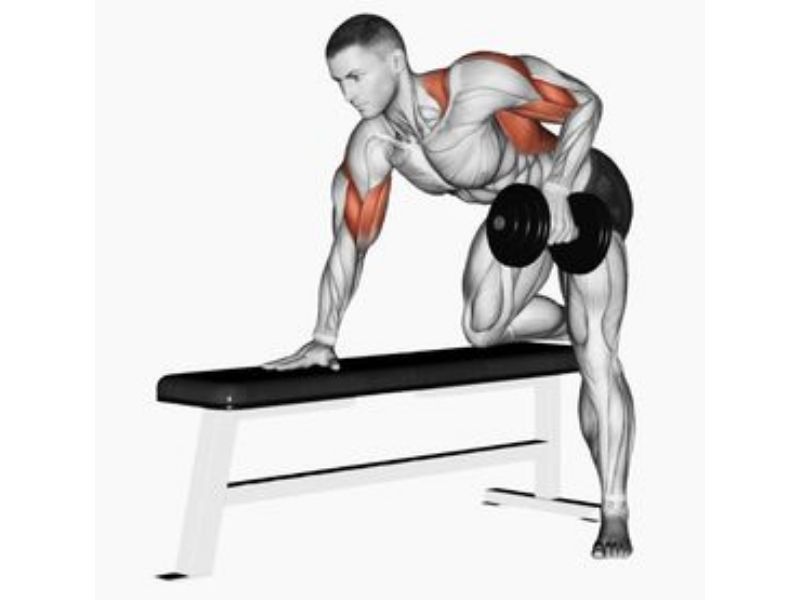
- Stand with your feet shoulder-width apart, holding a dumbbell in one hand.
- Hinge at your hips, keeping your back flat and chest up, and extend your arm towards the floor.
- Pull the dumbbell towards your hip, bending your elbow and squeezing your shoulder blade.
- Lower the dumbbell back down with control, fully extending your arm.
- Keep your core engaged and your back straight throughout the movement.
Dumbbell Deadlift:
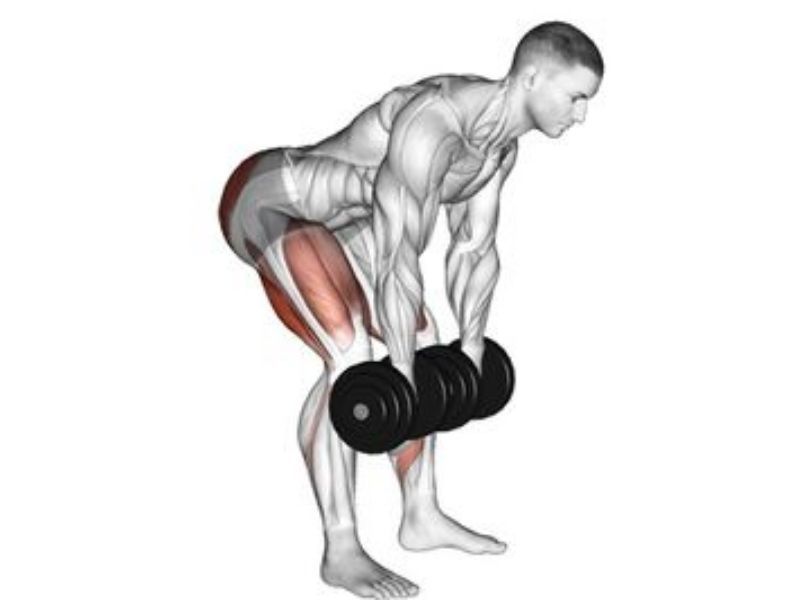
- Stand with your feet hip-width apart, holding a dumbbell in each hand in front of your thighs.
- Hinge at your hips, pushing your hips back as you lower the dumbbells towards the floor.
- Keep your back flat and chest up, with a slight bend in your knees.
- Push through your heels to stand back up, squeezing your glutes at the top.
- Maintain a neutral spine throughout the movement, avoiding rounding or arching your back.
Dumbbell Pullover:
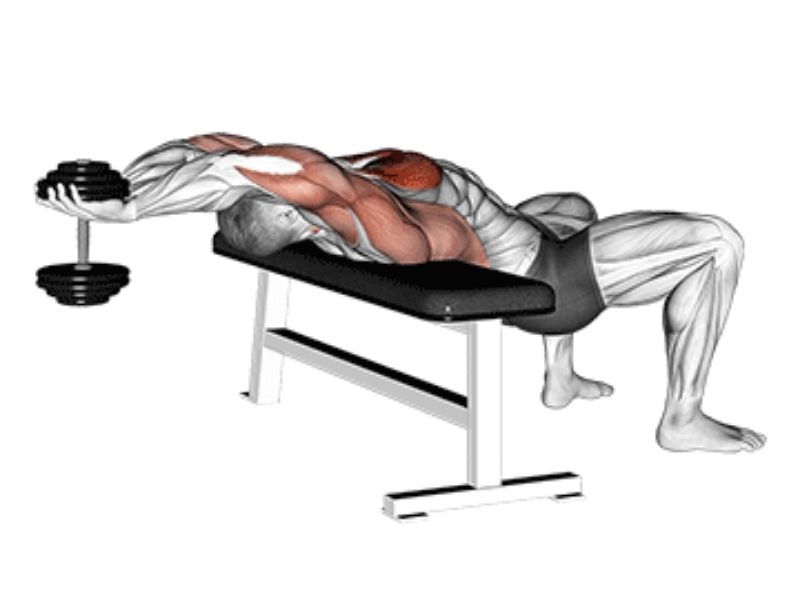
- Lie on a bench with only your upper back and shoulders supported, holding a dumbbell with both hands above your chest.
- Keep a slight bend in your elbows as you lower the dumbbell behind your head, feeling a stretch in your chest and lats.
- Pull the dumbbell back up towards the ceiling, engaging your lats and chest muscles.
- Keep your core engaged and your lower back pressed into the bench to stabilize your spine.
- Control the movement throughout, focusing on the muscles you’re targeting.
Shoulder:
Dumbbell Shoulder Press:
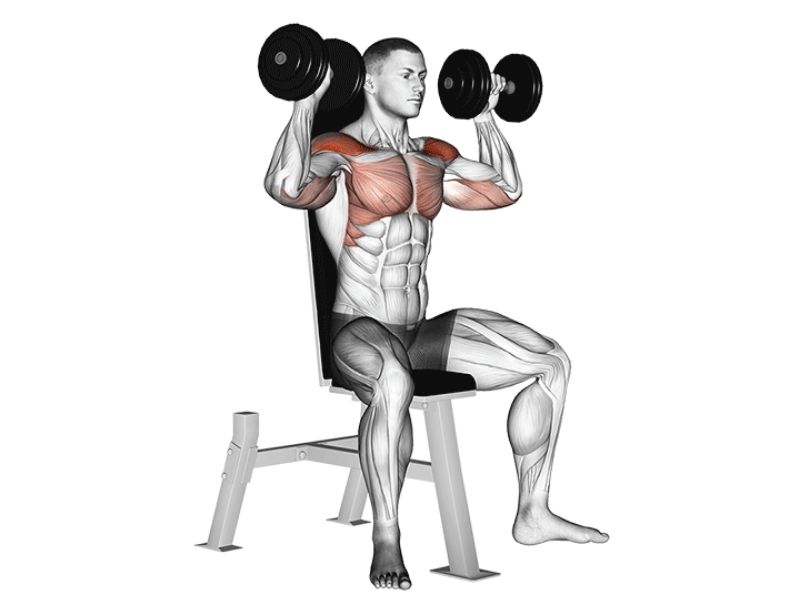
- Sit on a bench with back support, or stand with your feet shoulder-width apart.
- Hold a dumbbell in each hand at shoulder height, palms facing forward.
- Press the dumbbells overhead until your arms are fully extended, but not locked.
- Lower the dumbbells back down to shoulder height with control.
- Keep your core engaged and avoid arching your back throughout the movement.
Lateral Raises:
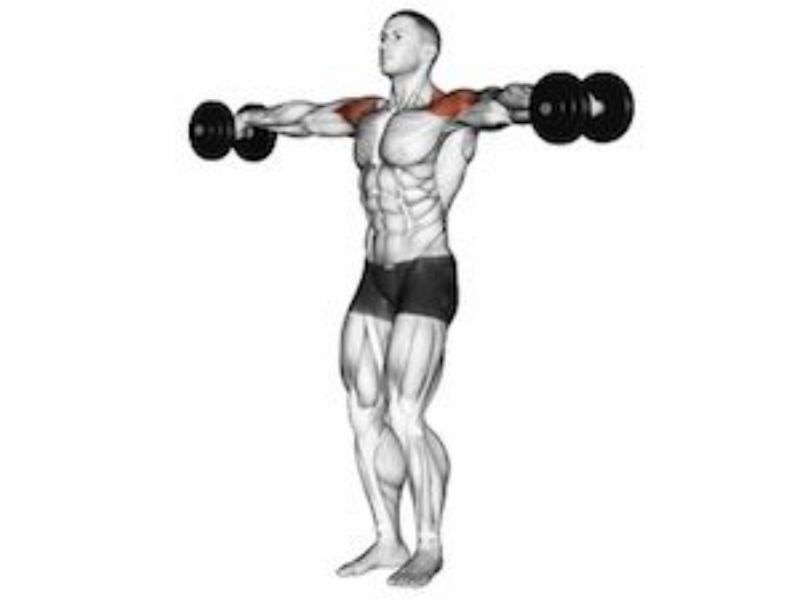
- Stand with your feet hip-width apart, holding a dumbbell in each hand by your sides.
- Keep a slight bend in your elbows as you raise the dumbbells out to the sides until they reach shoulder height.
- Maintain a slight bend in your elbows throughout the movement.
- Lower the dumbbells back down with control, resisting the urge to swing them.
Front Raises:
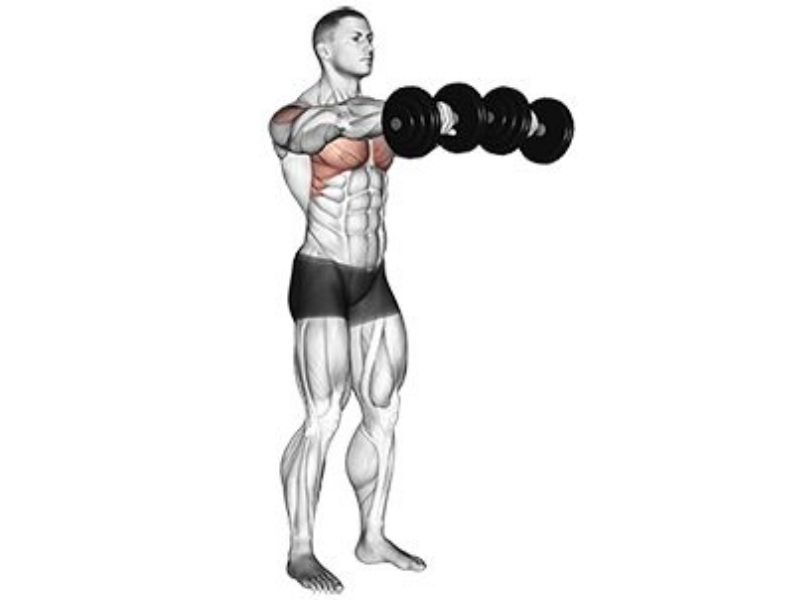
- Stand with your feet hip-width apart, holding a dumbbell in each hand in front of your thighs.
- Keep a slight bend in your elbows as you raise the dumbbells directly in front of you until they reach shoulder height.
- Avoid swinging the dumbbells or using momentum to lift them.
- Lower the dumbbells back down with control, maintaining tension in your shoulders.
Dumbbell Shrugs:

- Stand with your feet hip-width apart, holding a dumbbell in each hand by your sides.
- Elevate your shoulders towards your ears as high as possible, keeping your arms straight.
- Squeeze your shoulder blades together at the top of the movement.
- Lower the dumbbells back down with control, fully extending your arms.
- Focus on using your traps to lift the weight rather than your arms.
Arnold Press:
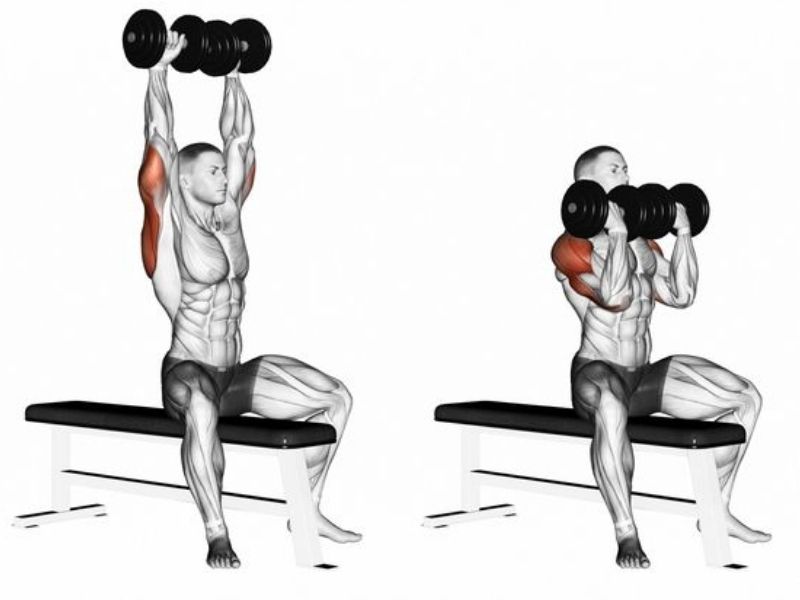
- Sit on a bench with back support, or stand with your feet shoulder-width apart.
- Hold a dumbbell in each hand at shoulder height with your palms facing towards you.
- Press the dumbbells overhead while simultaneously rotating your palms to face forward.
- At the top of the movement, your arms should be fully extended with your palms facing forward.
- Reverse the motion by rotating your palms back towards you as you lower the dumbbells back down to shoulder height.
Legs:
Dumbbell Squats:
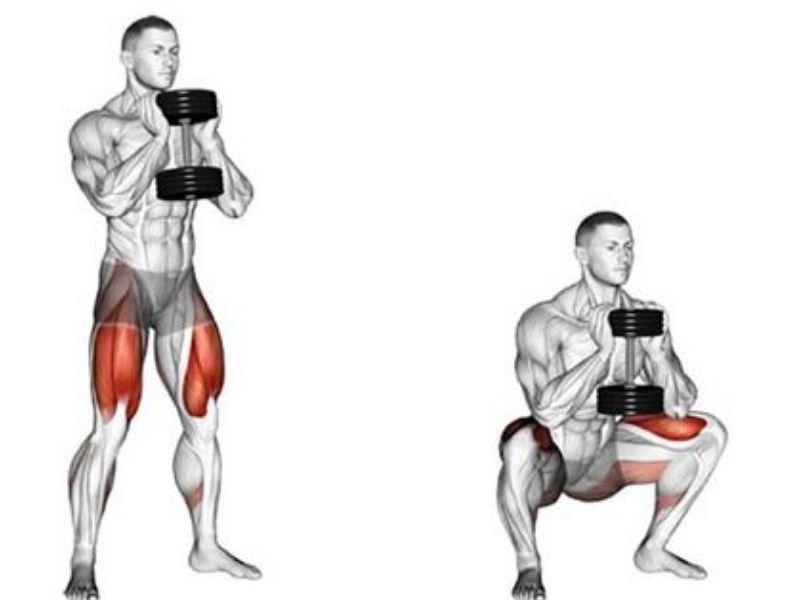
- Stand with your feet shoulder-width apart, holding a dumbbell in each hand at your sides.
- Keep your chest up and your core engaged as you lower your body into a squat position, pushing your hips back and bending your knees.
- Lower down until your thighs are parallel to the ground, or as low as you can comfortably go.
- Push through your heels to return to the starting position, fully extending your hips and knees.
Dumbbell Lunges:
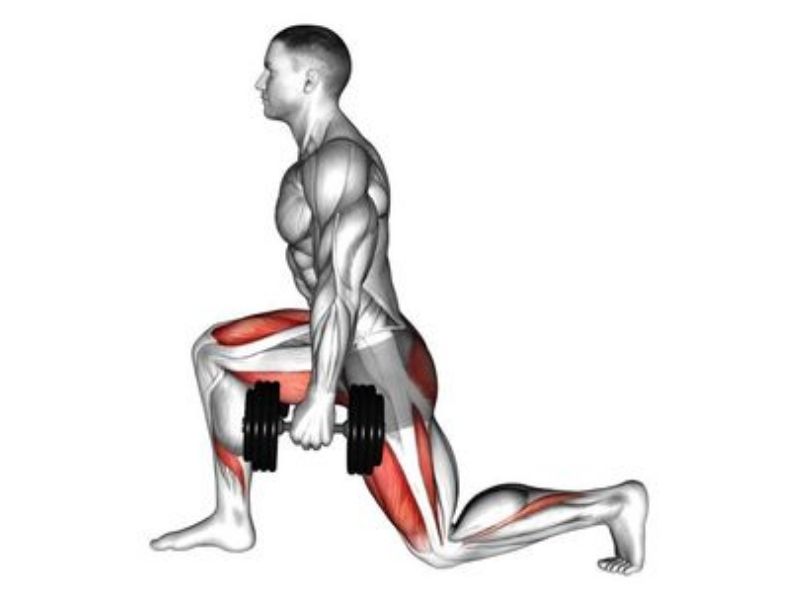
- Stand with your feet hip-width apart, holding a dumbbell in each hand at your sides.
- Take a step forward with one foot and lower your body until both knees are bent at a 90-degree angle, with your front thigh parallel to the ground.
- Ensure your front knee is aligned with your ankle and doesn’t extend past your toes.
- Push through your front heel to return to the starting position, then repeat on the other side.
Dumbbell Step-Ups:
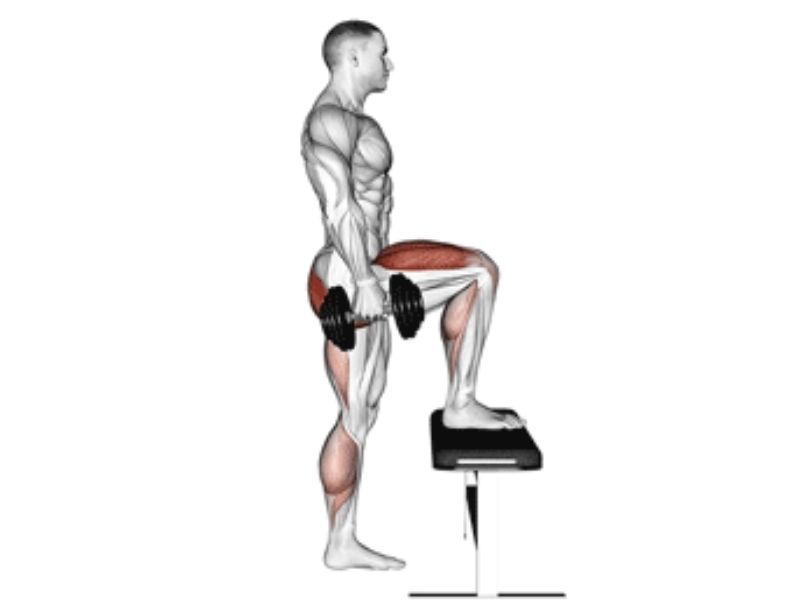
- Stand facing a sturdy bench or platform with a dumbbell in each hand at your sides.
- Place one foot on the bench, ensuring your entire foot is planted securely.
- Push through your heel to lift your body up onto the bench, fully extending your hip and knee.
- Step back down with control, returning to the starting position.
- Alternate legs with each repetition.
Dumbbell Deadlift:
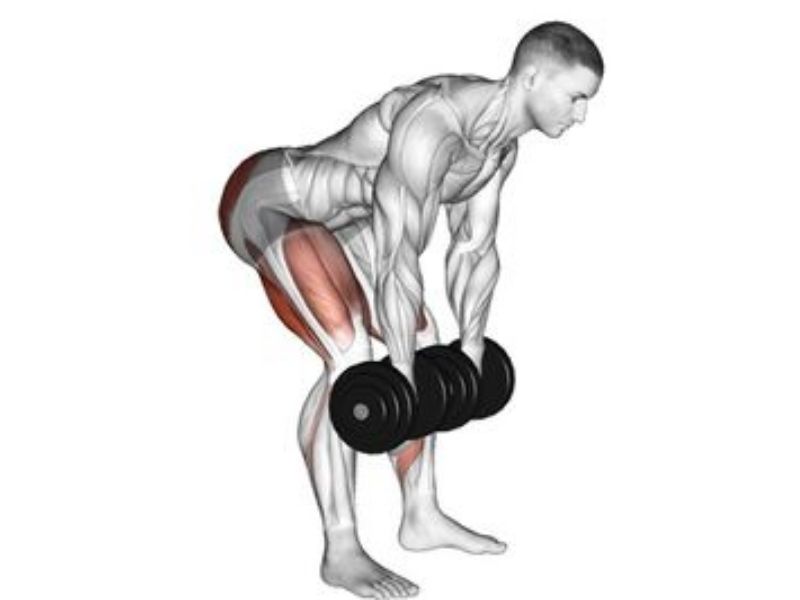
- Stand with your feet shoulder-width apart, holding a dumbbell in each hand in front of your thighs.
- Hinge at your hips and lower the dumbbells towards the ground while keeping your back straight and chest up.
- Lower the dumbbells until you feel a stretch in your hamstrings or until they reach mid-shin level.
- Push through your heels and squeeze your glutes to return to the starting position, fully extending your hips.
Bulgarian Split Squats:
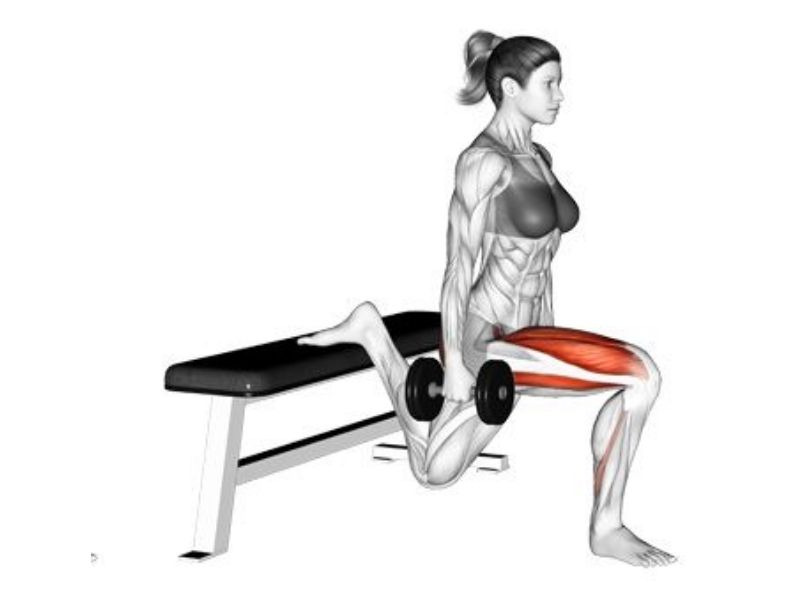
- Stand a couple of feet in front of a bench or platform with a dumbbell in each hand at your sides.
- Place the top of one foot on the bench behind you, with your other foot planted firmly on the ground.
- Lower your body straight down towards the ground by bending your front knee, keeping your torso upright.
- Lower down until your back knee nearly touches the ground, then push through your front heel to return to the starting position.
- Complete all repetitions on one leg before switching to the other leg.
Biceps:
Dumbbell Bicep Curls:
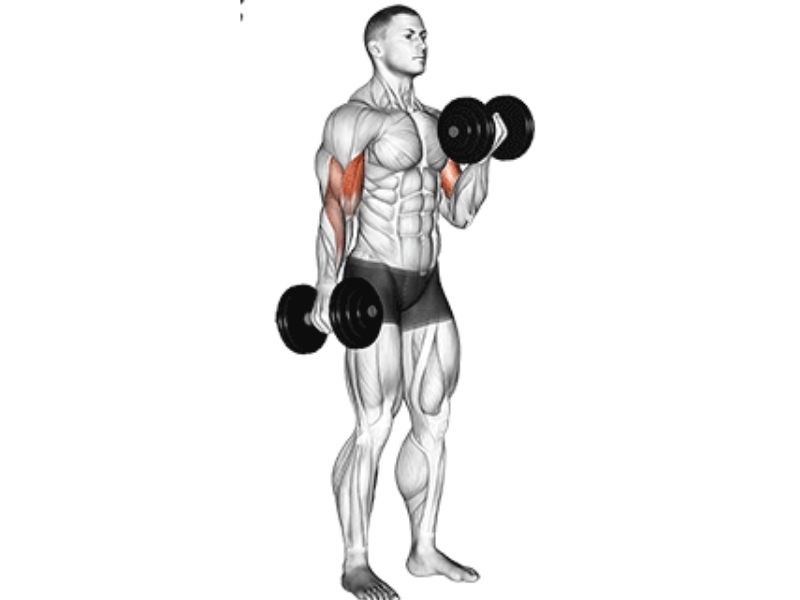
- Stand with your feet hip-width apart, holding a dumbbell in each hand at arm’s length by your sides, palms facing forward.
- Keep your elbows close to your torso and exhale as you curl the dumbbells towards your shoulders, contracting your biceps.
- Keep your upper arms stationary and only your forearms should move.
- Inhale as you lower the dumbbells back to the starting position with control, fully extending your arms.
Hammer Curls:

- Stand with your feet hip-width apart, holding a dumbbell in each hand at arm’s length by your sides, palms facing your body.
- Keep your elbows close to your torso and exhale as you curl the dumbbells towards your shoulders, keeping your palms facing each other throughout the movement.
- Keep your upper arms stationary and only your forearms should move.
- Inhale as you lower the dumbbells back to the starting position with control, fully extending your arms.
Concentration Curls:
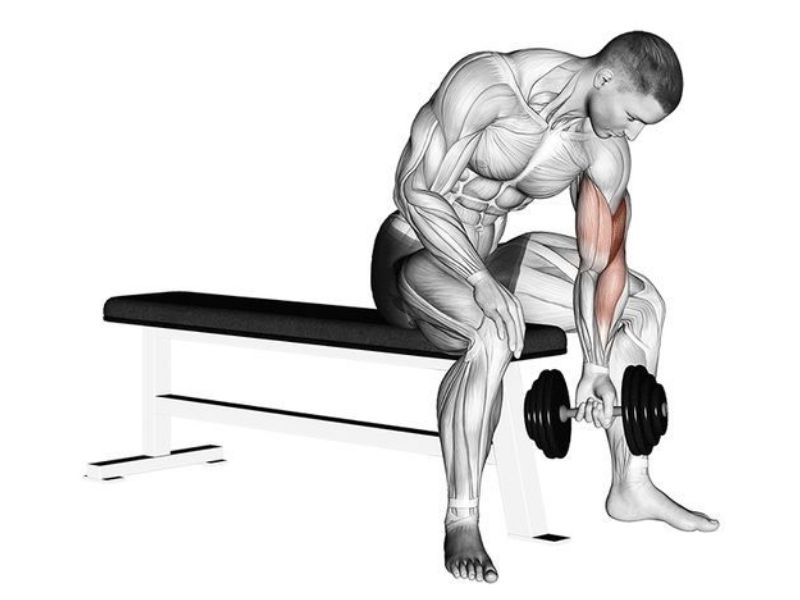
- Sit on a bench or chair with your feet flat on the floor, holding a dumbbell in one hand between your legs, palm facing up.
- Rest your elbow on the inside of your thigh, allowing the dumbbell to hang down towards the floor.
- Exhale as you curl the dumbbell towards your shoulder, keeping your upper arm stationary.
- Inhale as you lower the dumbbell back to the starting position with control.
Incline Dumbbell Curls:
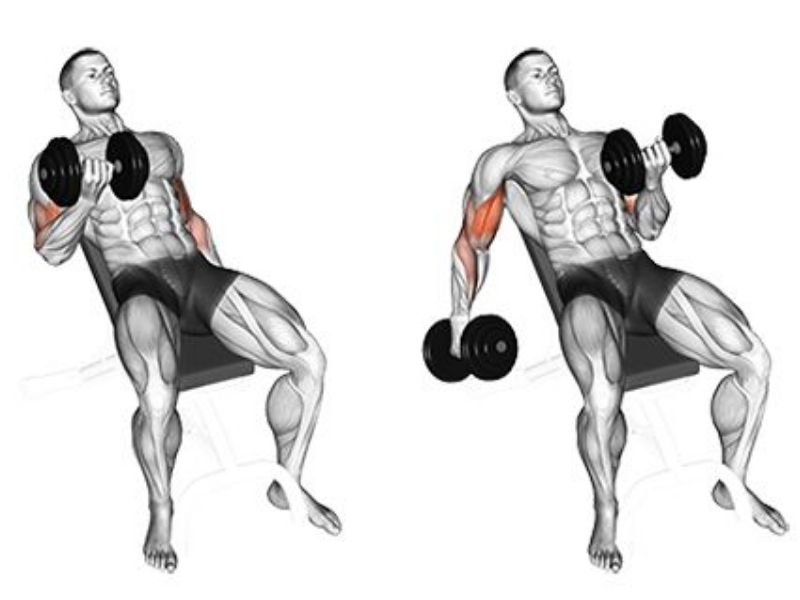
- Set an incline bench to a 45-degree angle and sit on it with a dumbbell in each hand, arms extended downwards and palms facing forward.
- Allow your arms to hang straight down towards the floor.
- Exhale as you curl the dumbbells towards your shoulders, keeping your upper arms stationary and elbows close to your torso.
- Inhale as you lower the dumbbells back to the starting position with control, fully extending your arms.
Dumbbell Preacher Curls:

- Sit on a preacher bench with your chest pressed against the pad and your arms extended over the pad, holding a dumbbell in each hand with palms facing up.
- Allow your arms to hang straight down towards the floor.
- Exhale as you curl the dumbbells towards your shoulders, keeping your upper arms pressed against the pad.
- Inhale as you lower the dumbbells back to the starting position with control, fully extending your arms.
Triceps:
Dumbbell Tricep Kickbacks:
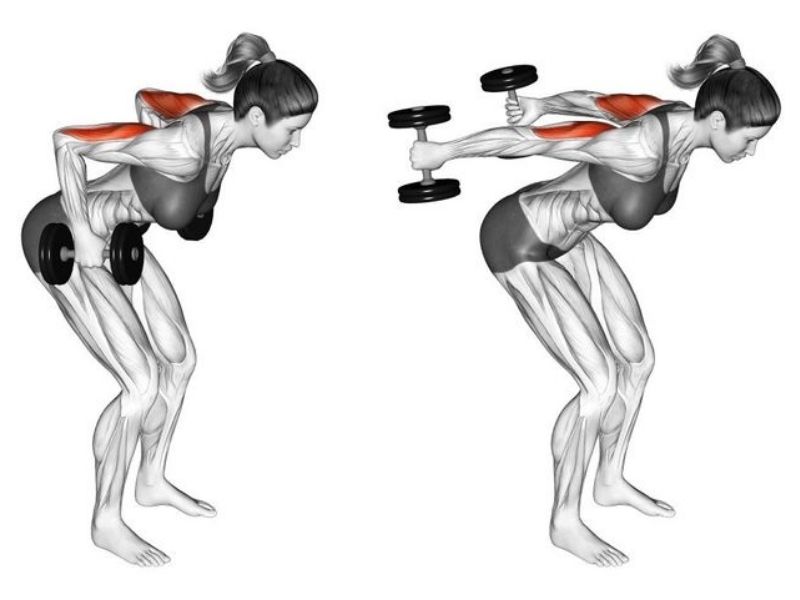
- Stand with your feet hip-width apart, holding a dumbbell in each hand.
- Bend your knees slightly and hinge forward at the hips, keeping your back straight and chest up.
- Hold the dumbbells with your palms facing inward, elbows bent at a 90-degree angle close to your torso.
- Exhale as you extend your arms backwards, straightening them behind you while keeping your elbows close to your body.
- Inhale as you slowly return the dumbbells to the starting position, maintaining control throughout the movement.
Overhead Dumbbell Tricep Extension:
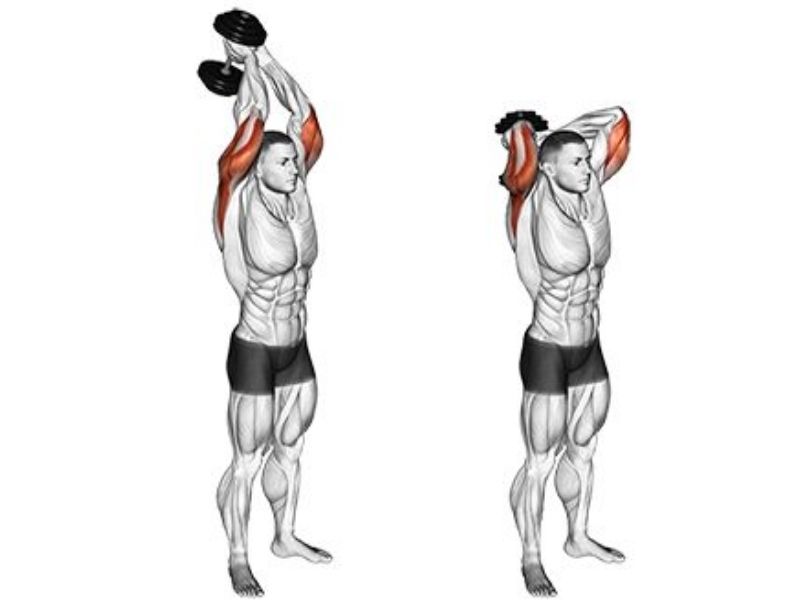
- Stand with your feet shoulder-width apart, holding a dumbbell with both hands overhead.
- Keep your elbows close to your head with your upper arms straight up.
- Exhale as you slowly lower the dumbbell behind your head, bending your elbows to about 90 degrees.
- Inhale as you extend your arms, raising the dumbbell back up to the starting position above your head.
Dumbbell Tricep Press:
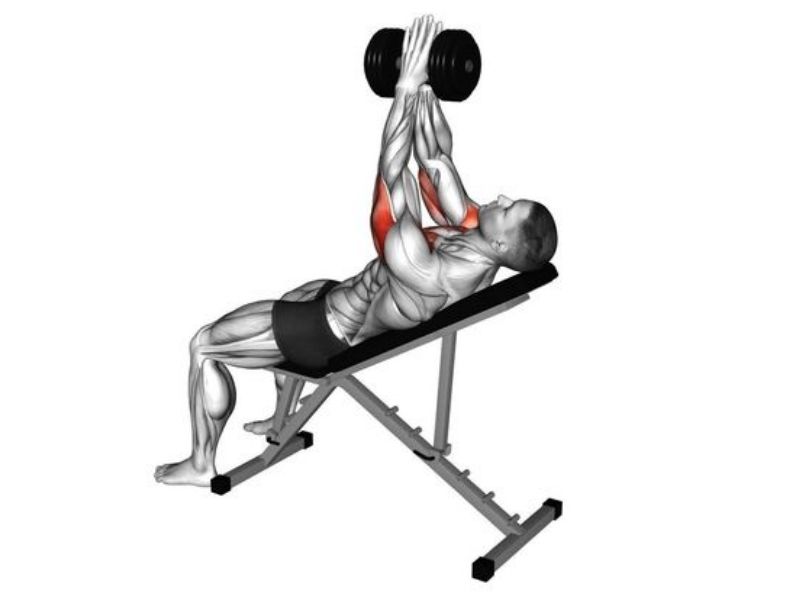
- Lie on a flat bench with a dumbbell in each hand, arms extended straight up towards the ceiling.
- Keep your palms facing each other and your elbows close to your sides.
- Exhale as you lower the dumbbells towards the sides of your chest, bending your elbows to about 90 degrees.
- Inhale as you press the dumbbells back up to the starting position, fully extending your arms.
Dumbbell Skull Crushers:
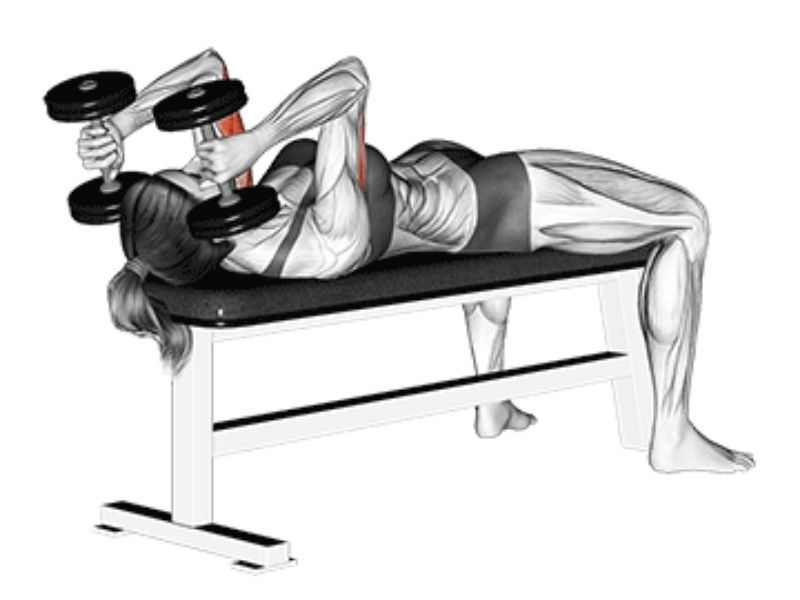
- Lie on a flat bench with a dumbbell in each hand, arms extended straight up towards the ceiling.
- Keep your palms facing each other and your elbows close to your sides.
- Exhale as you bend your elbows, lowering the dumbbells towards your temples.
- Inhale as you extend your arms, raising the dumbbells back up to the starting position above your head.
Tricep Dips with Dumbbells:
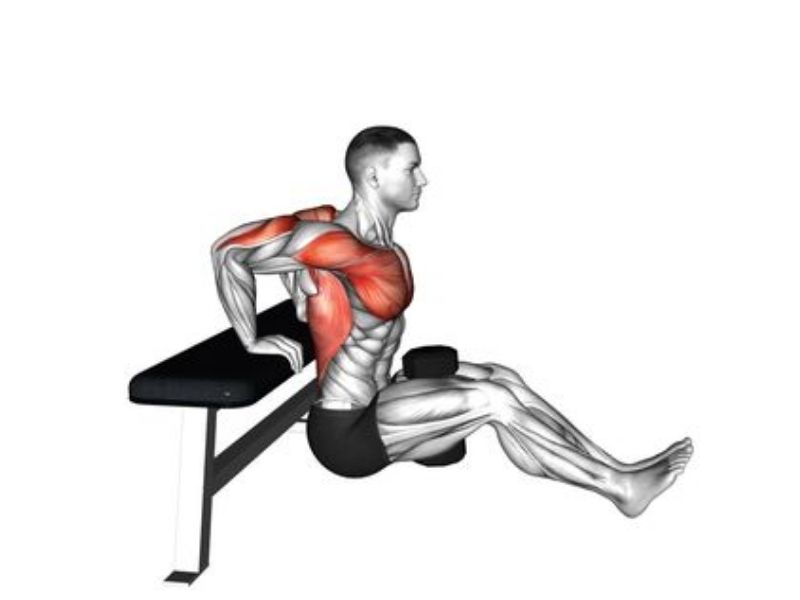
- Sit on the edge of a bench or chair with your hands gripping the edge beside your hips, fingers facing forward.
- Slide your hips off the edge of the bench and walk your feet out slightly in front of you.
- Keep your elbows pointing straight back as you lower your body towards the floor by bending your elbows.
- Exhale as you push yourself back up to the starting position, fully extending your arms.
- Inhale as you lower yourself back down, maintaining control throughout the movement.
Barbell exercises
Chest:
Barbell Bench Press:

- Lie flat on a bench with your feet firmly planted on the ground.
- Grip the barbell slightly wider than shoulder-width apart.
- Lower the barbell to your chest while keeping your elbows at a 45-degree angle.
- Press the barbell back up until your arms are fully extended, but do not lock your elbows.
Barbell Incline Bench Press:
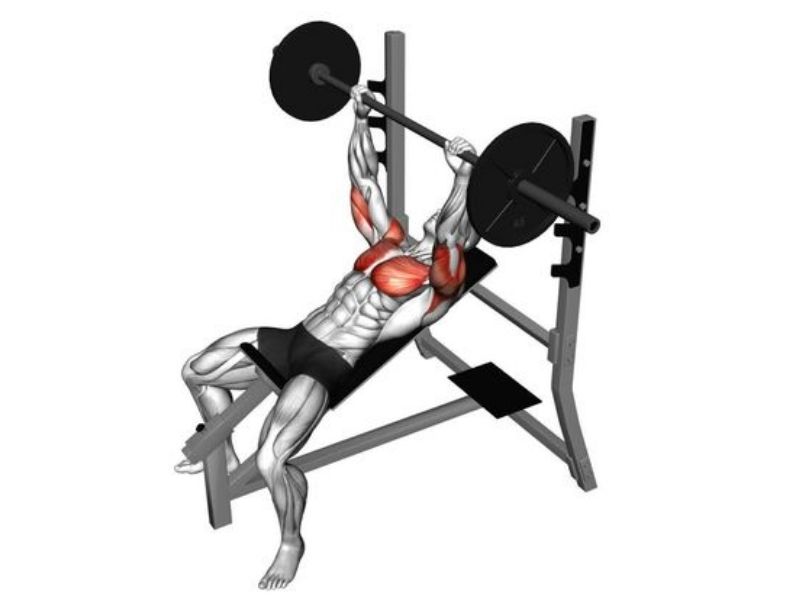
- Set the bench to a 30-45 degree angle.
- Lie back on the bench with the barbell racked above your upper chest.
- Grip the barbell slightly wider than shoulder-width apart.
- Lower the barbell to your chest, keeping your elbows at a 45-degree angle.
- Press the barbell back up until your arms are fully extended.
Barbell Decline Bench Press:

- Set the bench to a decline angle.
- Lie back on the bench with the barbell racked above your lower chest.
- Grip the barbell slightly wider than shoulder-width apart.
- Lower the barbell to your chest while keeping your elbows at a 45-degree angle.
- Press the barbell back up until your arms are fully extended.
Barbell Floor Press:
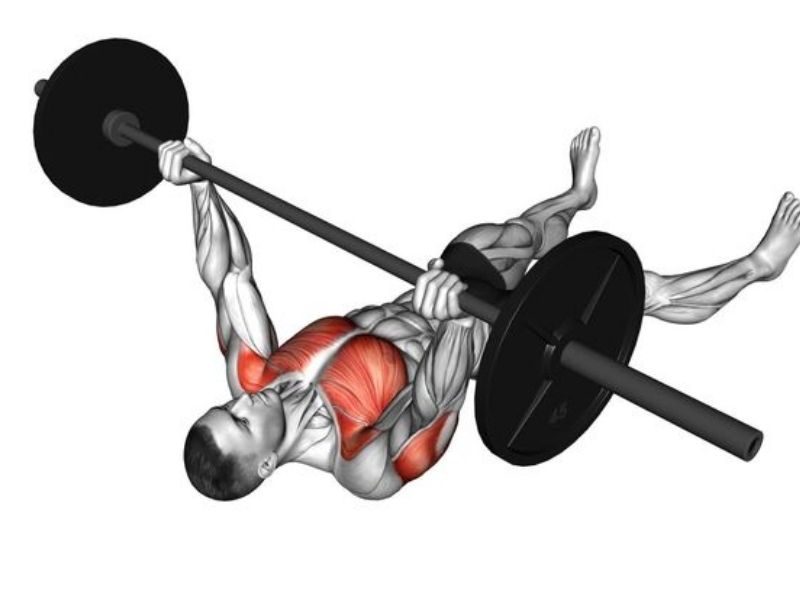
- Lie on the floor with your knees bent and feet flat.
- Grip the barbell with your hands shoulder-width apart.
- Press the barbell up until your arms are fully extended.
- Lower the barbell until your upper arms touch the floor, then press it back up.
Back:
Barbell Deadlift:
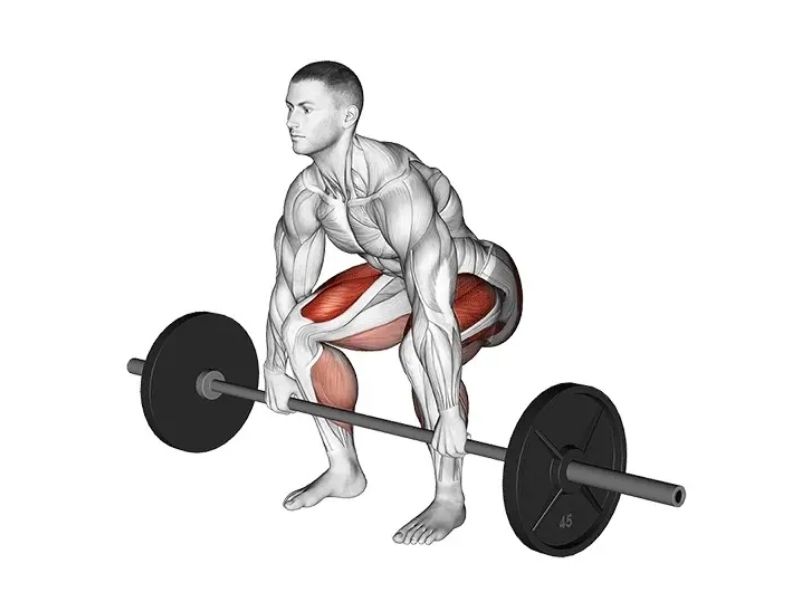
- Stand with your feet hip-width apart, with the barbell over your midfoot.
- Bend at your hips and knees to grip the barbell with both hands shoulder-width apart.
- Keep your back straight and chest up as you lift the barbell by extending your hips and knees.
- Stand tall with the barbell, then slowly lower it back down.
Barbell Bent-Over Rows:

- Stand with your feet hip-width apart, holding the barbell with an overhand grip.
- Bend forward at your hips while keeping your back straight and chest up.
- Pull the barbell towards your lower chest by bending your elbows and squeezing your shoulder blades together.
- Lower the barbell back down with control.
Barbell Pendlay Rows:
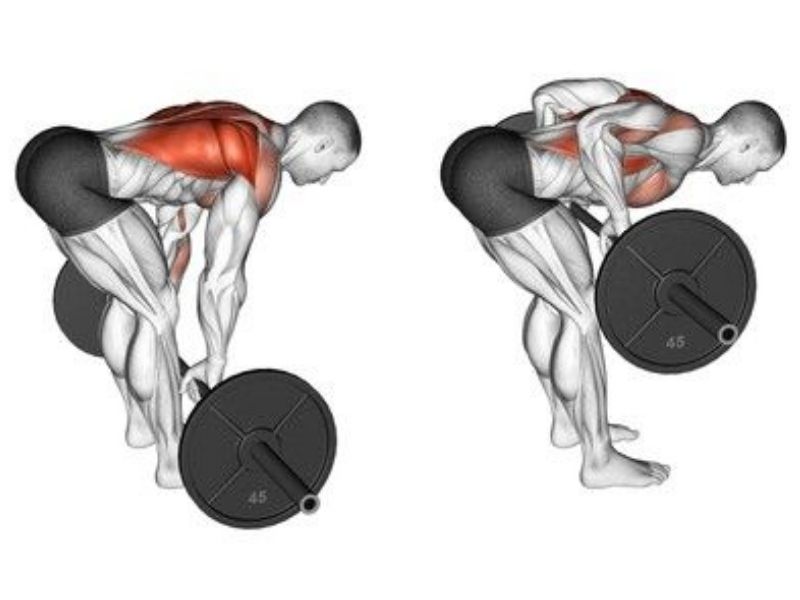
- Set up in a similar position to the Bent-Over Rows.
- Keep your back flat and chest up as you pull the barbell to your lower chest.
- Lower the barbell back down to the starting position, ensuring it touches the floor each time.
Shoulders:
Barbell Shoulder Press:
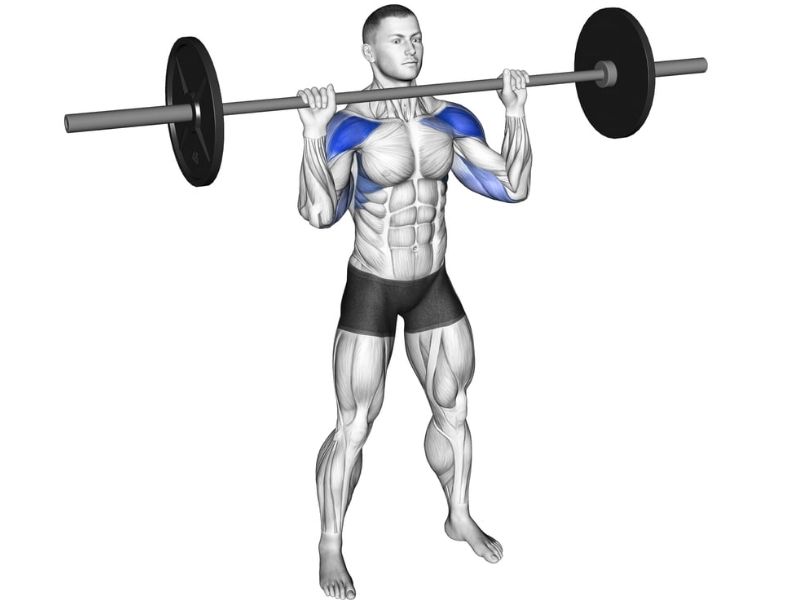
- Stand with your feet hip-width apart, holding the barbell at shoulder height with an overhand grip.
- Press the barbell overhead until your arms are fully extended.
- Lower the barbell back down to shoulder height with control.
Barbell Upright Rows:

- Stand with your feet hip-width apart, holding the barbell with an overhand grip, hands shoulder-width apart.
- Pull the barbell towards your chin by raising your elbows out to the sides.
- Lower the barbell back down to the starting position.
Barbell Front Raises:
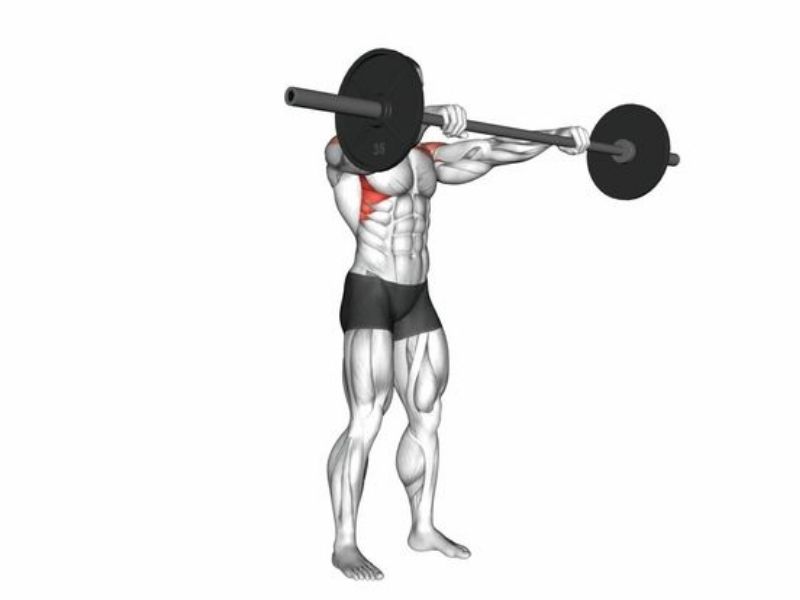
- Stand with your feet hip-width apart, holding the barbell with an overhand grip, arms extended in front of you.
- Raise the barbell directly in front of you until your arms are parallel to the floor.
- Lower the barbell back down with control.
Legs:
Barbell Squat:
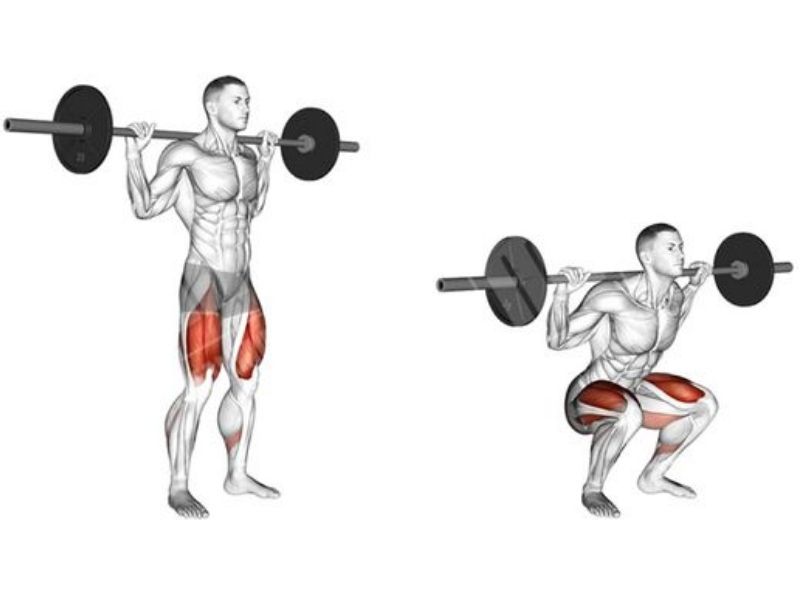
- Stand with your feet shoulder-width apart, holding the barbell across your upper back.
- Bend your knees and hips to lower your body until your thighs are parallel to the ground.
- Keep your chest up and back straight throughout the movement.
- Push through your heels to return to the starting position.
Barbell Romanian Deadlift:
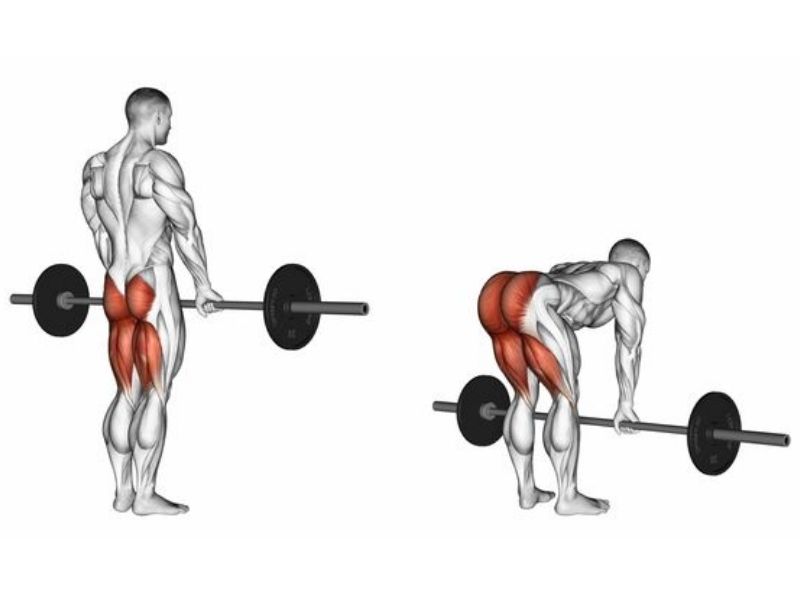
- Stand with your feet hip-width apart, holding the barbell in front of your thighs with an overhand grip.
- Hinge at your hips to lower the barbell towards the ground while keeping your back straight.
- Lower the barbell until you feel a stretch in your hamstrings, then return to the starting position by squeezing your glutes.
Barbell Front Squat:

- Hold the barbell across the front of your shoulders with your elbows up and in front of you.
- Lower into a squat position by bending your knees and hips, keeping your chest up and back straight.
- Descend until your thighs are parallel to the ground, then push through your heels to return to the starting position.
Barbell Lunges:
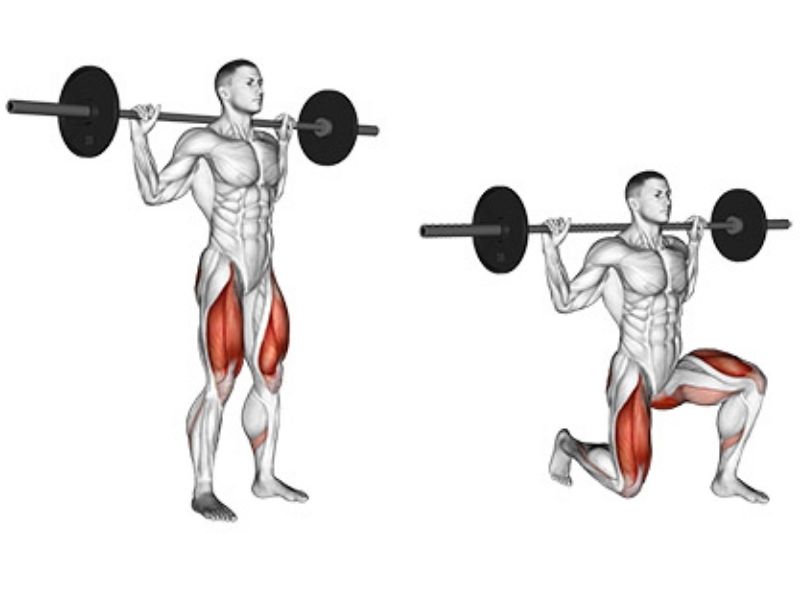
- Stand with your feet hip-width apart, holding the barbell across your upper back.
- Take a large step forward with one foot and lower your body until both knees are bent at a 90-degree angle.
- Keep your front knee aligned with your ankle and your back knee just above the ground.
- Push through your front heel to return to the starting position, then repeat on the other side.
Biceps:
Barbell Bicep Curls:
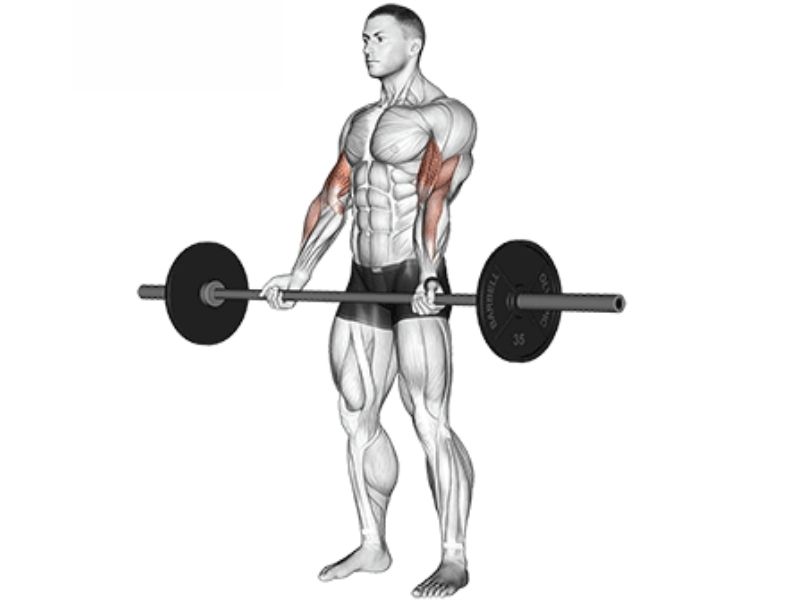
- Stand with your feet hip-width apart, holding the barbell with an underhand grip, arms fully extended.
- Curl the barbell towards your shoulders by bending your elbows.
- Keep your upper arms stationary and squeeze your biceps at the top of the movement.
- Lower the barbell back down with control.
Barbell Preacher Curls:
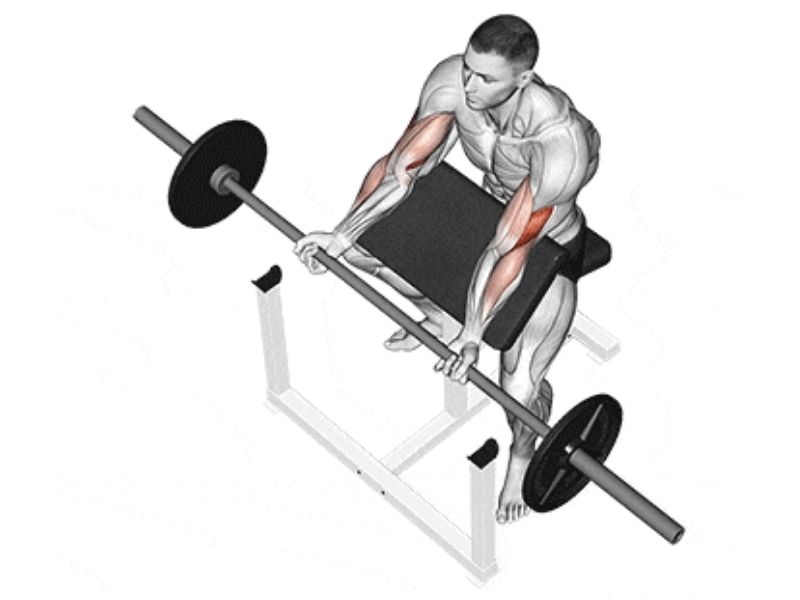
- Sit at a preacher curl bench with your upper arms resting on the pad and hold the barbell with an underhand grip.
- Curl the barbell towards your shoulders by bending your elbows.
- Keep your upper arms stationary throughout the movement.
- Lower the barbell back down with control.
Barbell Spider Curls:
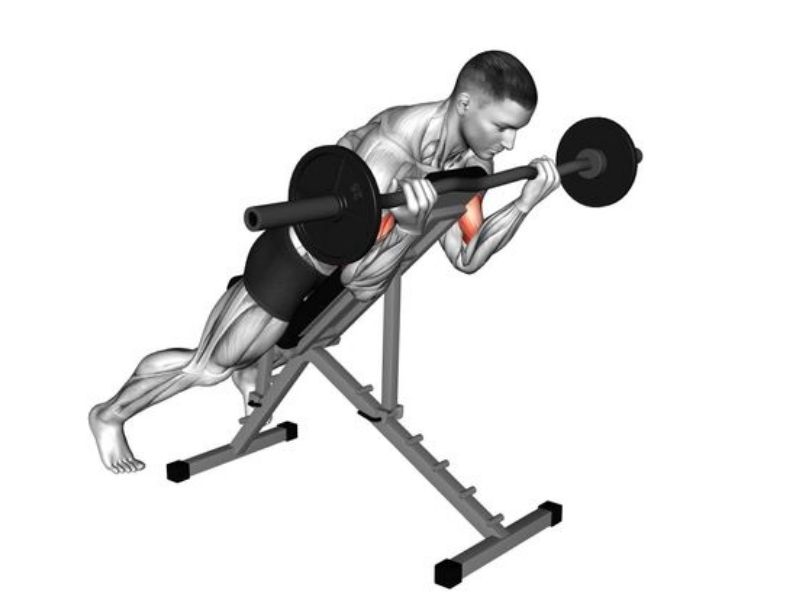
- Lie face down on an incline bench with your chest off the bench and hold the barbell with an underhand grip.
- Curl the barbell towards your shoulders by bending your elbows.
- Keep your upper arms stationary and squeeze your biceps at the top of the movement.
- Lower the barbell back down with control.
Barbell Concentration Curls:
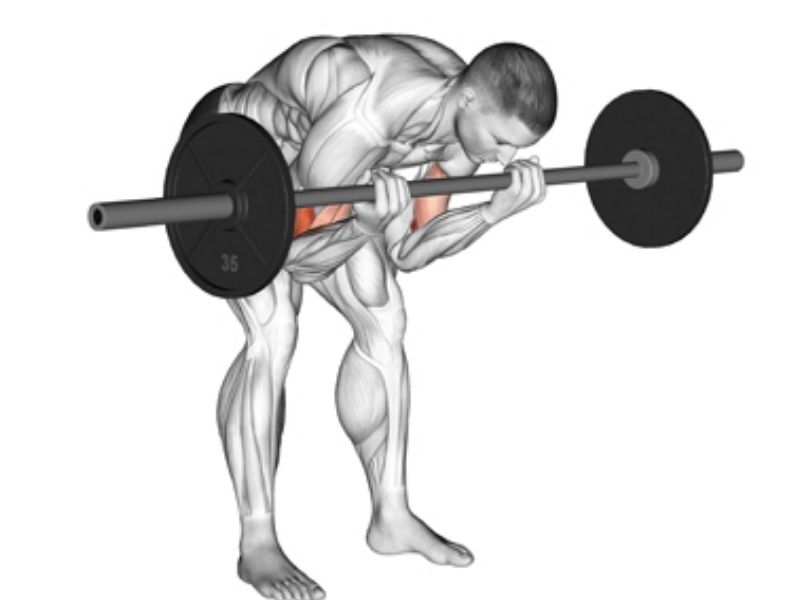
- Sit on a bench with your legs spread apart and hold the barbell with an underhand grip, resting your elbow on the inside of your thigh.
- Curl the barbell towards your shoulder by bending your elbow.
- Keep your upper arm stationary throughout the movement.
- Lower the barbell back down with control.
Triceps:
Barbell Overhead Triceps Extension:
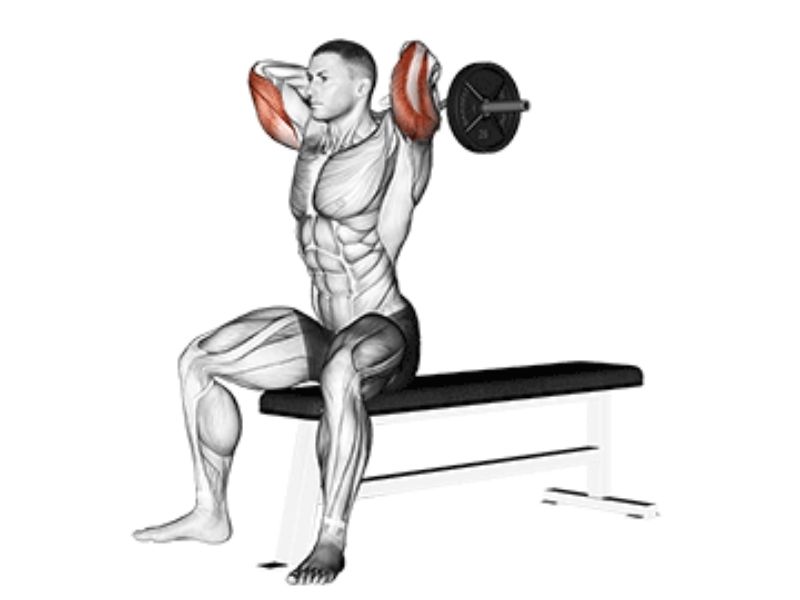
- Stand with your feet hip-width apart, holding the barbell with both hands overhead.
- Lower the barbell behind your head by bending your elbows.
- Keep your upper arms close to your head and elbows pointing forward.
- Extend your arms to raise the barbell back to the starting position.
Barbell Skull Crushers:
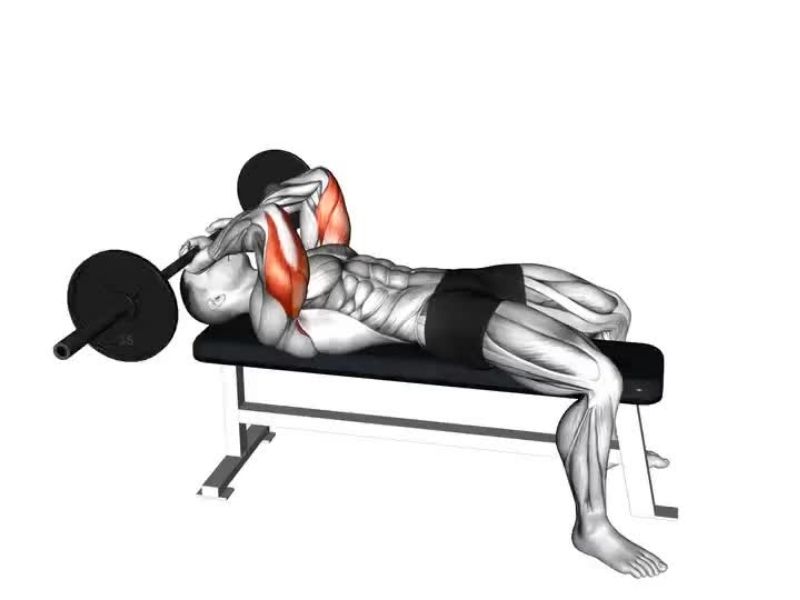
- Lie on a bench with your feet flat on the floor and hold the barbell with an overhand grip, arms extended towards the ceiling.
- Bend your elbows to lower the barbell towards your forehead.
- Keep your upper arms stationary and squeeze your triceps at the top of the movement.
- Extend your arms to raise the barbell back to the starting position.
Barbell Close-Grip Bench Press:

- Lie flat on a bench with your feet firmly planted on the ground, holding the barbell with a narrow grip.
- Lower the barbell towards your chest by bending your elbows.
- Keep your elbows close to your body throughout the movement.
- Press the barbell back up until your arms are fully extended.
Machine exercises
chest:
Flat Chest Press Machine:
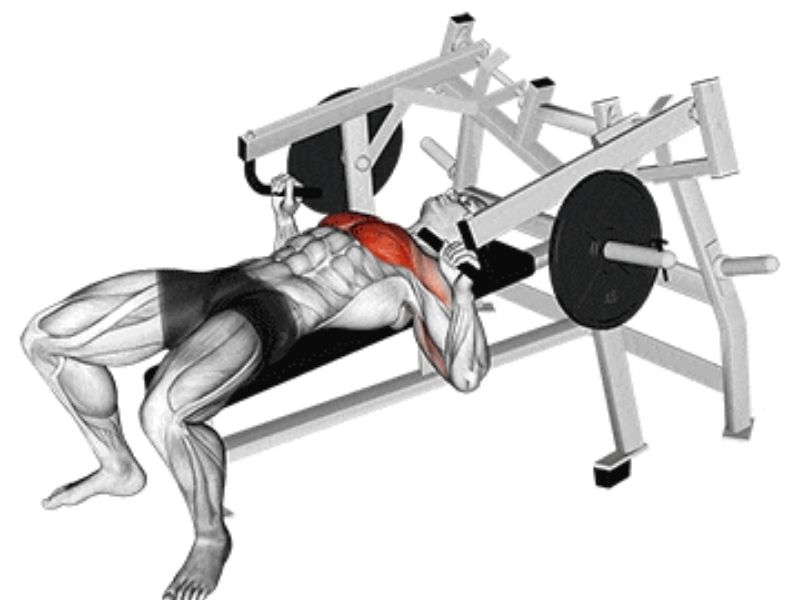
- Adjust the seat and handles of the machine so that the handles are at chest level when you’re seated.
- Sit on the machine with your back flat against the backrest and your feet flat on the floor.
- Grab the handles with an overhand grip, elbows bent at about 90 degrees.
- Exhale as you push the handles forward, extending your arms fully but without locking your elbows.
- Inhale as you slowly return the handles to the starting position, keeping your movements controlled.
Incline Chest Press Machine:
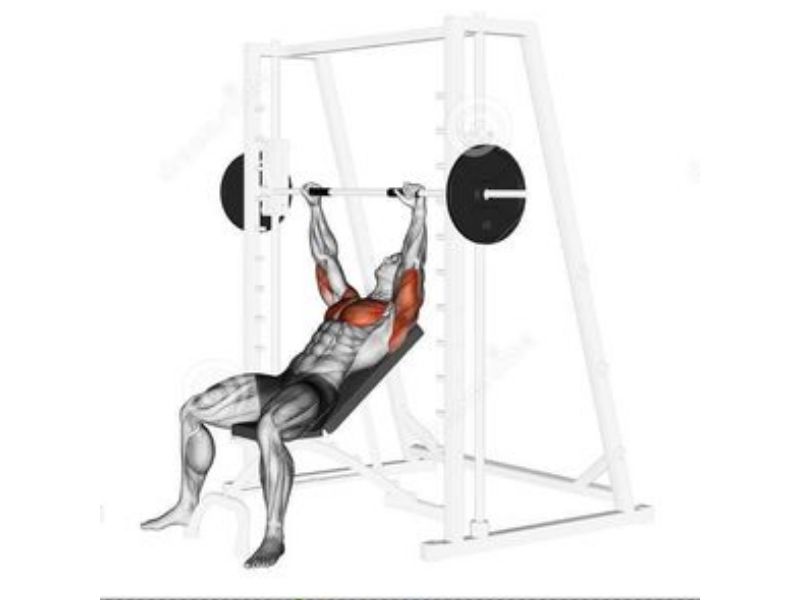
- Adjust the seat and handles of the machine so that the handles are slightly above chest level when you’re seated.
- Sit on the machine with your back against the backrest and your feet flat on the floor.
- Grab the handles with an overhand grip, elbows bent at about 90 degrees.
- Exhale as you push the handles upward and forward, extending your arms fully but without locking your elbows.
- Inhale as you slowly return the handles to the starting position, maintaining control throughout the movement.
Decline Chest Press Machine:
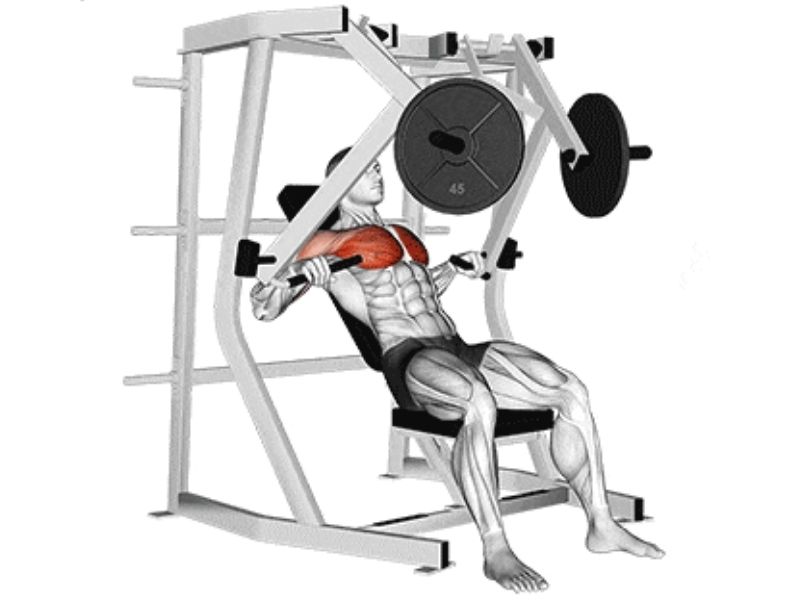
- Adjust the seat and handles of the machine so that the handles are slightly below chest level when you’re seated.
- Sit on the machine with your back against the backrest and your feet flat on the floor.
- Grab the handles with an overhand grip, elbows bent at about 90 degrees.
- Exhale as you push the handles downward and forward, extending your arms fully but without locking your elbows.
- Inhale as you slowly return the handles to the starting position, controlling the movement.
Pec Deck Machine:
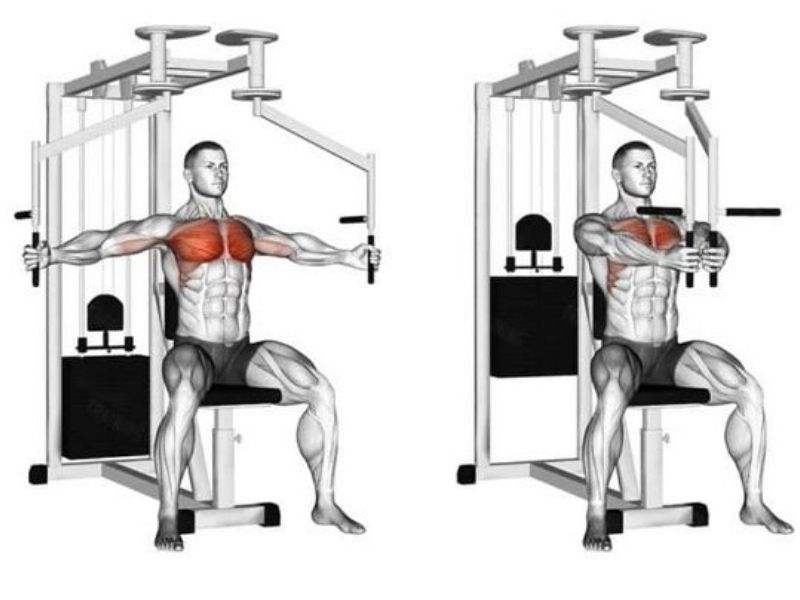
- Sit on the machine with your back against the backrest and your feet flat on the floor.
- Adjust the seat and handles so that your elbows are aligned with your shoulders when you grasp the handles.
- Grab the handles with an overhand grip, elbows bent at about 90 degrees.
- Exhale as you bring the handles together in front of your chest, squeezing your pecs.
- Inhale as you slowly return the handles to the starting position, feeling the stretch in your chest muscles.
Cable Chest Fly Machine:
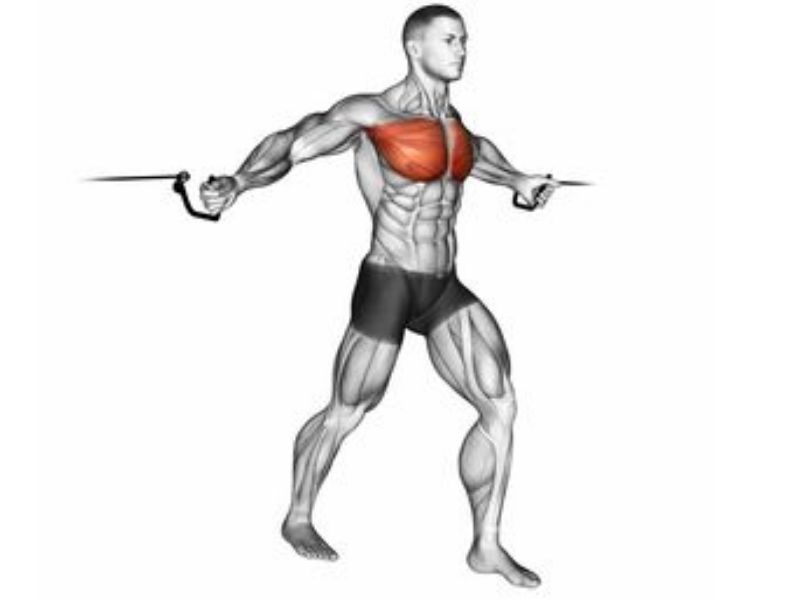
- Stand in the center of the cable machine with one foot slightly in front of the other for stability.
- Adjust the pulleys so that they are set at shoulder height or slightly below.
- Grasp the handles with an overhand grip, arms extended out to the sides.
- Exhale as you bring the handles together in front of your body, crossing them at chest level.
- Inhale as you slowly return the handles to the starting position, maintaining control throughout the movement.
Back:
Pull-Up Assist Machine:
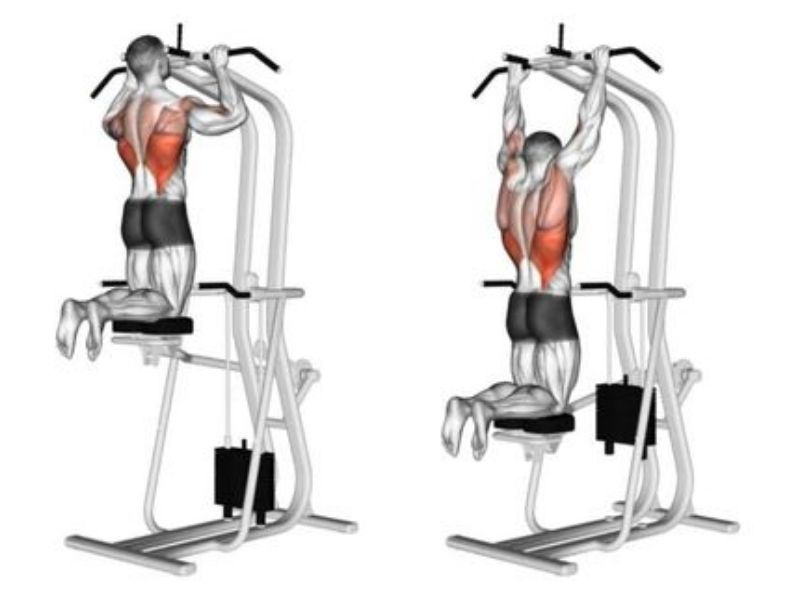
- Adjust the weight on the machine to your desired level.
- Step onto the platform or kneel on the pad provided by the machine.
- Grasp the handles with an overhand grip, hands slightly wider than shoulder-width apart.
- Engage your core and pull yourself up until your chin is above the bar.
- Lower yourself back down with control, keeping your movements smooth and controlled.
- Repeat for the desired number of repetitions.
Lat Pulldown Machine:

- Sit on the seat and adjust the thigh pad so that your thighs are secure.
- Grasp the bar with an overhand grip, hands wider than shoulder-width apart.
- Lean back slightly, keeping your chest up and shoulders down.
- Pull the bar down towards your chest, squeezing your shoulder blades together.
- Slowly release the bar back up to the starting position, maintaining control throughout the movement.
- Repeat for the desired number of repetitions.
Seated Cable Row Machine:
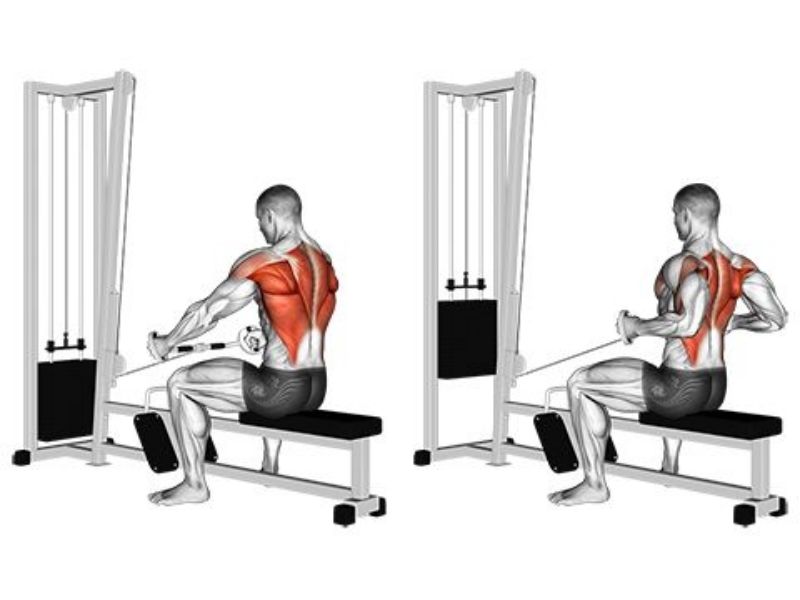
- Sit on the machine with your back straight and feet flat on the footplates.
- Grasp the handles with an overhand grip, hands shoulder-width apart.
- Keep your back straight and chest up as you pull the handles towards your torso.
- Squeeze your shoulder blades together at the end of the movement.
- Slowly release the handles back to the starting position, maintaining control.
- Repeat for the desired number of repetitions.
T-Bar Row Machine:
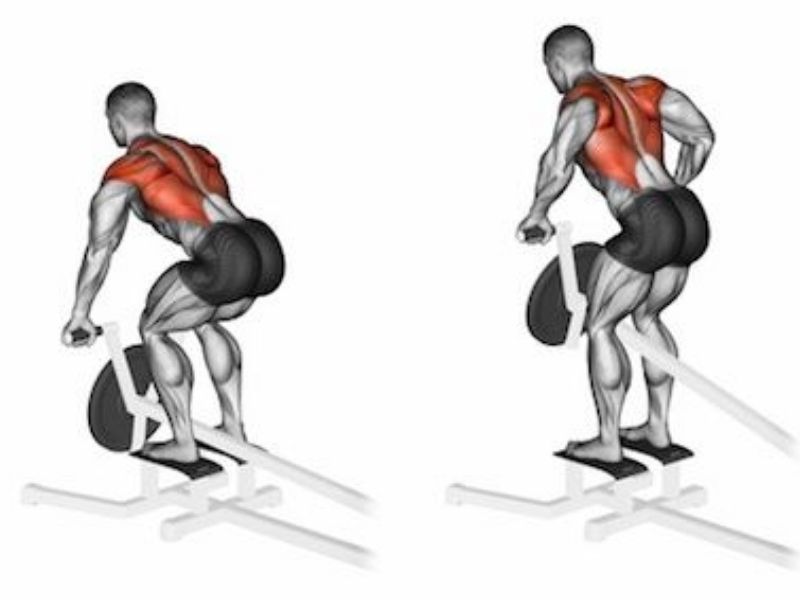
- Stand with your feet shoulder-width apart and knees slightly bent.
- Position yourself in front of the T-bar with your chest up and back straight.
- Grasp the handles with an overhand grip, hands shoulder-width apart.
- Pull the handles towards your torso, keeping your elbows close to your body.
- Squeeze your shoulder blades together at the end of the movement.
- Slowly lower the handles back to the starting position, controlling the descent.
- Repeat for the desired number of repetitions.
Machine Chest Supported Row:

- Adjust the seat and chest pad so that your chest is supported and your arms can fully extend.
- Grasp the handles with an overhand grip, hands shoulder-width apart.
- Keep your chest against the pad and your back straight as you pull the handles towards your torso.
- Squeeze your shoulder blades together at the end of the movement.
- Slowly release the handles back to the starting position, maintaining control.
- Repeat for the desired number of repetitions.
Shoulder:
Shoulder Press Machine:
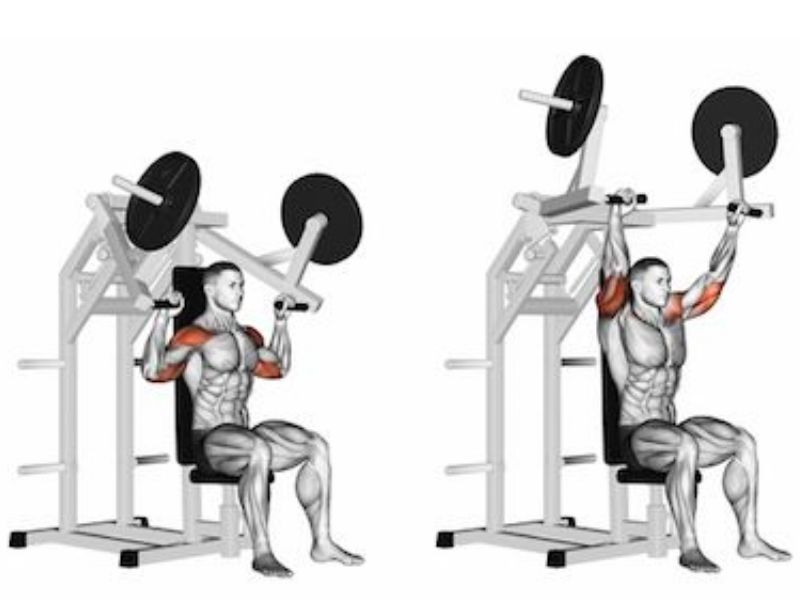
- Adjust the seat and handles so that the handles are at shoulder height.
- Sit on the machine with your back against the backrest and feet flat on the floor.
- Grasp the handles with an overhand grip, palms facing forward.
- Press the handles upward until your arms are fully extended overhead.
- Lower the handles back down to shoulder height with control.
- Repeat for the desired number of repetitions.
Lateral Raise Machine:
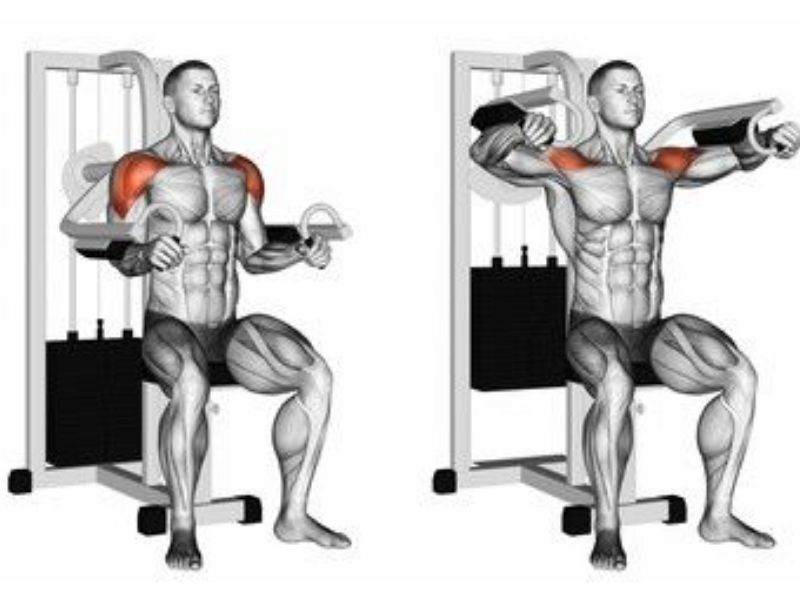
- Adjust the seat and handles so that the handles are at your sides.
- Sit on the machine with your back against the backrest and feet flat on the floor.
- Grasp the handles with a neutral grip, palms facing inward.
- Keep a slight bend in your elbows as you raise the handles out to the sides until they are at shoulder height.
- Pause briefly at the top of the movement.
- Lower the handles back down with control.
- Repeat for the desired number of repetitions.
Front Raise Machine:
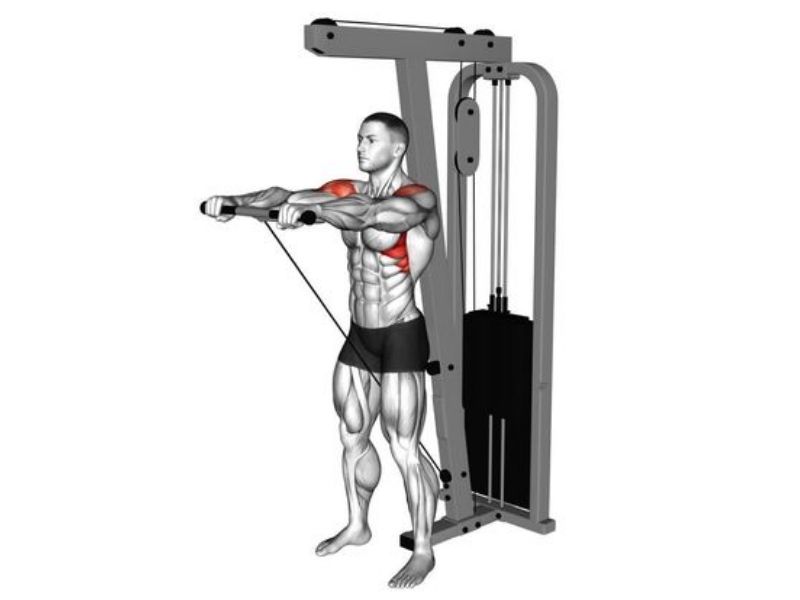
- Adjust the seat and handles so that the handles are in front of you.
- Sit on the machine with your back against the backrest and feet flat on the floor.
- Grasp the handles with an overhand grip, palms facing downward.
- Keep a slight bend in your elbows as you raise the handles straight out in front of you until they are at shoulder height.
- Pause briefly at the top of the movement.
- Lower the handles back down with control.
- Repeat for the desired number of repetitions.
Rear Deltoid Machine:

- Adjust the seat and handles so that the handles are behind you.
- Sit on the machine facing away from the handles with your chest against the pad and feet flat on the floor.
- Grasp the handles with an overhand grip, palms facing inward.
- Pull the handles backward and outward, squeezing your shoulder blades together.
- Pause briefly at the end of the movement.
- Return the handles to the starting position with control.
- Repeat for the desired number of repetitions.
Shoulder Shrug Machine:
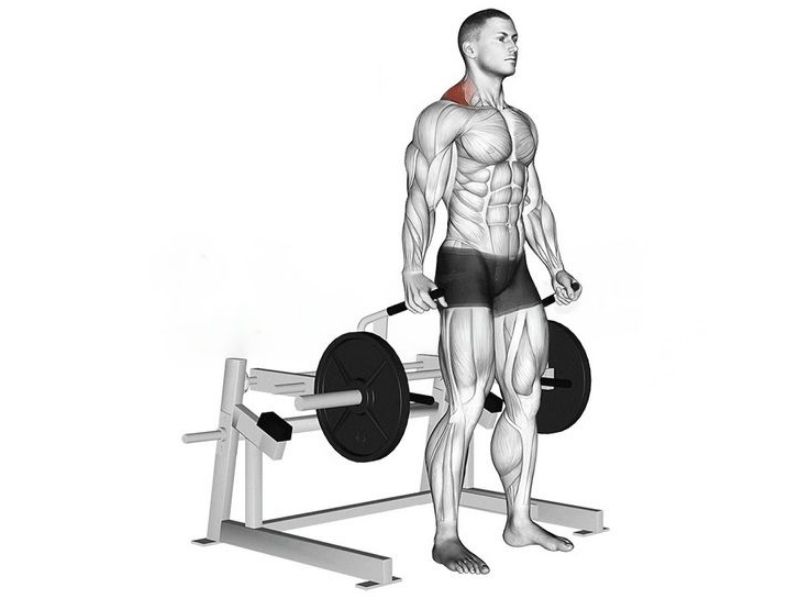
- Adjust the seat and handles so that the handles are in front of you.
- Sit on the machine with your back against the backrest and feet flat on the floor.
- Grasp the handles with an overhand grip, palms facing inward.
- Shrug your shoulders upward as high as possible, squeezing your traps at the top of the movement.
- Lower your shoulders back down with control.
- Repeat for the desired number of repetitions.
legs:
Leg Press Machine:

- Sit on the machine with your back against the backrest and feet flat on the footplate.
- Adjust the seat and footplate so that your knees are at a 90-degree angle when they are bent.
- Grasp the handles on the sides of the seat for stability.
- Push the footplate away from your body by straightening your legs until they are almost fully extended, but without locking your knees.
- Lower the footplate back down with control until your knees are at a 90-degree angle again.
- Repeat for the desired number of repetitions.
Leg Extension Machine:
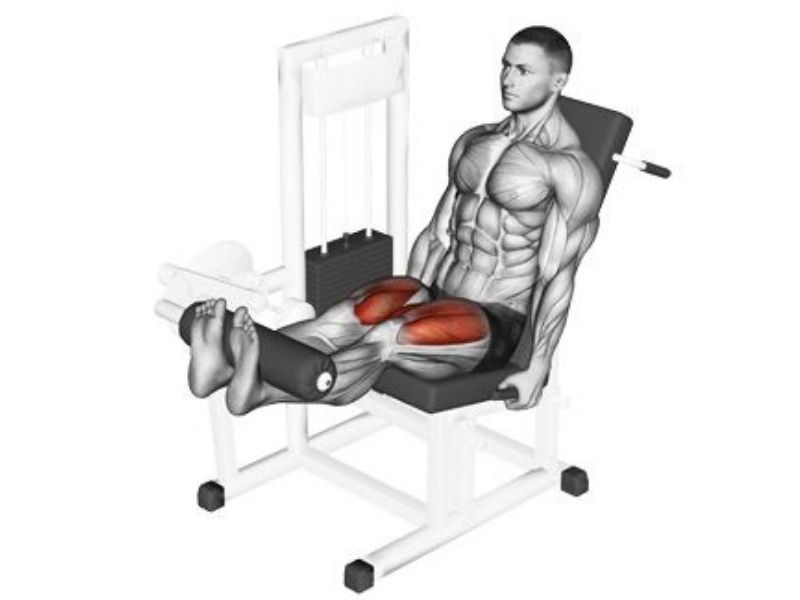
- Sit on the machine with your back against the backrest and feet hooked under the footpad.
- Adjust the seat and footpad so that the pad rests on your shins just above your ankles.
- Grasp the handles on the sides of the seat for stability.
- Extend your legs to lift the weight by straightening your knees until your legs are almost fully extended, but without locking them.
- Lower the weight back down with control until your knees are bent at a 90-degree angle.
- Repeat for the desired number of repetitions.
Leg Curl Machine:
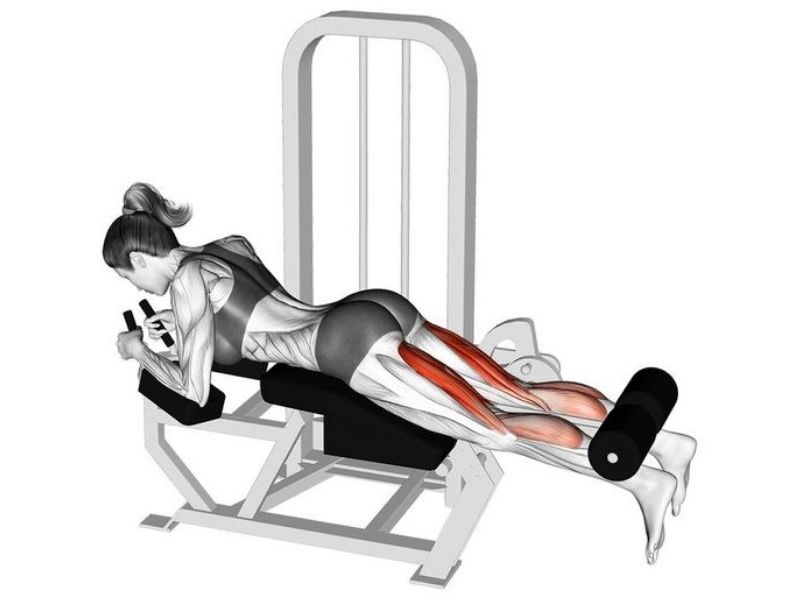
- Lie face down on the machine with your legs extended and the back of your ankles under the padded lever.
- Adjust the machine so that the lever is just above your heels.
- Grasp the handles or hold onto the sides of the machine for stability.
- Curl your legs upward by bending your knees and bringing your heels toward your glutes.
- Squeeze your hamstrings at the top of the movement.
- Lower the lever back down with control until your legs are extended.
- Repeat for the desired number of repetitions.
Hack Squat Machine:
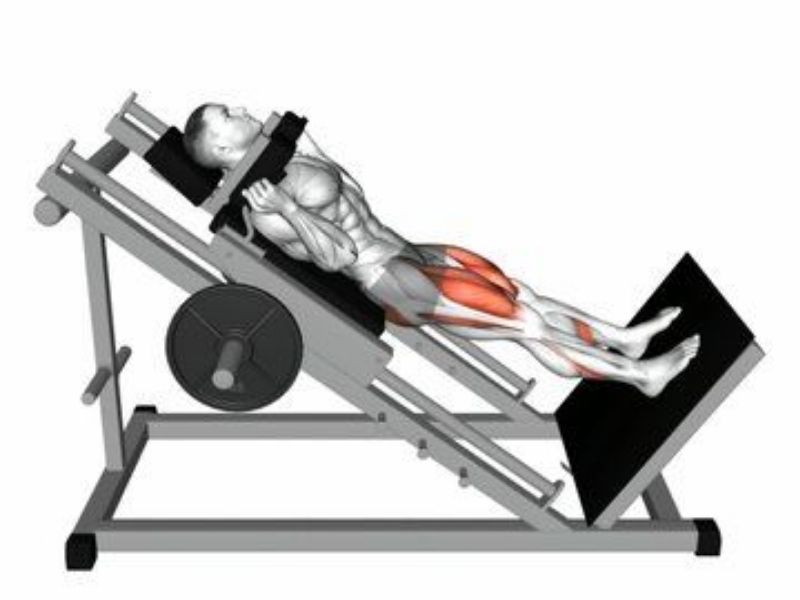
- Stand on the platform with your feet shoulder-width apart and your back against the backrest.
- Grasp the handles on the sides of the machine for stability.
- Lower your body by bending your knees while keeping your back straight until your thighs are parallel to the ground.
- Push through your heels to straighten your legs and return to the starting position.
- Repeat for the desired number of repetitions.
Calf Raise Machine:
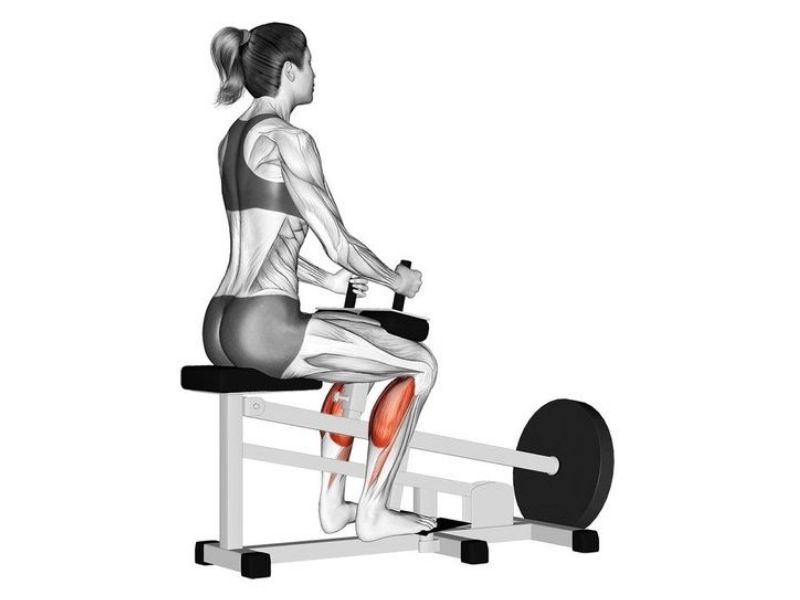
- Stand on the platform with the balls of your feet on the edge and your heels hanging off.
- Grasp the handles on the sides of the machine for stability.
- Rise up onto your toes by pushing through the balls of your feet until you’re on your tiptoes.
- Lower your heels back down below the level of the platform with control.
- Repeat for the desired number of repetitions.
Biceps:
Bicep Curl Machine:
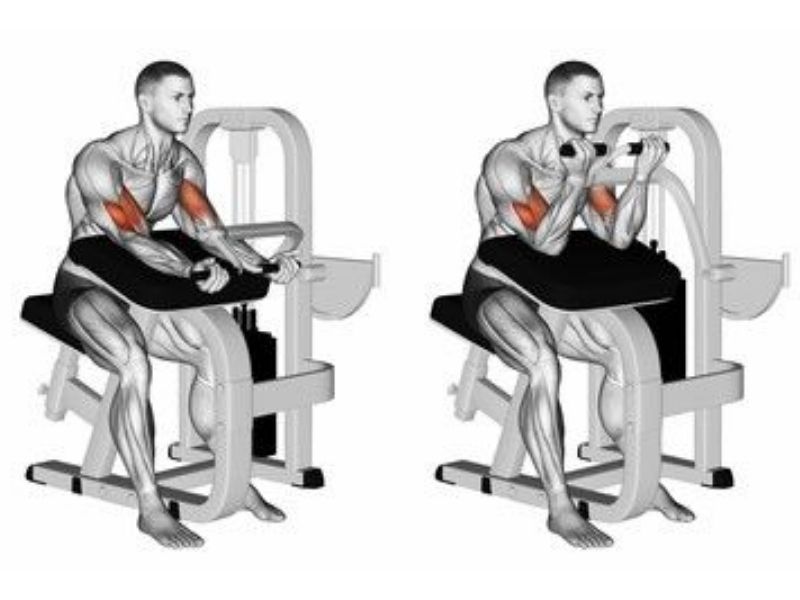
- Sit on the machine with your back against the backrest and grasp the handles with an underhand grip.
- Adjust the seat height so that your upper arms are positioned flat against the pad.
- Keep your elbows tucked at your sides and exhale as you curl the handles upward towards your shoulders.
- Hold the contraction briefly at the top of the movement, then inhale as you slowly lower the handles back down.
Cable Bicep Curl Machine:
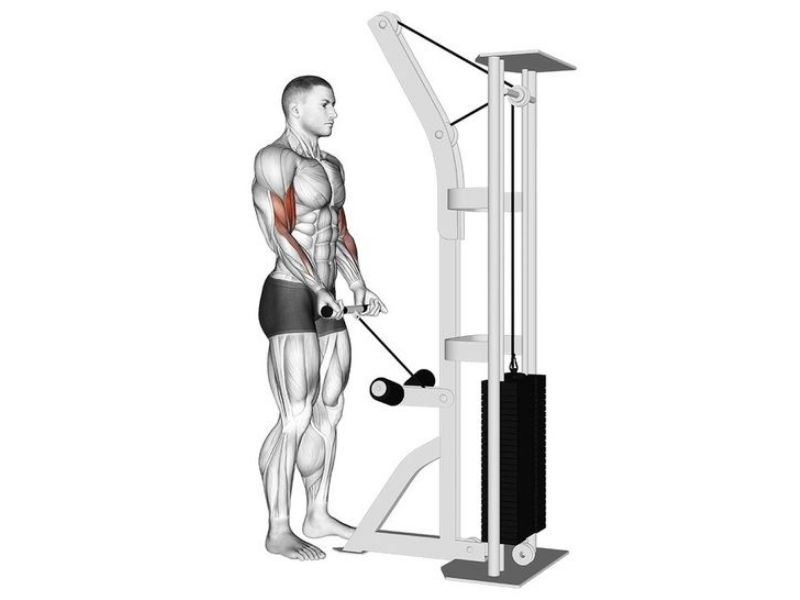
- Stand facing the cable machine with your feet shoulder-width apart and grasp the handles with an underhand grip.
- Keep your elbows tucked at your sides and exhale as you curl the handles upward towards your shoulders.
- Hold the contraction briefly at the top of the movement, then inhale as you slowly lower the handles back down.
- Keep your core engaged and avoid swinging your body during the exercise.
Preacher Curl Machine:
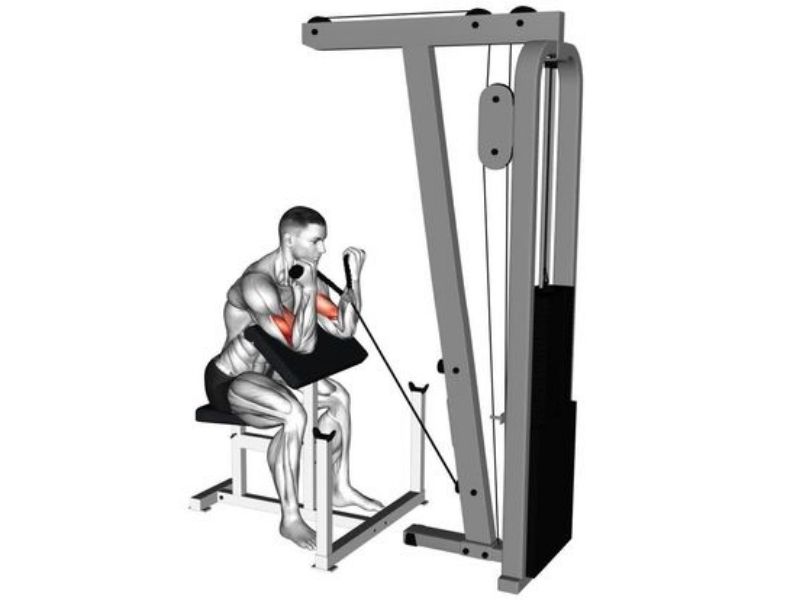
- Sit on the preacher curl machine with your chest against the pad and your upper arms positioned flat against the pad.
- Grasp the handles with an underhand grip, keeping your elbows tucked at your sides.
- Exhale as you curl the handles upward towards your shoulders, maintaining tension in your biceps.
- Hold the contraction briefly at the top of the movement, then inhale as you slowly lower the handles back down.
- Keep your back straight and avoid using momentum to lift the weight.
Hammer Curl Machine:
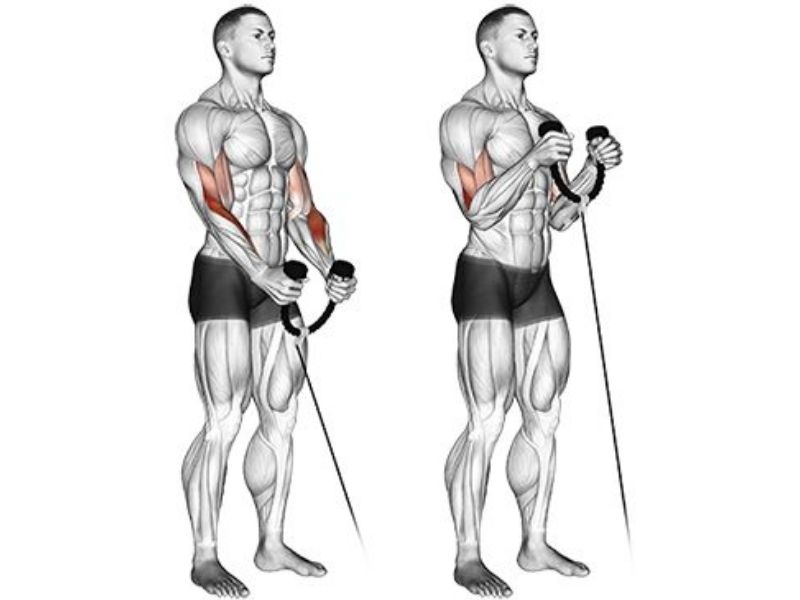
- Sit on the machine with your back against the backrest and grasp the handles with a neutral grip (palms facing each other).
- Keep your elbows tucked at your sides and exhale as you curl the handles upward towards your shoulders.
- Hold the contraction briefly at the top of the movement, then inhale as you slowly lower the handles back down.
- Maintain control throughout the exercise and avoid swinging the weights.
Concentration Curl Machine:

- Sit on the machine with your chest against the pad and your upper arm positioned flat against the pad.
- Grasp the handle with an underhand grip and fully extend your arm downward.
- Exhale as you curl the handle upward towards your shoulder, keeping your elbow stationary against the pad.
- Hold the contraction briefly at the top of the movement, then inhale as you slowly lower the handle back down.
- Keep your back straight and avoid using momentum to lift the weight.
Triceps:
Tricep Pushdown Machine:
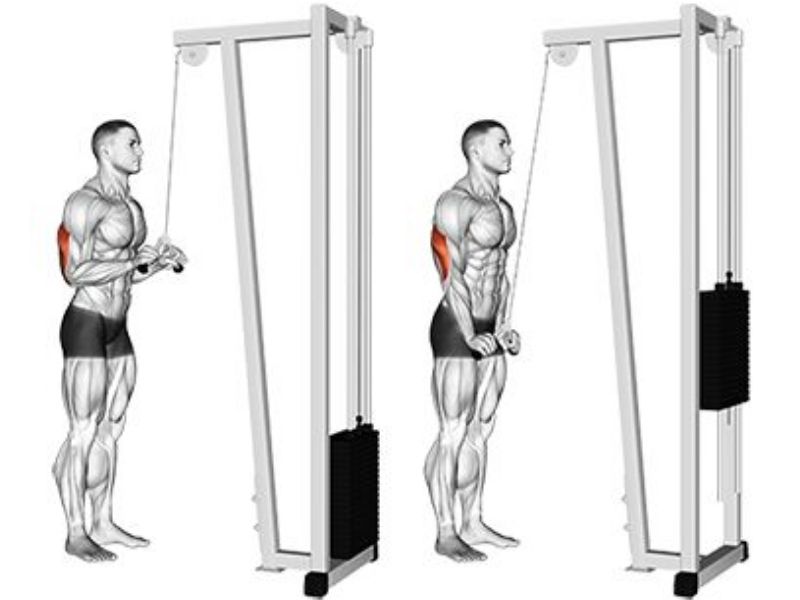
- Stand facing the machine with your feet shoulder-width apart and grasp the handles with an overhand grip.
- Keep your elbows close to your sides and exhale as you push the handles downward until your arms are fully extended.
- Hold the contraction briefly at the bottom of the movement, then inhale as you slowly return to the starting position.
- Keep your core engaged and avoid arching your back during the exercise.
Tricep Dip Machine:

- Sit on the machine with your back against the backrest and grasp the handles with an overhand grip.
- Keep your elbows close to your sides and your feet flat on the floor.
- Exhale as you push down on the handles to lift your body upward until your arms are fully extended.
- Hold the contraction briefly at the top of the movement, then inhale as you slowly lower your body back down.
- Avoid locking out your elbows at the top of the movement and maintain control throughout.
lying tricep extension:
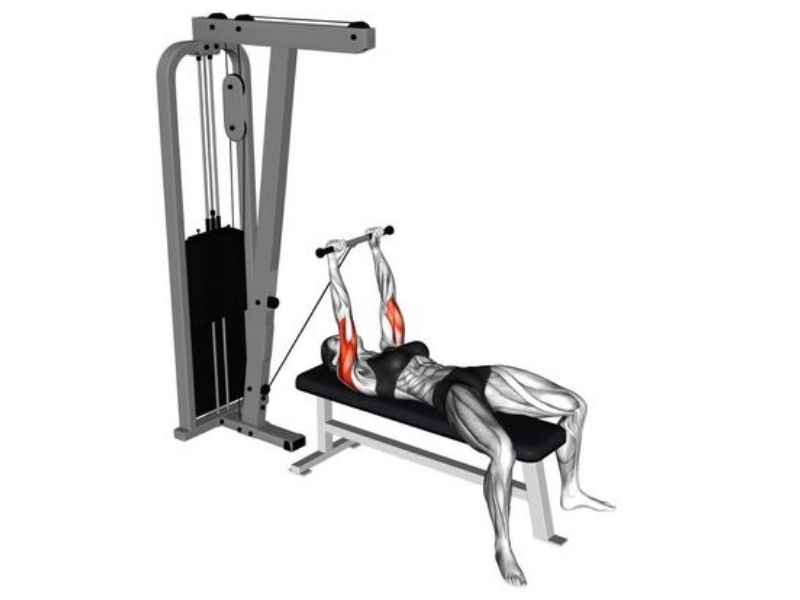
- Lie flat on a bench with a barbell held above your chest, arms fully extended.
- Bend your elbows to lower the barbell towards your forehead.
- Extend your arms to raise the barbell back to the starting position.
Overhead Tricep Extension Machine:
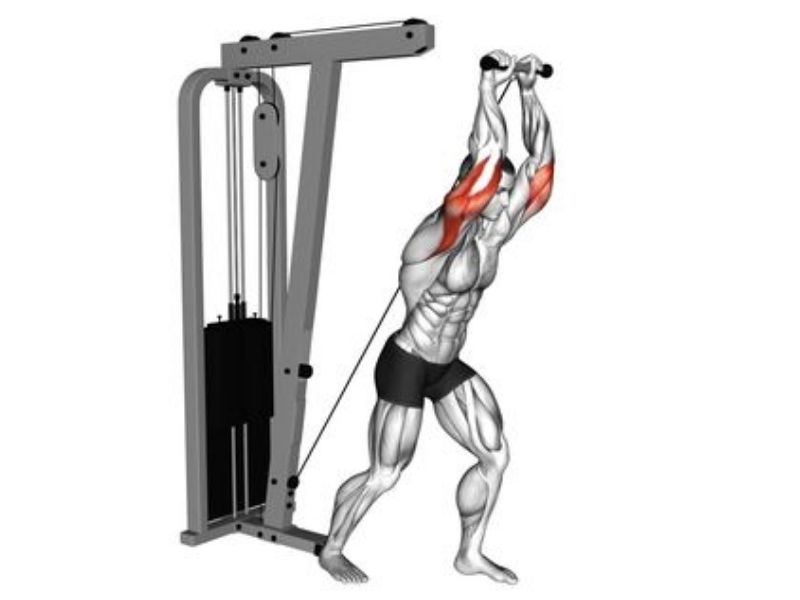
- Sit on the machine with your back against the backrest and grasp the handles with an overhand grip.
- Fully extend your arms overhead and keep your elbows close to your head.
- Exhale as you lower the handles behind your head until your elbows reach a 90-degree angle.
- Hold the contraction briefly, then inhale as you extend your arms back to the starting position.
- Keep your core engaged and avoid arching your back during the exercise.
Cable Tricep Kickback Machine:

- Stand facing the machine with your feet shoulder-width apart and grasp the handle with an overhand grip.
- Step back to create tension in the cable and hinge forward at the hips, keeping your back flat.
- Keep your elbow close to your side and exhale as you extend your arm backward until it is fully straight.
- Hold the contraction briefly, then inhale as you return to the starting position.
- Keep your core engaged and avoid swinging your arm during the exercise.
Resistance band
Chest:
Resistance Band Chest Press:
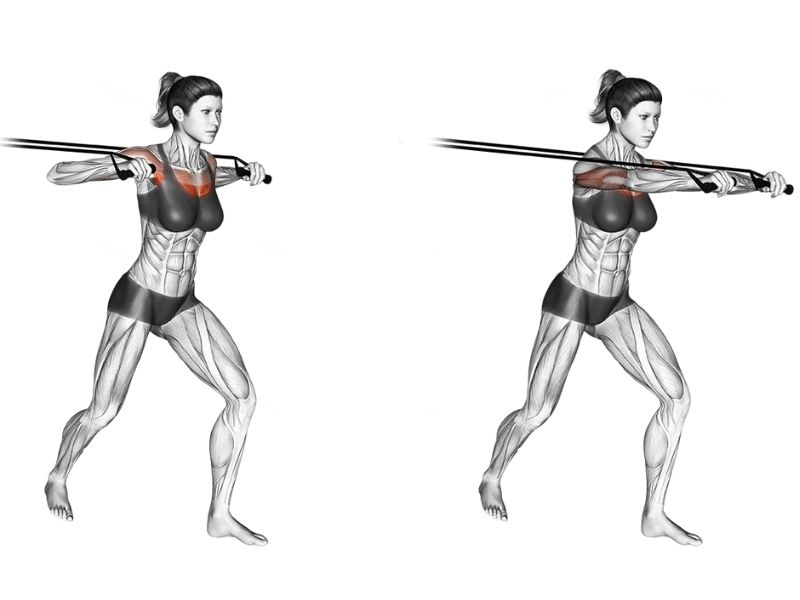
- Attach the resistance band to a secure anchor point at chest height.
- Stand facing away from the anchor point and hold the handles with an overhand grip.
- Step forward to create tension in the band, then press the handles forward until your arms are fully extended.
- Exhale as you push, and hold the contraction briefly at the end of the movement.
- Inhale as you slowly return to the starting position, maintaining control throughout.
Resistance Band Chest Fly:
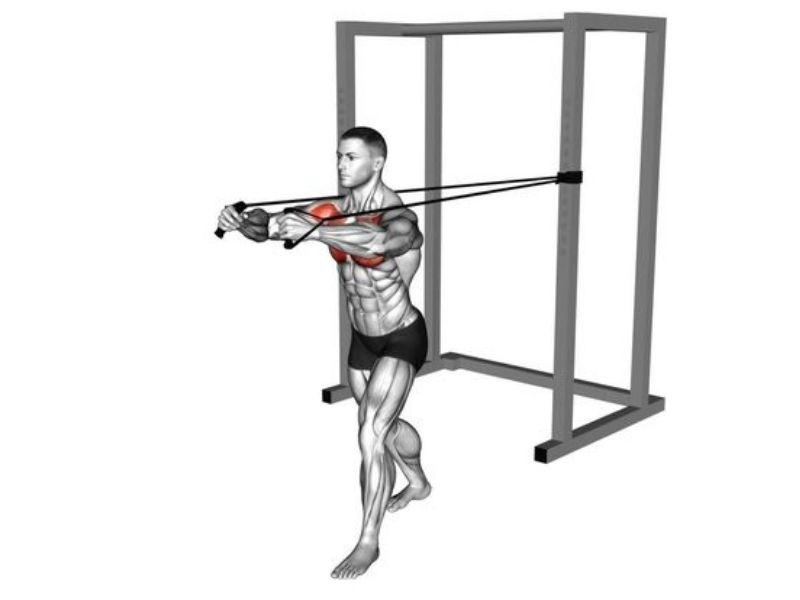
- Attach the resistance band to a secure anchor point at chest height.
- Stand facing away from the anchor point and hold the handles with an overhand grip.
- Step forward to create tension in the band, then bring your arms together in front of you.
- Exhale as you squeeze your chest muscles, and hold the contraction briefly.
- Inhale as you slowly return to the starting position, maintaining control throughout.
Resistance Band Push-Up:
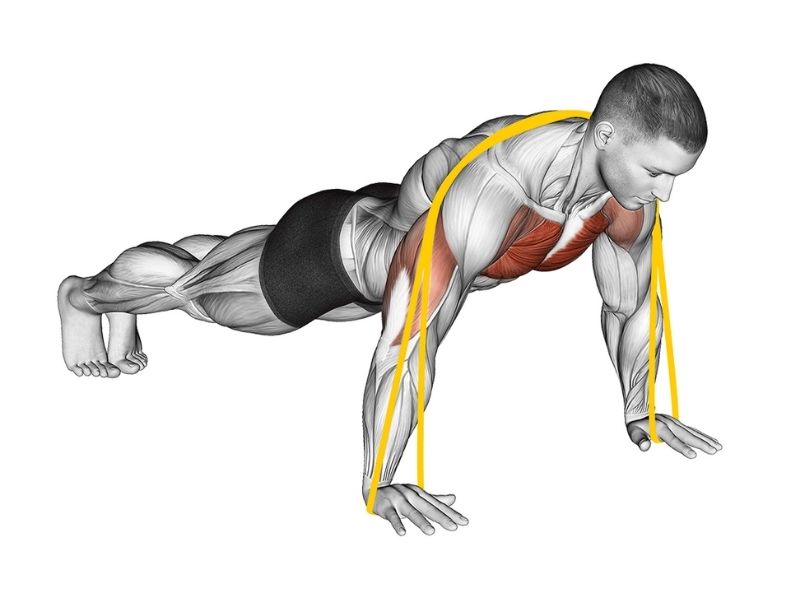
- Place the resistance band across your upper back and hold the ends in each hand.
- Get into a push-up position with your hands shoulder-width apart and feet together.
- Lower your chest towards the floor, keeping your body in a straight line.
- Exhale as you push back up to the starting position, extending your arms fully.
- Inhale as you lower back down, maintaining control throughout.
Resistance Band Incline Chest Press:

- Anchor the resistance band at a low point behind you.
- Sit on an incline bench facing away from the anchor point.
- Hold the resistance band handles with an overhand grip, hands shoulder-width apart.
- Press the handles forward until your arms are fully extended.
- Slowly return to the starting position under control.
Back:
Resistance Band Row:
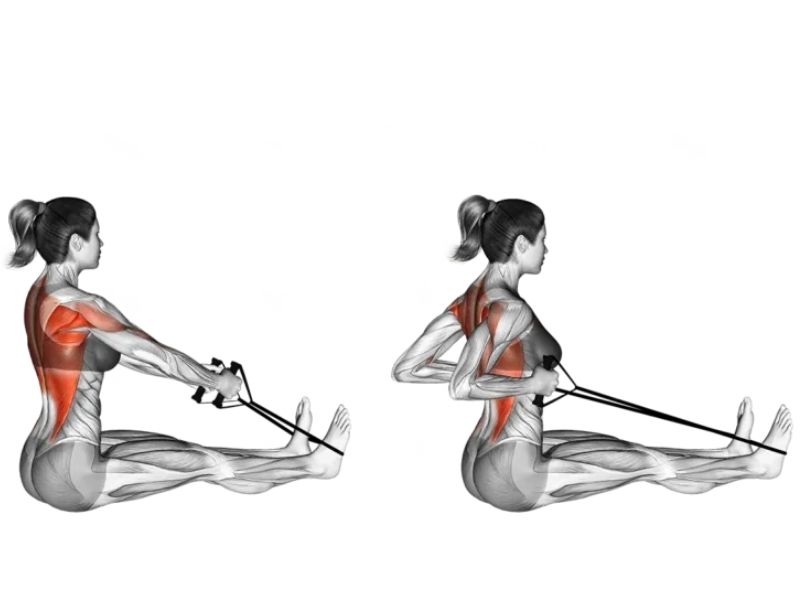
- Sit on the floor with your legs extended and loop the resistance band around your feet.
- Hold the handles with an overhand grip and keep your back straight.
- Exhale as you pull the handles towards your chest, squeezing your shoulder blades together.
- Hold the contraction briefly, then inhale as you slowly return to the starting position.
Resistance Band Lat Pulldown:
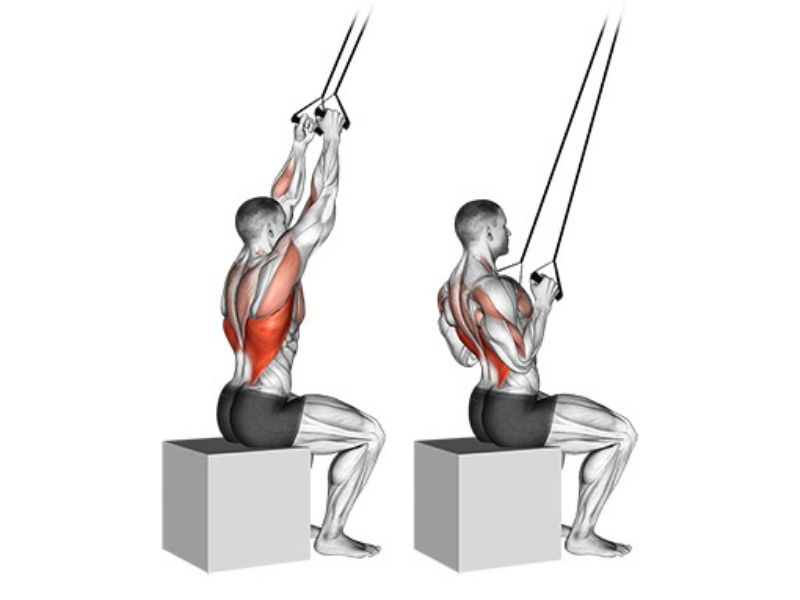
- Attach the resistance band to a secure anchor point above your head.
- Kneel or sit on a chair facing towards the anchor point and hold the handles with an overhand grip.
- Exhale as you pull the handles down towards your chest, squeezing your lats.
- Hold the contraction briefly, then inhale as you slowly return to the starting position.
Resistance Band Deadlift:
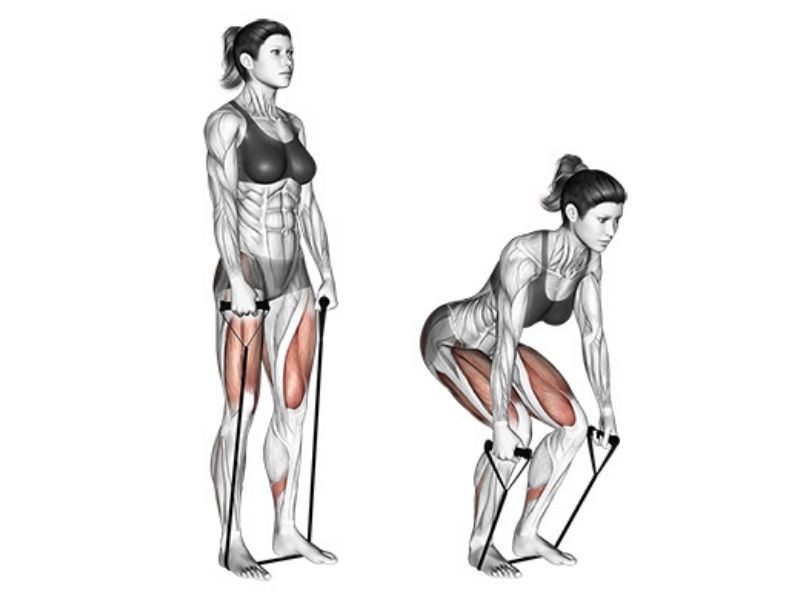
- Stand on the resistance band with both feet, holding the handles in front of your thighs.
- Hinge forward at the hips, keeping your back flat and knees slightly bent.
- Exhale as you lower the handles towards the floor, feeling a stretch in your hamstrings.
- Hold the contraction briefly, then inhale as you return to the starting position, squeezing your glutes at the top.
Resistance Band Bent-Over Row:
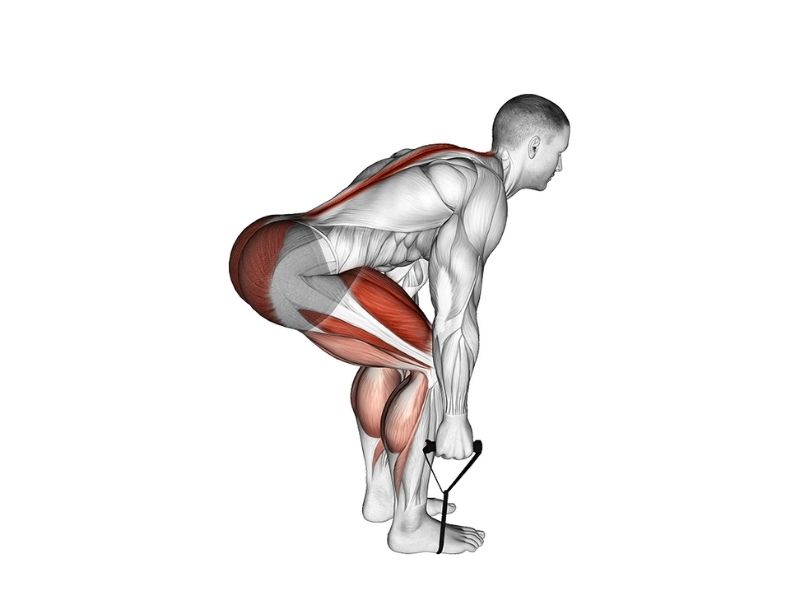
- Stand on the resistance band with both feet and hold the handles in front of your thighs.
- Hinge forward at the hips, keeping your back flat and knees slightly bent.
- Exhale as you pull the handles towards your waist, squeezing your shoulder blades together.
- Hold the contraction briefly, then inhale as you slowly return to the starting position.
Resistance Band Reverse Fly:

- Stand on the resistance band with both feet and hold the handles by your sides.
- Hinge forward at the hips, keeping your back flat and knees slightly bent.
- Exhale as you raise the handles out to the sides, squeezing your shoulder blades together.
- Hold the contraction briefly, then inhale as you slowly return to the starting position.
Shoulder:
Resistance Band Shoulder Press:
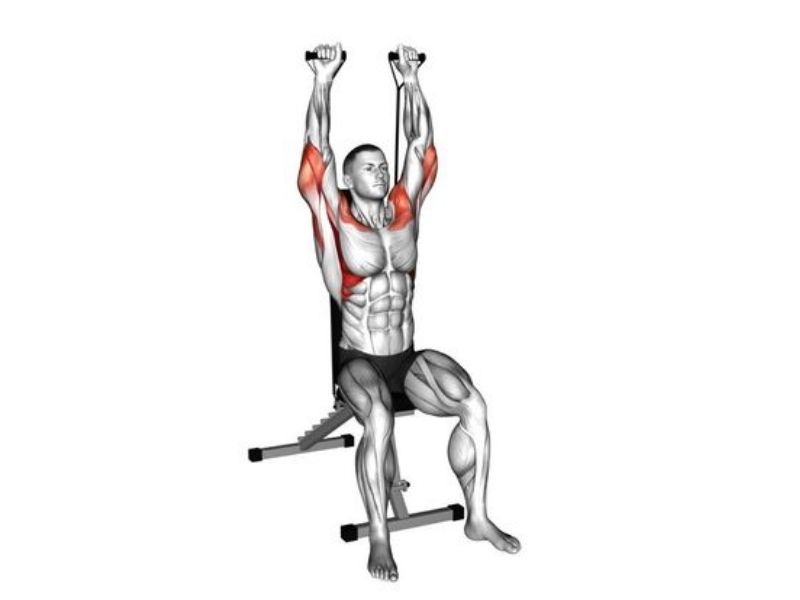
- Stand on the resistance band with both feet, holding the handles at shoulder height.
- Press the handles overhead until your arms are fully extended, exhaling as you push.
- Hold the contraction briefly, then inhale as you lower the handles back to shoulder height.
- Keep your core engaged and avoid arching your back.
Resistance Band Lateral Raise:
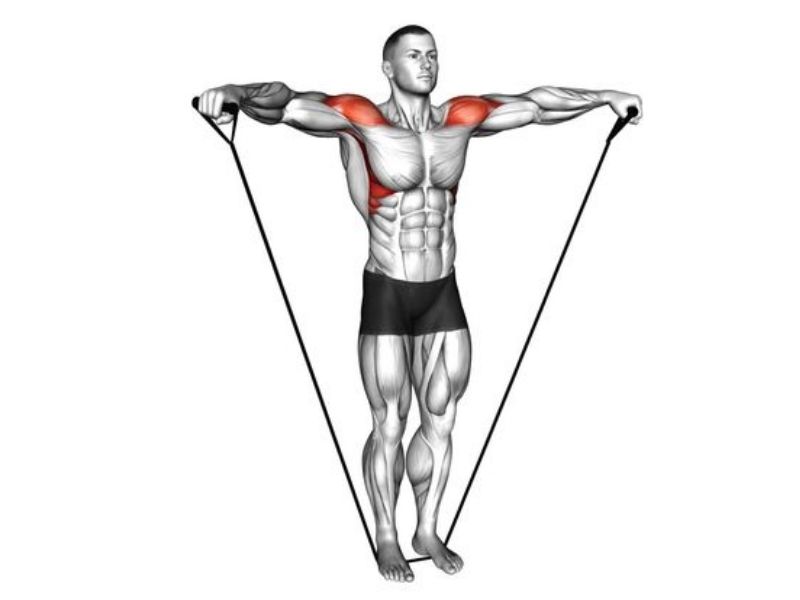
- Stand on the resistance band with both feet, holding the handles by your sides.
- Raise the handles out to the sides until your arms are parallel to the floor, exhaling as you lift.
- Hold the contraction briefly, then inhale as you lower the handles back down.
- Keep your elbows slightly bent and avoid swinging your body.
Resistance Band Front Raise:
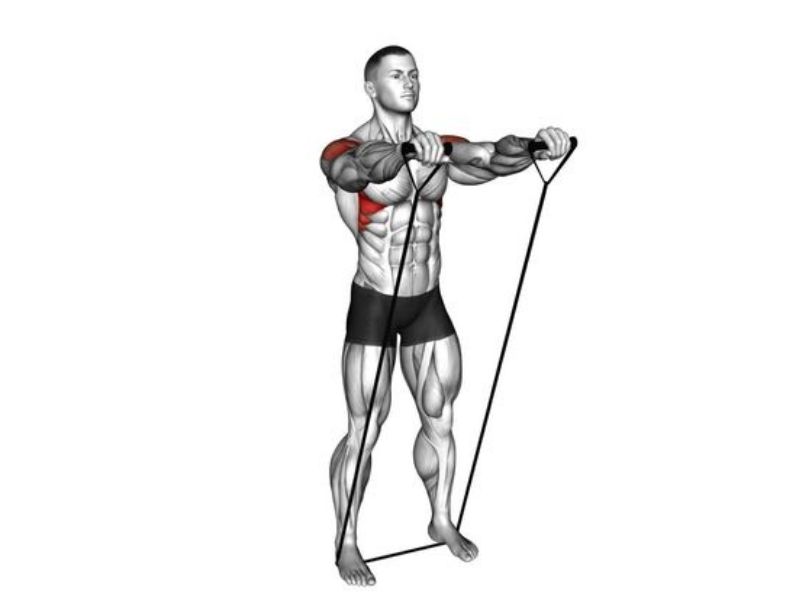
- Stand on the resistance band with both feet, holding the handles in front of your thighs.
- Raise the handles in front of you until your arms are parallel to the floor, exhaling as you lift.
- Hold the contraction briefly, then inhale as you lower the handles back down.
- Keep your core engaged and avoid leaning backward.
Resistance Band Upright Row:
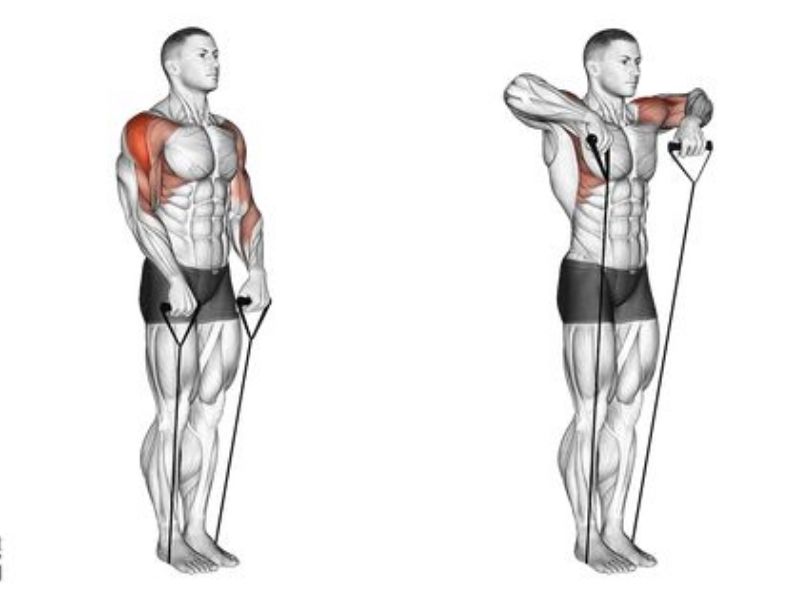
- Stand on the resistance band with both feet, holding the handles in front of your thighs.
- Pull the handles upward towards your chin, keeping them close to your body.
- Exhale as you lift, and hold the contraction briefly at the top.
- Inhale as you lower the handles back down, maintaining control throughout.
Resistance Band Shoulder Shrug:

- Stand on the resistance band with both feet, holding the handles by your sides.
- Shrug your shoulders upward towards your ears, exhaling as you lift.
- Hold the contraction briefly at the top, then inhale as you lower your shoulders back down.
- Keep your core engaged and avoid shrugging your shoulders forward.
Legs:
Resistance Band Squat:
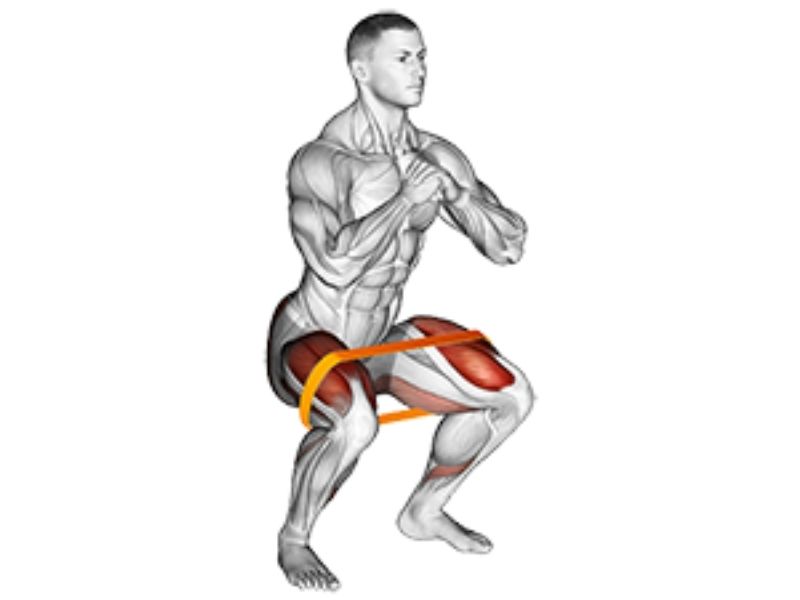
- Stand on the resistance band with both feet, holding the handles at shoulder height.
- Lower your body into a squat position, keeping your knees behind your toes.
- Exhale as you push through your heels to return to the starting position.
- Hold the contraction briefly at the top of the movement, then inhale as you lower back down.
Resistance Band Lunges:
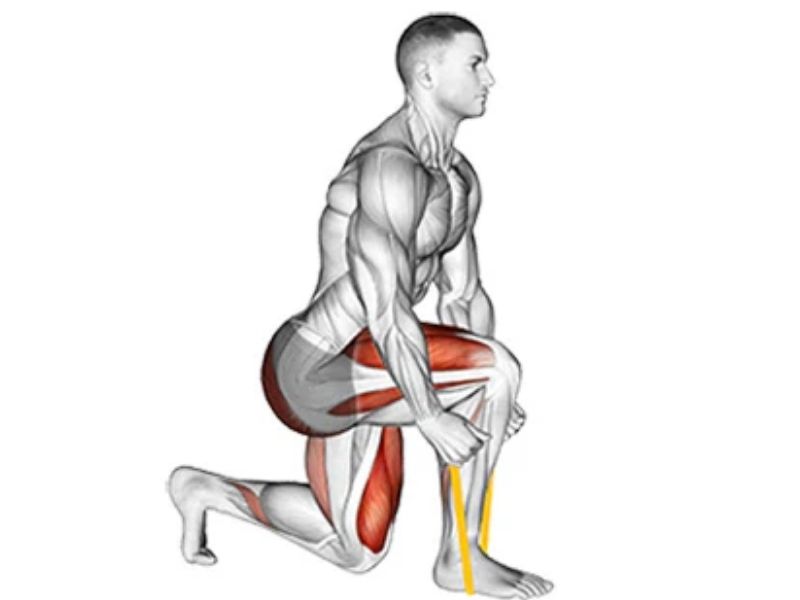
- Stand on the resistance band with one foot and hold the handles by your sides.
- Step back with your other foot into a lunge position, keeping your front knee behind your toes.
- Exhale as you lower your body towards the floor, bending both knees.
- Hold the contraction briefly, then inhale as you push through your front heel to return to the starting position.
Resistance Band Leg Press:
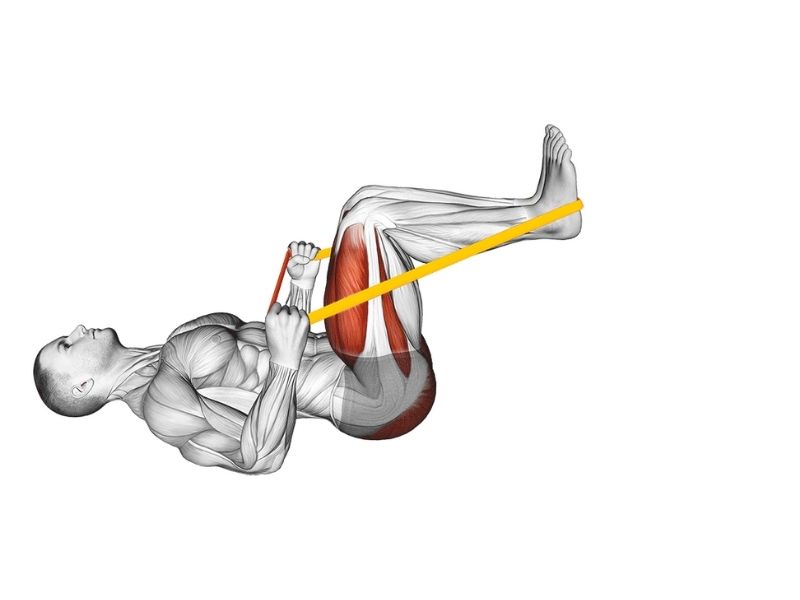
- Sit on a chair or bench and place the resistance band behind your back, holding one end in each hand.
- Extend your legs in front of you and press against the resistance band with your feet.
- Exhale as you push against the resistance band, straightening your legs.
- Hold the contraction briefly at the top of the movement, then inhale as you return to the starting position.
Resistance Band Deadlift:
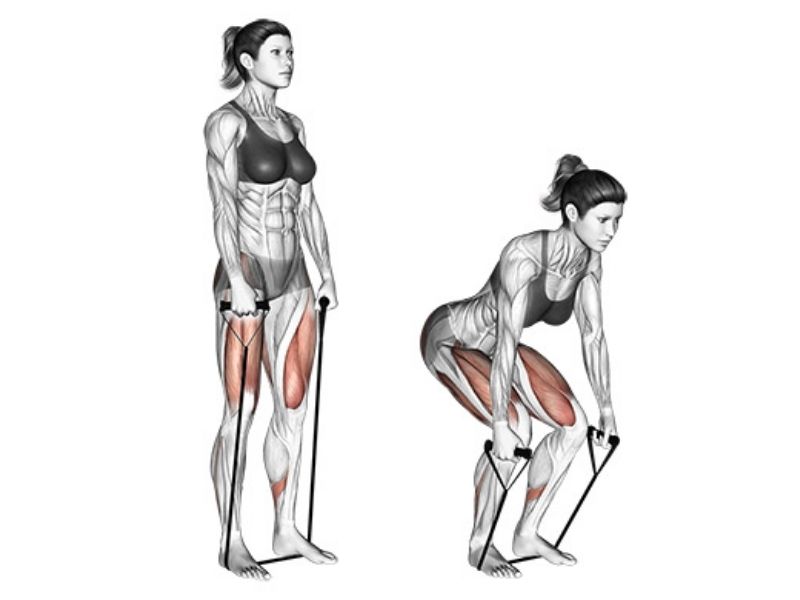
- Stand on the resistance band with both feet, holding the handles in front of your thighs.
- Hinge forward at the hips, keeping your back flat and knees slightly bent.
- Exhale as you lower the handles towards the floor, feeling a stretch in your hamstrings.
- Hold the contraction briefly, then inhale as you return to the starting position, squeezing your glutes at the top.
Resistance Band Leg Curl:

- Lie face down on a mat with the resistance band looped around one ankle.
- Anchor the other end of the resistance band to a sturdy object behind you.
- Exhale as you bend your knee and pull your heel towards your glutes.
- Hold the contraction briefly at the top of the movement, then inhale as you lower your leg back down.
Biceps:
Resistance Band Bicep Curl:
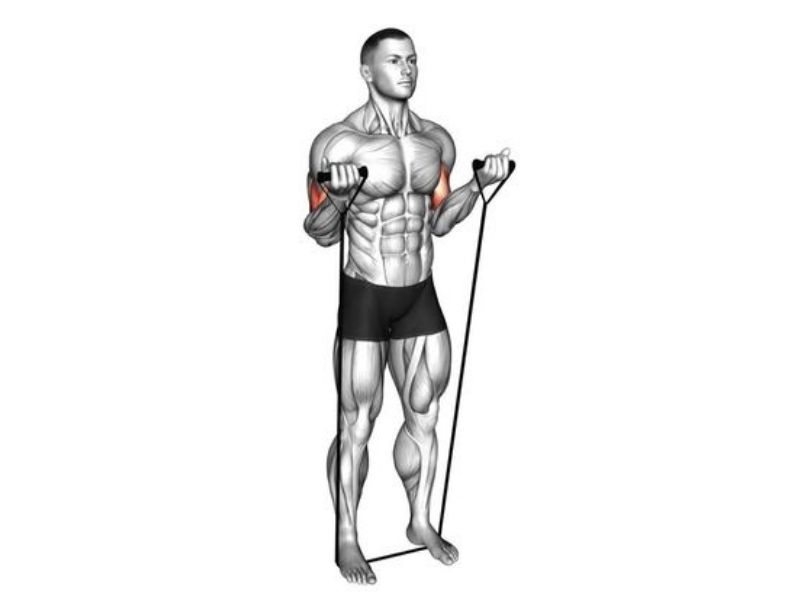
- Stand with your feet shoulder-width apart and step on the resistance band with both feet.
- Hold the handles with an underhand grip, palms facing forward, and arms fully extended.
- Exhale as you curl the handles towards your shoulders, keeping your elbows close to your sides.
- Hold the contraction briefly at the top of the movement, then inhale as you slowly lower the handles back down.
- Keep your core engaged and avoid swinging your body during the exercise.
Resistance Band Hammer Curl:
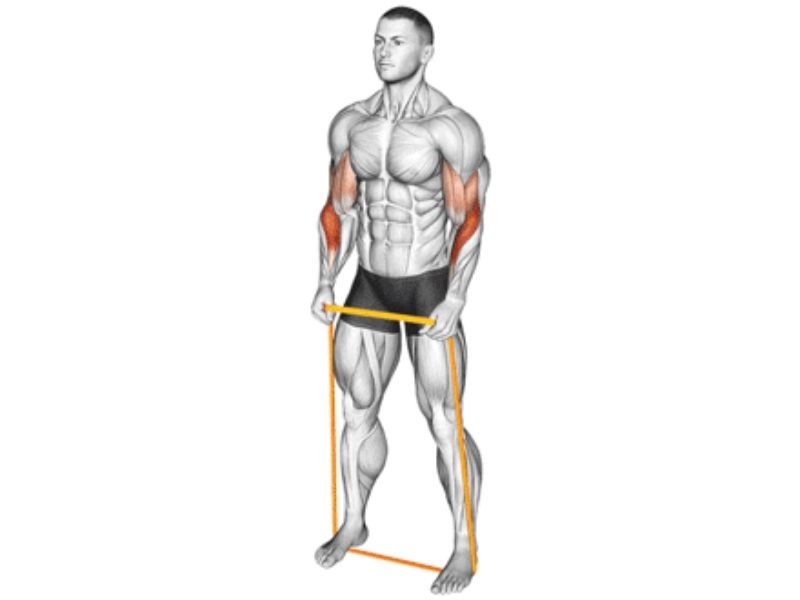
- Stand with your feet shoulder-width apart and step on the resistance band with both feet.
- Hold the handles with a neutral grip (palms facing each other) and arms fully extended.
- Exhale as you curl the handles towards your shoulders, keeping your elbows close to your sides.
- Hold the contraction briefly at the top of the movement, then inhale as you slowly lower the handles back down.
- Maintain a stable stance and avoid arching your back.
Resistance Band Concentration Curl:
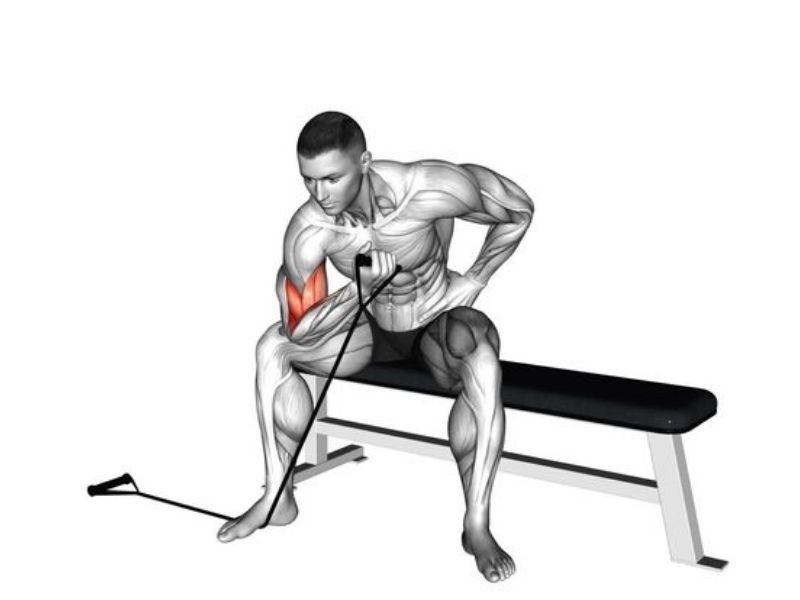
- Sit on a chair or bench with your knees slightly apart and place the resistance band under one foot.
- Grasp the handle with the same hand and rest your elbow on the inside of your thigh.
- Exhale as you curl the handle towards your shoulder, keeping your upper arm stationary.
- Hold the contraction briefly at the top of the movement, then inhale as you slowly lower the handle back down.
- Keep your back straight and avoid leaning forward during the exercise.
Resistance Band Preacher Curl:
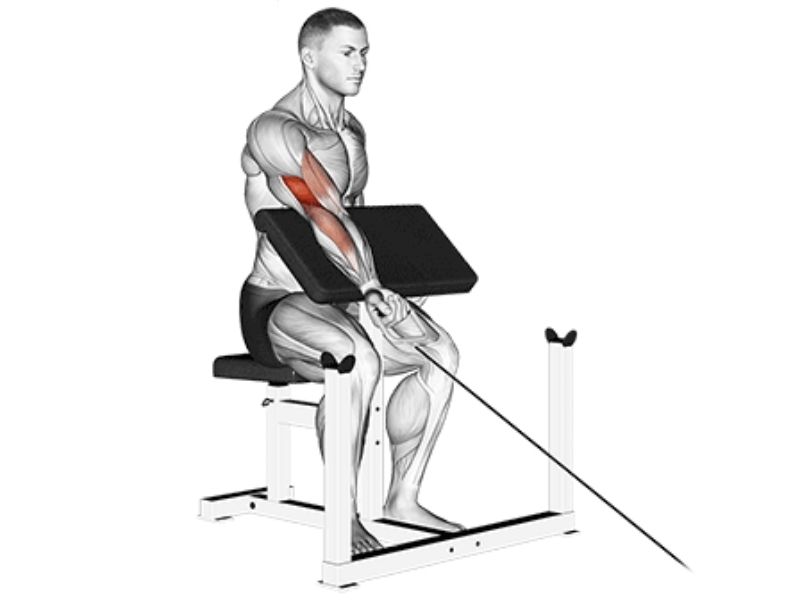
- Sit on a chair or bench and place the resistance band under both feet.
- Hold the handles with an underhand grip, palms facing upward, and arms fully extended.
- Rest your elbows on the inside of your thighs or on a bench pad for support.
- Exhale as you curl the handles towards your shoulders, keeping your upper arms stationary.
- Hold the contraction briefly at the top of the movement, then inhale as you slowly lower the handles back down.
- Keep your back straight and avoid using momentum to lift the handles.
Resistance Band Reverse Curl:

- Stand with your feet shoulder-width apart and step on the resistance band with both feet.
- Hold the handles with an overhand grip, palms facing downward, and arms fully extended.
- Exhale as you curl the handles towards your shoulders, keeping your elbows close to your sides.
- Hold the contraction briefly at the top of the movement, then inhale as you slowly lower the handles back down.
- Maintain a stable stance and avoid swinging your body during the exercise.
Triceps:
Resistance Band Tricep Kickback:
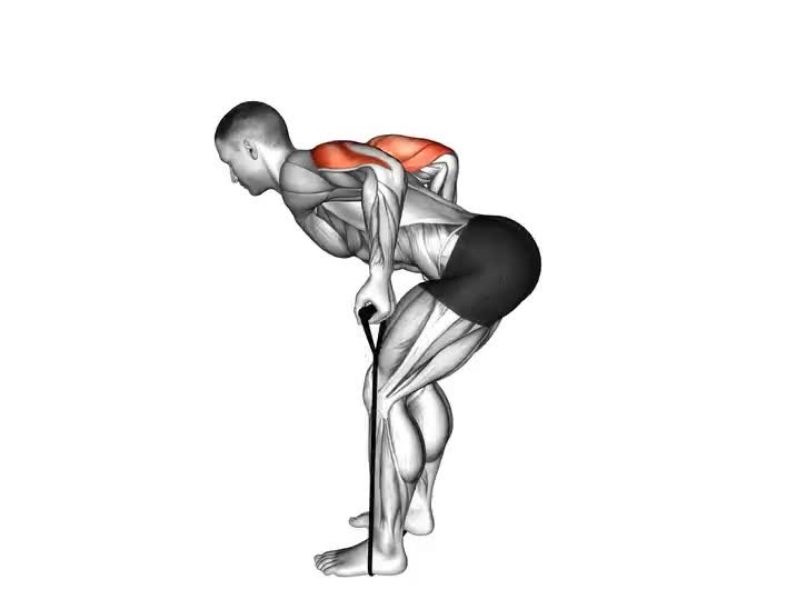
- Attach the resistance band to a secure anchor point at waist height.
- Stand facing towards the anchor point and hold the handles with an overhand grip.
- Step back to create tension in the band, then hinge forward at the hips.
- Exhale as you extend your arms backward, keeping your elbows close to your sides.
- Hold the contraction briefly, then inhale as you return to the starting position.
Resistance Band Tricep Pushdown:

- Attach the resistance band to a secure anchor point above your head.
- Stand facing towards the anchor point and hold the handles with an overhand grip.
- Step forward to create tension in the band, then bend your elbows to 90 degrees.
- Exhale as you push the handles downward until your arms are fully extended.
- Hold the contraction briefly, then inhale as you return to the starting position.
Resistance Band Overhead Tricep Extension:
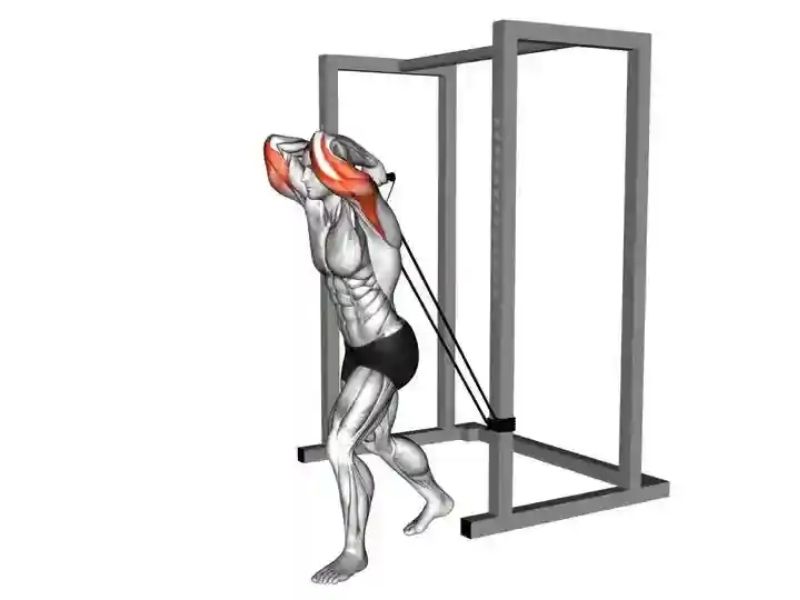
- Stand on the resistance band with both feet, holding one handle with both hands.
- Raise the handle overhead, keeping your elbows close to your head.
- Exhale as you extend your arms upward until they are fully extended.
- Hold the contraction briefly, then inhale as you lower the handle back down behind your head.
Resistance Band Skull Crushers:

- Lie flat on your back with the resistance band looped around a sturdy anchor above you.
- Hold the ends of the resistance band with your arms extended overhead.
- Bend your elbows to lower your hands towards your forehead, keeping your upper arms
Bodyweight:
Chest:
Push-Ups:
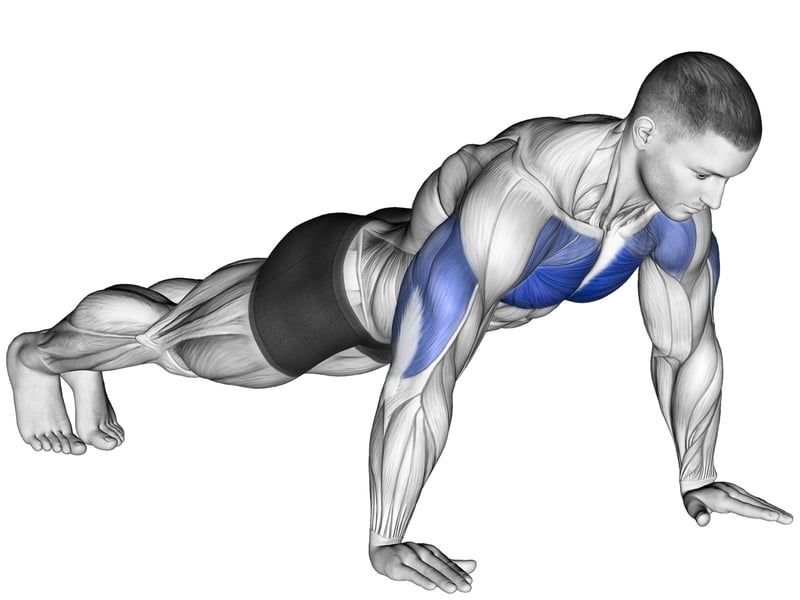
- Start in a high plank position with your hands directly under your shoulders.
- Lower your body towards the floor by bending your elbows.
- Push back up to the starting position, keeping your core engaged throughout.
Wide-Grip Push-Ups:
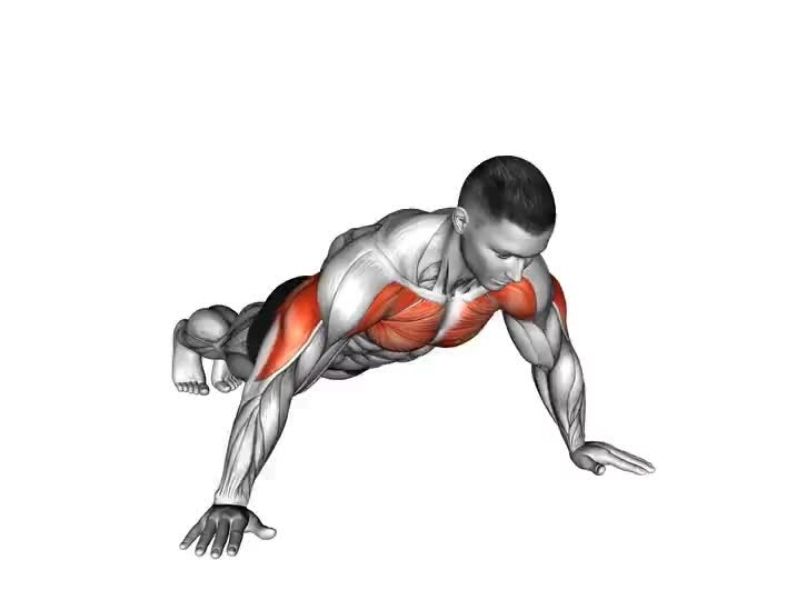
- Perform push-ups with your hands placed wider than shoulder-width apart.
- Lower your body towards the floor, maintaining a straight line from head to heels.
- Push back up to the starting position, focusing on engaging your chest muscles.
Diamond Push-Ups:
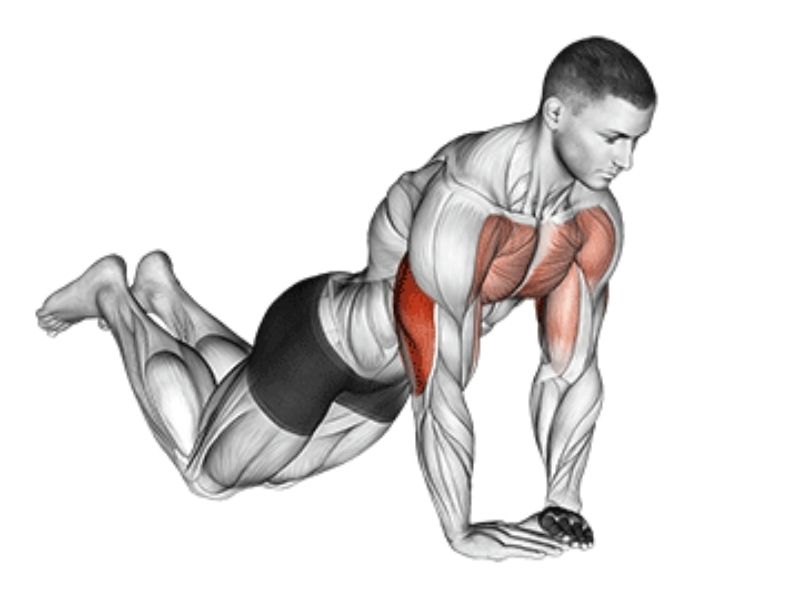
- Place your hands close together under your chest, forming a diamond shape with your thumbs and index fingers.
- Lower your body towards the floor, keeping your elbows close to your sides.
- Push back up to the starting position, focusing on engaging your triceps and chest.
Decline Push-Ups:

- Elevate your feet on a stable surface, such as a bench or step.
- Perform push-ups with your hands on the floor and feet elevated.
- Lower your body towards the floor, maintaining a straight line from head to heels.
- Push back up to the starting position, keeping your core engaged throughout.
Plyometric Push-Ups:

- Perform a standard push-up, lowering your body towards the floor.
- Push explosively off the floor, allowing your hands to leave the ground.
- Land softly and immediately lower into the next push-up, maintaining control throughout.
Back:
Pull-Ups:
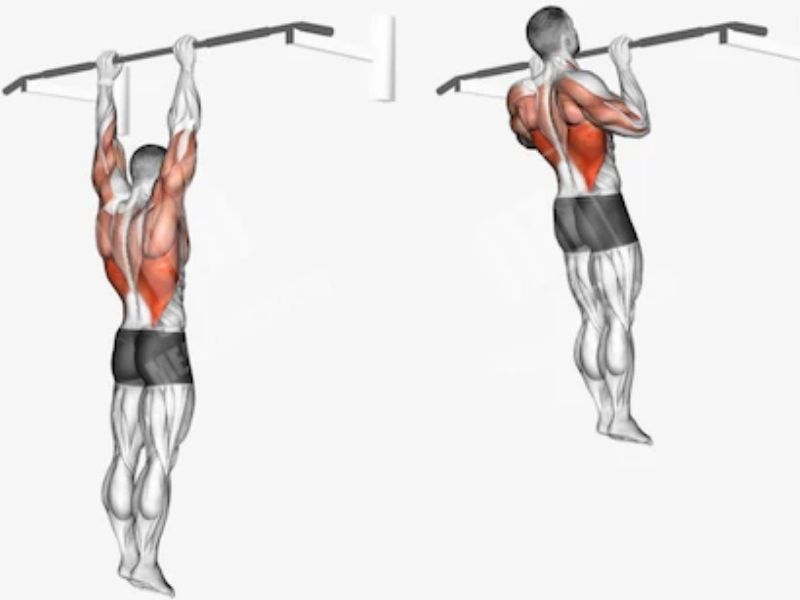
- Grip the pull-up bar with your palms facing away from you and hands shoulder-width apart.
- Hang from the bar with your arms fully extended.
- Pull your body up towards the bar until your chin is above it.
- Lower yourself back down to the starting position with control.
Chin-Ups:
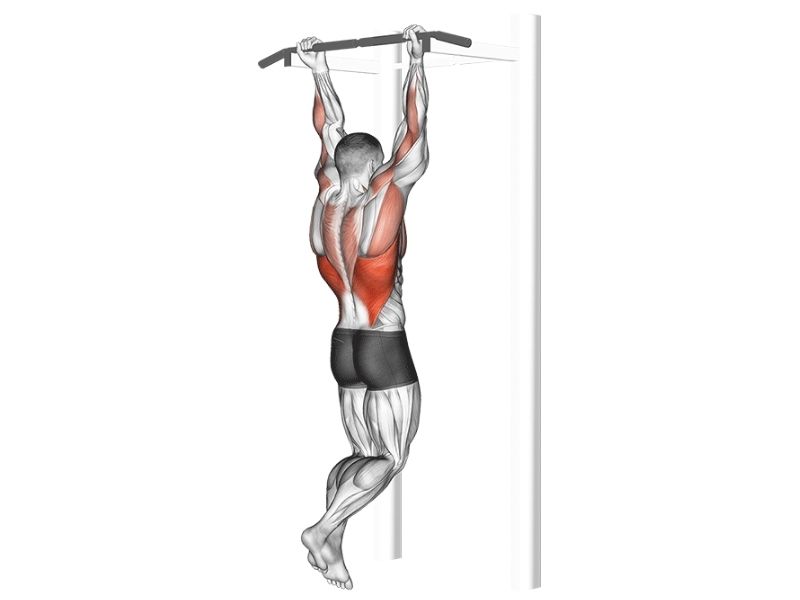
- Grip the pull-up bar with your palms facing towards you and hands shoulder-width apart.
- Hang from the bar with your arms fully extended.
- Pull your body up towards the bar until your chin is above it.
- Lower yourself back down to the starting position with control.
Inverted Rows:
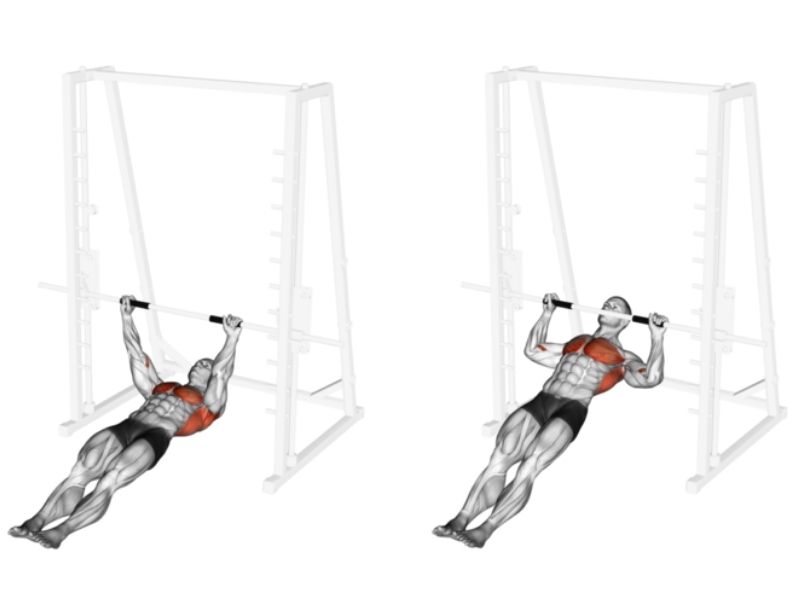

- Set up a bar or suspension trainer at waist height.
- Lie underneath the bar with your body straight and arms fully extended.
- Pull your chest towards the bar by bending your elbows and squeezing your shoulder blades together.
- Lower yourself back down to the starting position with control.
Superman:


- Lie face down on the ground with your arms extended overhead and legs straight.
- Lift your chest and legs off the ground simultaneously, squeezing your lower back and glutes.
- Hold the contraction briefly, then lower back down to the starting position.
Back Extensions:
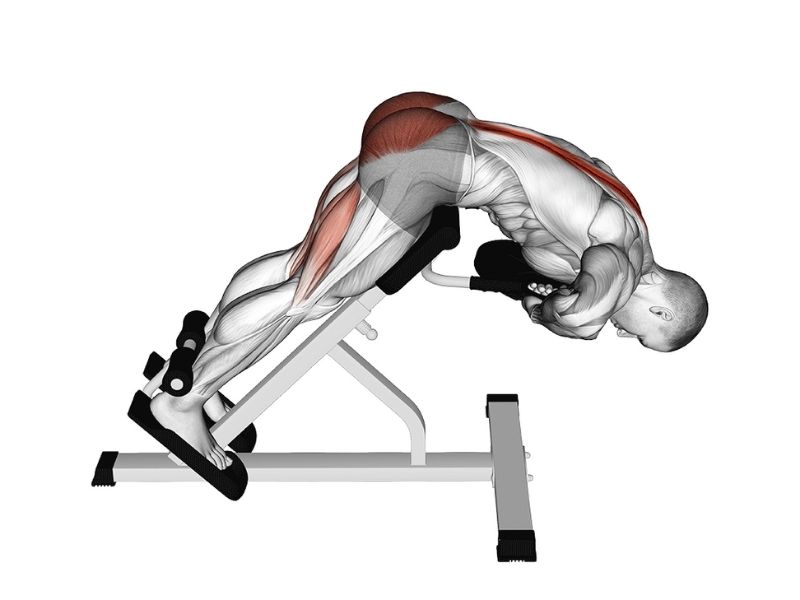

- Position yourself face down on a back extension bench with your hips and ankles secured.
- Cross your arms over your chest or hold a weight plate against your chest.
- Lower your upper body towards the ground, then lift back up to the starting position by contracting your lower back muscles.
Shoulder:
Pike Push-Ups:
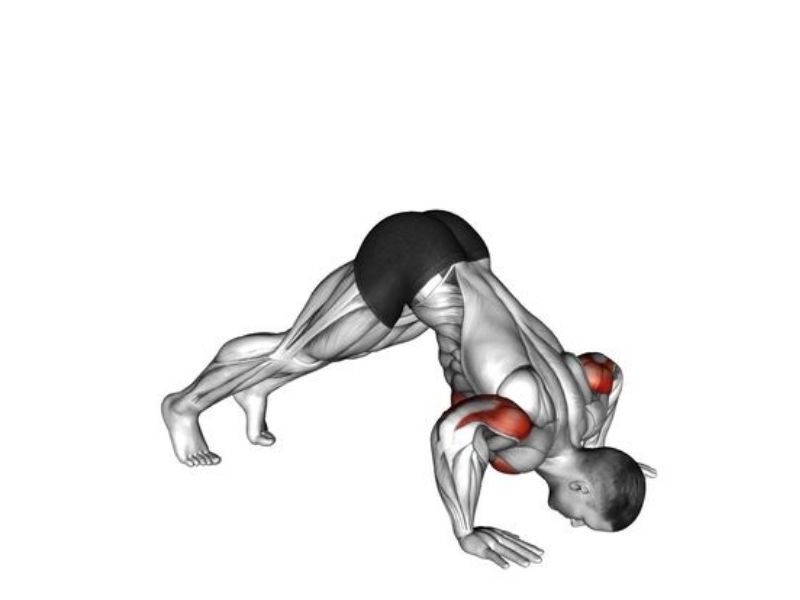

- Start in a downward dog position with your hands on the floor and hips raised high.
- Lower your head towards the floor by bending your elbows.
- Push back up to the starting position, keeping your core engaged throughout.
Shoulder Taps:
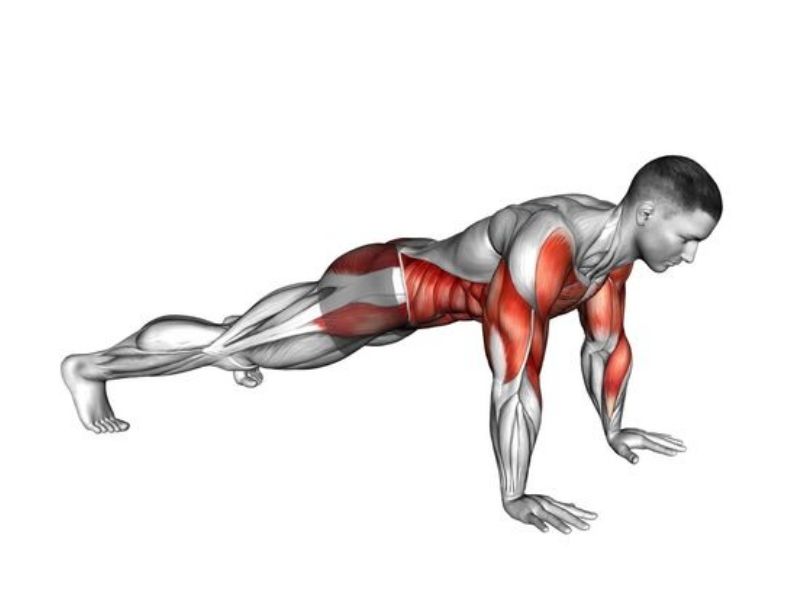

- Begin in a high plank position with your hands directly under your shoulders.
- Lift one hand off the floor and tap the opposite shoulder.
- Return the hand to the starting position and repeat on the other side.
Handstand Push-Ups:
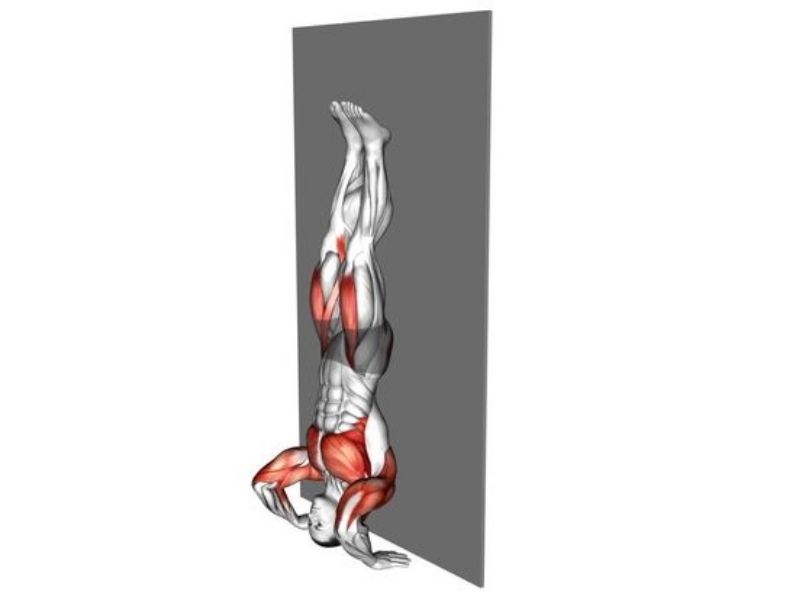

- Start in a handstand position against a wall or with assistance.
- Lower your body towards the floor by bending your elbows.
- Push back up to the starting position, keeping your core tight and maintaining balance.
Plank to Push-Up:
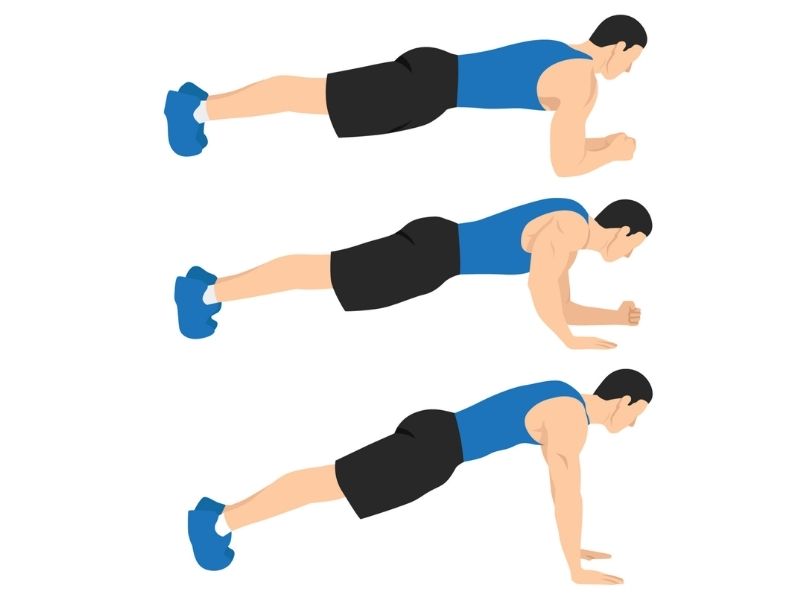

- Begin in a plank position with your hands directly under your shoulders.
- Push up onto your hands, one at a time, into a high plank position.
- Lower back down to the starting plank position, one arm at a time.
Legs:
Squats:


- Stand with your feet shoulder-width apart and toes slightly turned out.
- Lower your body towards the floor by bending your knees and pushing your hips back.
- Keep your chest up and back straight, and lower until your thighs are parallel to the ground.
- Push through your heels to return to the starting position, squeezing your glutes at the top.
Lunges:
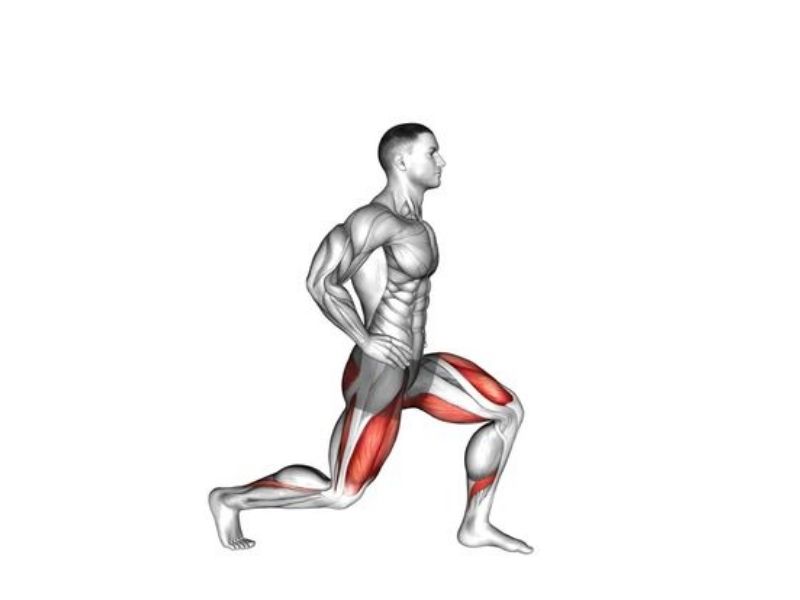

- Start standing with your feet together.
- Take a big step forward with one foot and lower your body until both knees are bent at 90-degree angles.
- Keep your front knee aligned with your ankle and your back knee hovering just above the ground.
- Push through your front heel to return to the starting position and repeat on the other side.
Jump Squats:


- Begin in a squat position with your feet shoulder-width apart.
- Lower your body into a squat, then explosively jump up into the air.
- Land softly and immediately lower back into the squat position to complete one rep.
Bulgarian Split Squats:
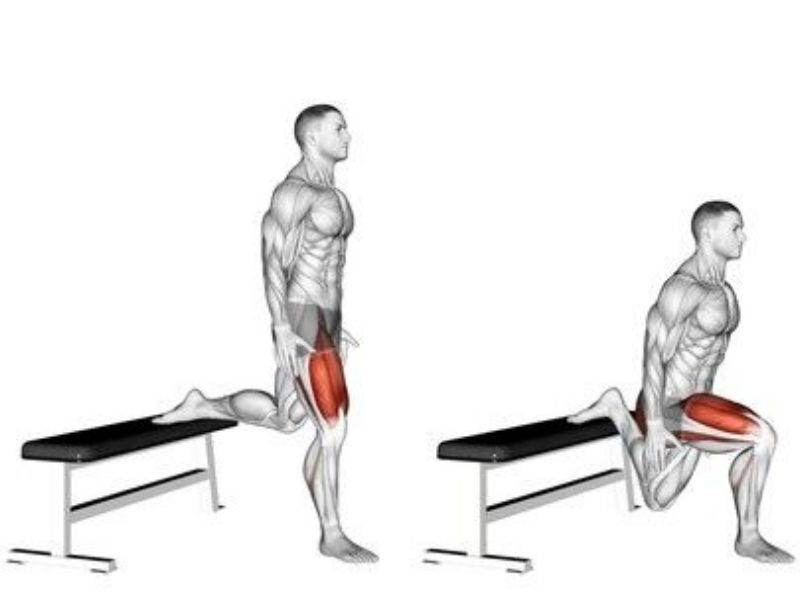

- Stand a few feet in front of a bench or step, facing away from it.
- Place one foot on the bench behind you and the other foot flat on the ground.
- Lower your body towards the ground by bending your front knee until your thigh is parallel to the ground.
- Push through your front heel to return to the starting position, keeping your chest up throughout.
Glute Bridges:


- Lie on your back with your knees bent and feet flat on the ground.
- Press through your heels to lift your hips towards the ceiling, squeezing your glutes at the top.
- Lower your hips back down to the ground and repeat for the desired number of reps.
Biceps:
Chin-Ups:



- Grip the pull-up bar with your palms facing towards you and hands shoulder-width apart.
- Pull yourself up towards the bar, bringing your chin above it.
- Lower yourself back down to the starting position with control.
Inverted Rows:
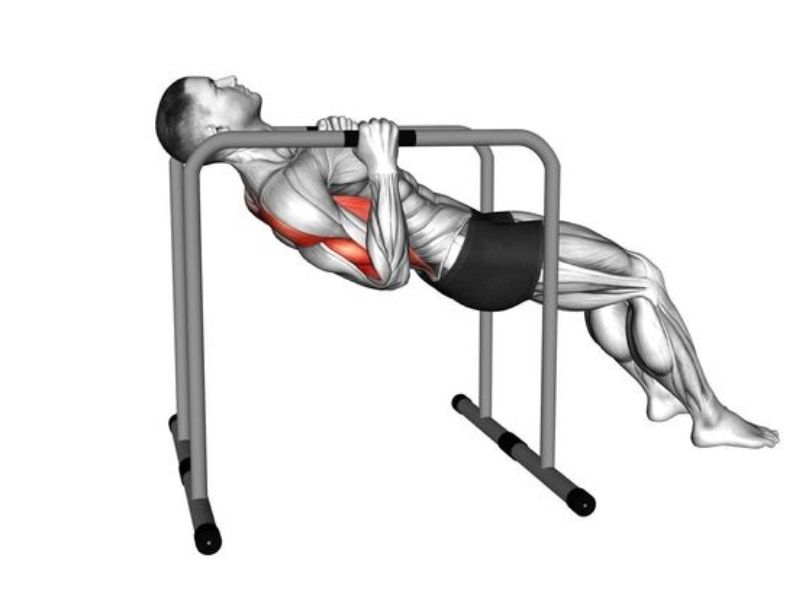

- Set up a bar or suspension trainer at waist height.
- Lie underneath the bar with your body straight and arms fully extended.
- Pull your chest towards the bar by bending your elbows and squeezing your shoulder blades together.
- Lower yourself back down to the starting position with control.
Bicep Push-Ups:
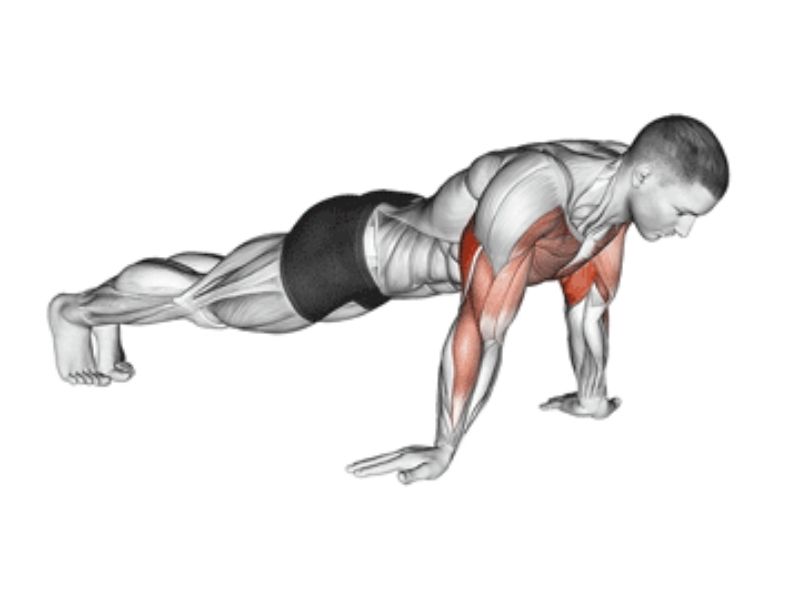

- Begin in a high plank position with your hands directly under your shoulders.
- Perform a push-up, but keep your elbows close to your sides as you lower your body towards the floor.
- Push back up to the starting position, focusing on engaging your biceps.
Spider Crawl Push-Ups:
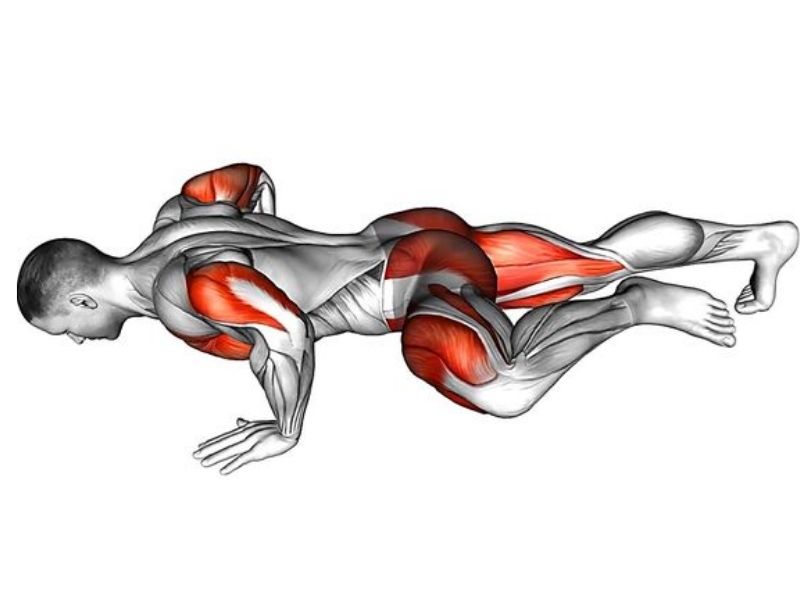

- Perform a standard push-up, lowering your body towards the floor.
- As you push back up, lift one foot off the floor and bring your knee towards your elbow on the same side.
- Return to the starting position and repeat on the other side.
Triceps:
Tricep Dips:


- Sit on a stable surface, such as a chair or bench, with your hands gripping the edge.
- Lift your body off the surface and walk your feet forward.
- Lower your body towards the floor by bending your elbows.
- Push back up to the starting position, focusing on engaging your triceps.
Close-Grip Push-Ups:
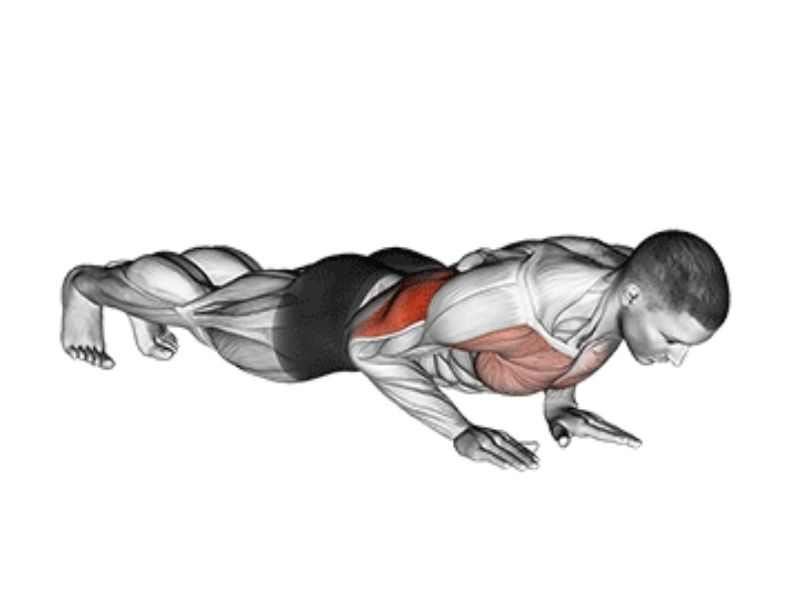

- Start in a high plank position with your hands close together under your chest.
- Lower your body towards the floor, keeping your elbows close to your sides.
- Push back up to the starting position, focusing on engaging your triceps.
Bench Dips:
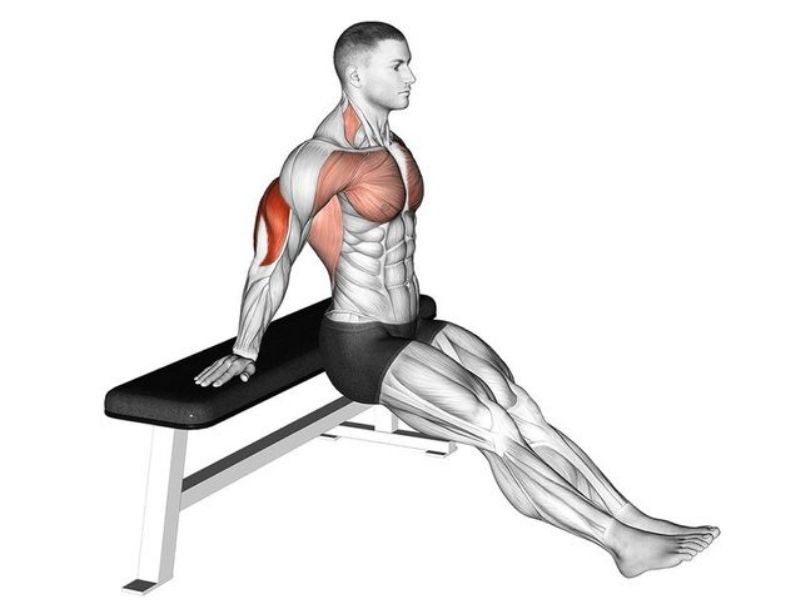

- Sit on the edge of a stable surface, such as a bench or step, with your hands gripping the edge.
- Lift your body off the surface and walk your feet forward.
- Lower your body towards the floor by bending your elbows.
- Push back up to the starting position, focusing on engaging your triceps.
Diamond Push-Ups:


- Perform push-ups with your hands close together under your chest, forming a diamond shape with your thumbs and index fingers.
- Lower your body towards the floor, keeping your elbows close to your sides.
- Push back up to the starting position, focusing on engaging your triceps.
Kettlebells:
Chest:
Kettlebell Chest Press:


- Lie on your back on a bench or mat with a kettlebell in each hand, elbows bent and palms facing towards your feet.
- Press the kettlebells up towards the ceiling until your arms are fully extended.
- Slowly lower the kettlebells back down to the starting position and repeat.
Kettlebell Flyes:


- Lie on your back on a bench or mat with a kettlebell in each hand, arms extended directly above your chest.
- Keeping a slight bend in your elbows, open your arms out to the sides in a wide arc until you feel a stretch in your chest.
- Contract your chest muscles to bring the kettlebells back together above your chest and repeat.
Kettlebell Incline Press:


- Set up on an incline bench with a kettlebell in each hand.
- Hold the kettlebells at shoulder height, palms facing forward.
- Press the kettlebells upward until your arms are fully extended.
- Lower the kettlebells back down to shoulder height with control.
Kettlebell Pullovers:
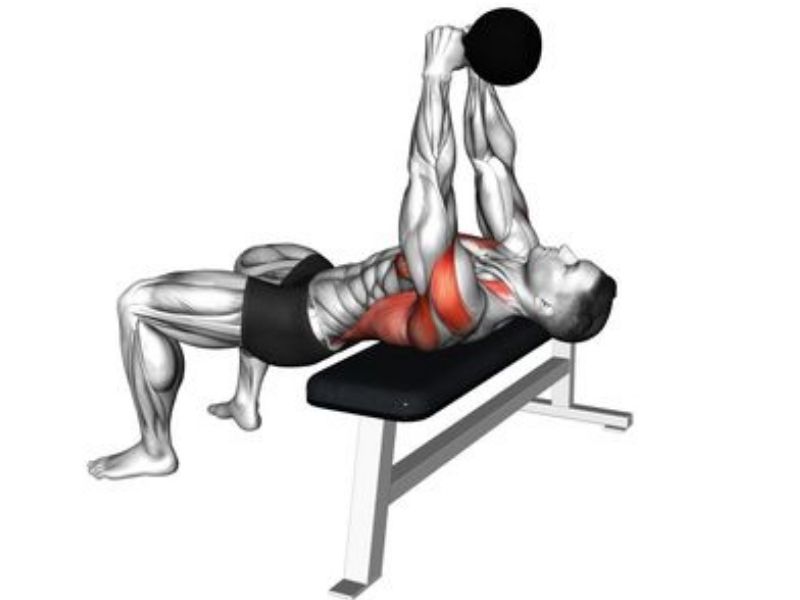

- Lie on your back on a bench or mat with a kettlebell in both hands, arms extended directly above your chest.
- Keeping a slight bend in your elbows, lower the kettlebell back behind your head until you feel a stretch in your chest and shoulders.
- Use your chest and back muscles to pull the kettlebell back up to the starting position and repeat.
Kettlebell Push-Ups (with hands on kettlebells):
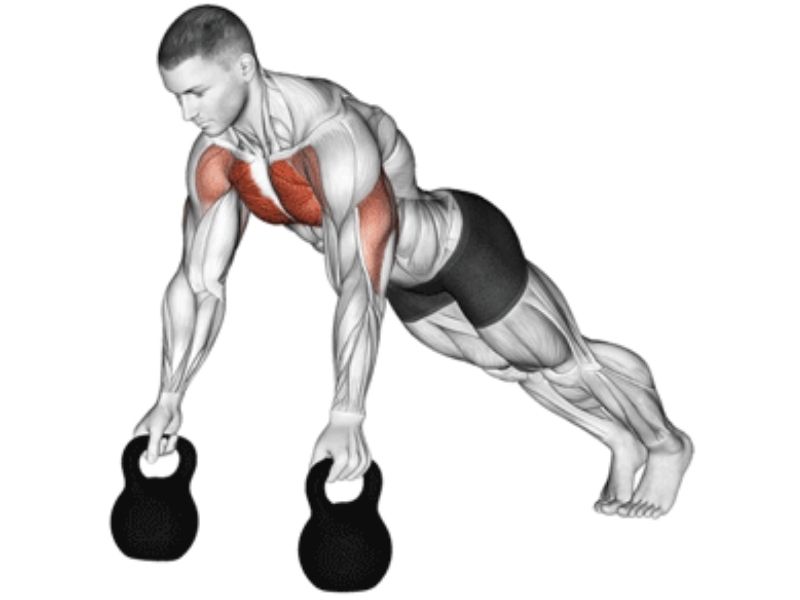

- Place two kettlebells on the ground slightly wider than shoulder-width apart.
- Assume a push-up position with your hands on the handles of the kettlebells and your body in a straight line from head to heels.
- Lower your chest towards the ground by bending your elbows, then push back up to the starting position and repeat.
Back:
Kettlebell Bent-Over Rows:


- Stand with your feet hip-width apart and hold a kettlebell in each hand with your palms facing towards your body.
- Hinge at the hips to bend forward until your torso is nearly parallel to the ground, allowing the kettlebells to hang directly beneath your shoulders.
- Pull the kettlebells up towards your ribcage by bending your elbows and squeezing your shoulder blades together.
- Lower the kettlebells back down to the starting position and repeat.
Kettlebell Deadlifts:
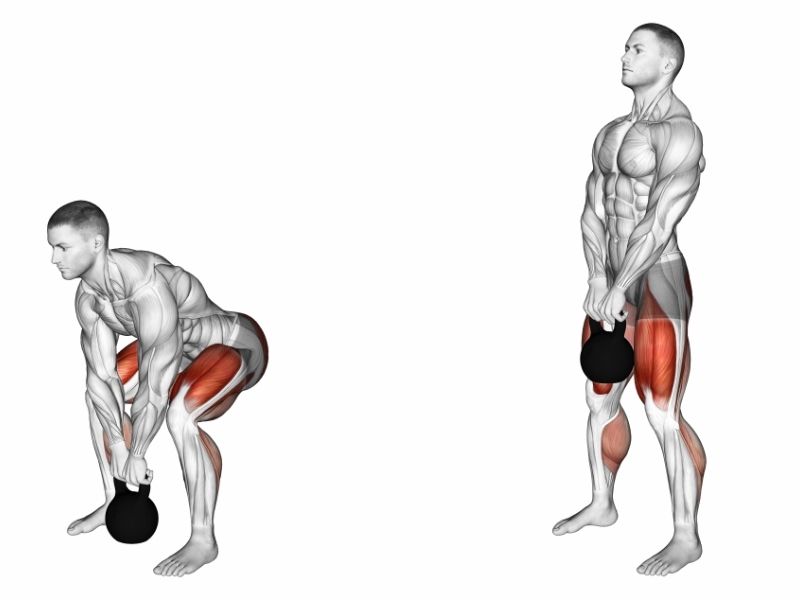

- Stand with your feet hip-width apart and hold a kettlebell with both hands in front of your body.
- Hinge at the hips to lower the kettlebell towards the ground while keeping your back flat and chest up.
- Push through your heels to stand up straight and lift the kettlebell to hip level.
- Lower the kettlebell back down to the starting position and repeat.
Kettlebell Single-Arm Rows:
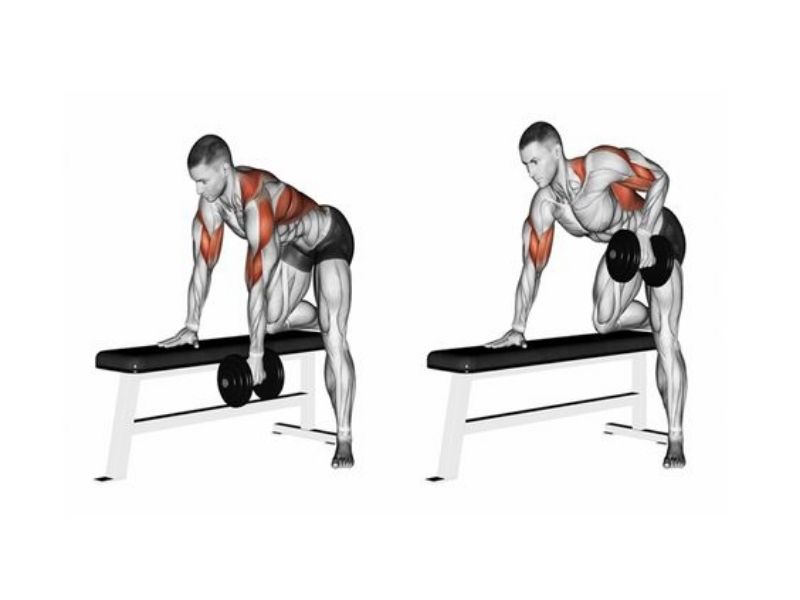

- Stand with your feet hip-width apart and hold a kettlebell in one hand with your palm facing towards your body.
- Hinge at the hips to bend forward until your torso is nearly parallel to the ground, allowing the kettlebell to hang directly beneath your shoulder.
- Pull the kettlebell up towards your ribcage by bending your elbow and squeezing your shoulder blade together.
- Lower the kettlebell back down to the starting position and repeat.
Kettlebell Renegade Rows:
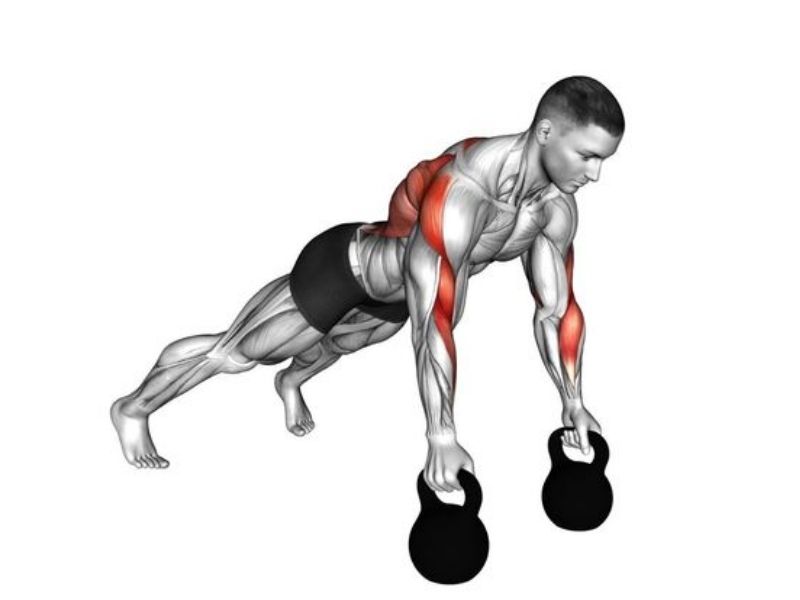

- Start in a push-up position with a kettlebell in each hand on the ground directly beneath your shoulders.
- Keeping your core engaged and hips level, row one kettlebell up towards your ribcage by bending your elbow and squeezing your shoulder blade together.
- Lower the kettlebell back down to the ground and repeat on the other side.
Shoulder:
Kettlebell Shoulder Press:


- Stand with your feet hip-width apart and hold a kettlebell in each hand at shoulder height.
- Press the kettlebells overhead until your arms are fully extended.
- Lower the kettlebells back down to shoulder height and repeat.
Kettlebell Lateral Raises:
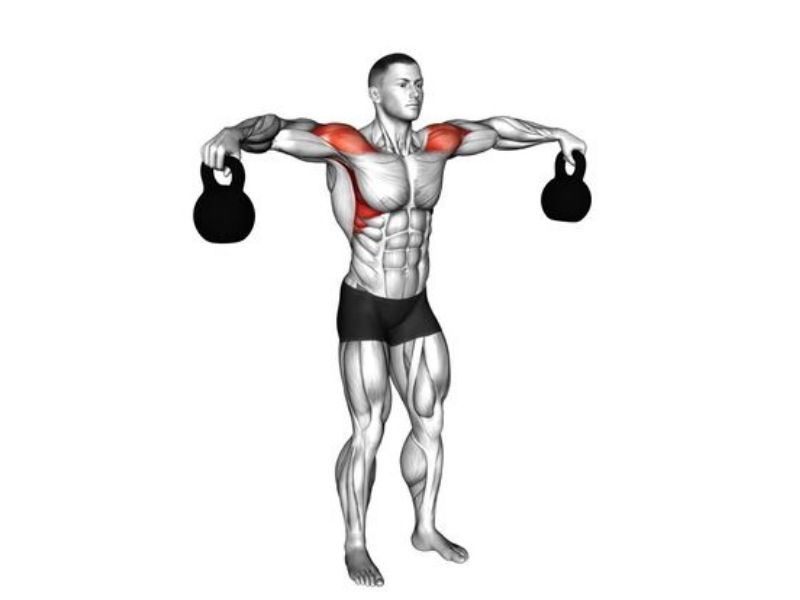

- Stand with your feet hip-width apart and hold a kettlebell in each hand by your sides.
- Keeping your arms straight, lift the kettlebells out to the sides until they reach shoulder height.
- Slowly lower the kettlebells back down to the starting position.
Kettlebell Front Raises:
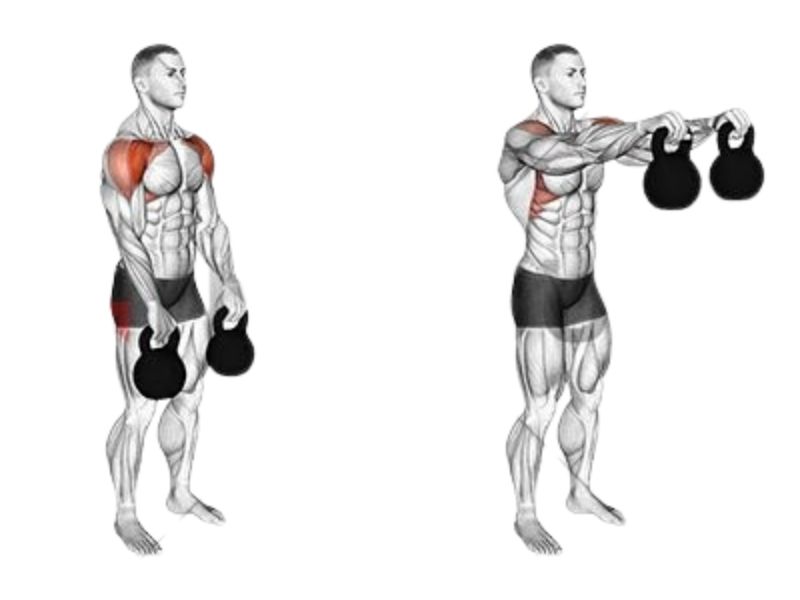

- Stand with your feet hip-width apart and hold a kettlebell in each hand in front of your thighs.
- Keeping your arms straight, lift the kettlebells directly in front of you until they reach shoulder height.
- Slowly lower the kettlebells back down to the starting position.
Kettlebell High Pulls:


- Stand with your feet hip-width apart and hold a kettlebell in each hand between your legs.
- Bend your knees slightly and hinge at the hips to lower the kettlebells towards the ground.
- Explosively extend your hips and knees while pulling the kettlebells up towards your shoulders.
- Lower the kettlebells back down to the starting position and repeat.
Kettlebell Arnold Press:


- Start by holding a kettlebell in each hand at shoulder height with your palms facing towards you and elbows bent.
- Press the kettlebells overhead while rotating your palms away from you until your arms are fully extended.
- Reverse the movement to return to the starting position and repeat.
Legs:
Kettlebell Goblet Squats:


- Hold a kettlebell by the horns with both hands close to your chest and stand with your feet shoulder-width apart.
- Lower your body into a squat by bending your knees and pushing your hips back until your thighs are parallel to the ground.
- Push through your heels to return to the starting position and repeat.
Kettlebell Lunges:
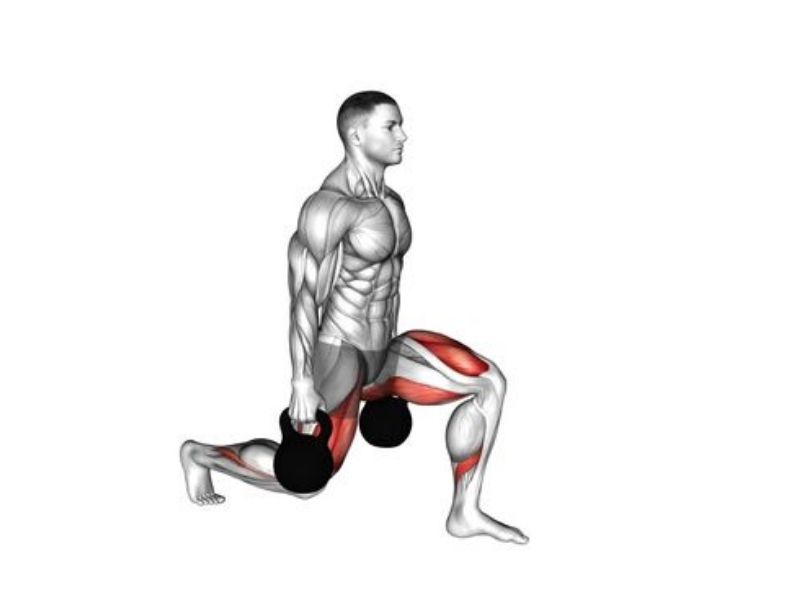

- Hold a kettlebell in each hand by your sides and stand with your feet hip-width apart.
- Take a large step forward with one foot and lower your body towards the ground by bending both knees until your front thigh is parallel to the ground.
- Push through your front heel to return to the starting position and repeat on the other side.
Kettlebell Sumo Deadlifts:
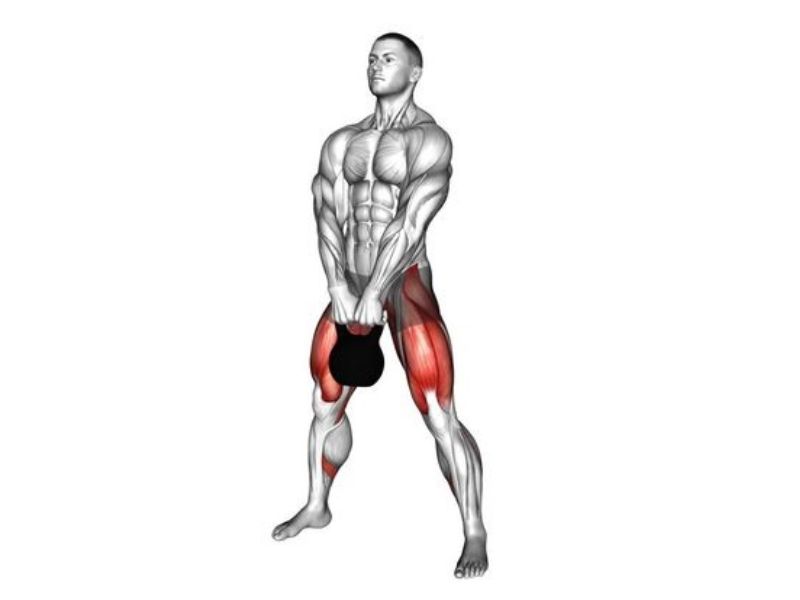

- Stand with your feet wider than shoulder-width apart and toes pointed slightly outwards.
- Hold a kettlebell with both hands between your legs and hinge at the hips to lower the kettlebell towards the ground.
- Keep your back straight and chest up as you push through your heels to stand up straight and lift the kettlebell to hip level.
- Lower the kettlebell back down to the starting position and repeat.
Kettlebell Swing:


- Stand with your feet shoulder-width apart and hold a kettlebell with both hands in front of your body.
- Hinge at the hips to swing the kettlebell back between your legs, then explosively drive your hips forward to swing the kettlebell up to shoulder height.
- Allow the kettlebell to swing back down between your legs and repeat.
Kettlebell Step-Ups:
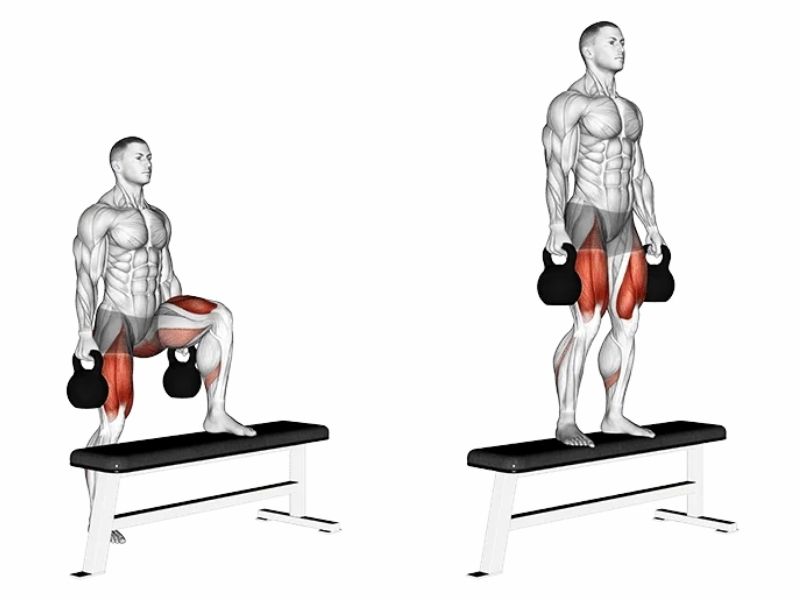

- Stand facing a bench or step with a kettlebell in each hand by your sides.
- Place one foot onto the bench or step and push through your heel to step up onto it.
- Step back down with the same foot and repeat on the other side.
Biceps:
Kettlebell Bicep Curls:
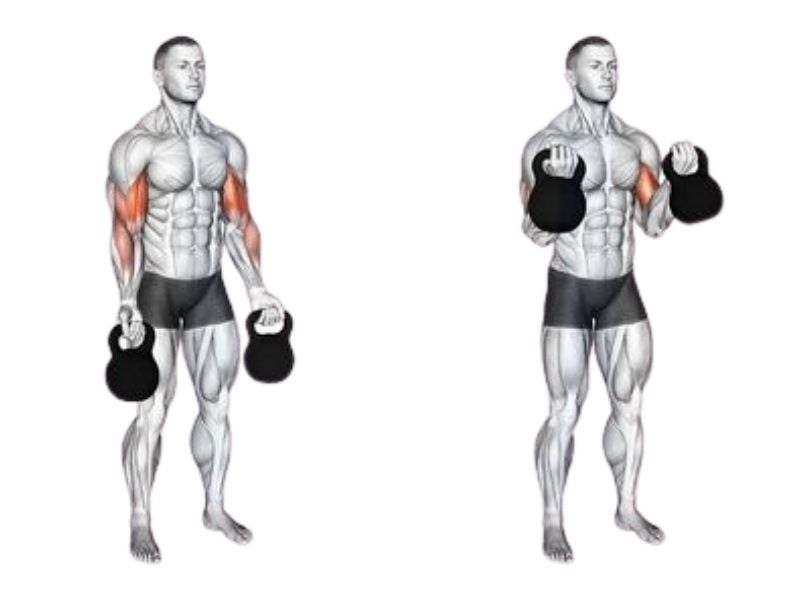

- Stand with your feet hip-width apart and hold a kettlebell in each hand by your sides with your palms facing towards the front.
- Keeping your elbows close to your sides, curl the kettlebells up towards your shoulders.
- Slowly lower the kettlebells back down to the starting position and repeat.
Kettlebell Concentration Curls:
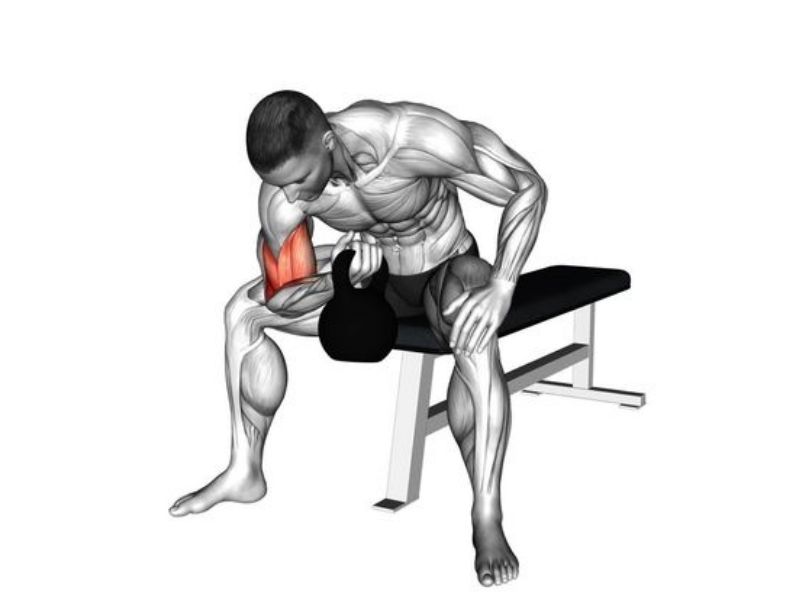

- Sit on a bench or chair with your feet flat on the floor and hold a kettlebell in one hand, arm extended towards the ground between your legs.
- Curl the kettlebell up towards your shoulder while keeping your upper arm stationary.
- Slowly lower the kettlebell back down to the starting position and repeat.
Kettlebell Drag Curls:


- Stand with your feet hip-width apart and hold a kettlebell in each hand by your sides with your palms facing towards the front.
- Curl the kettlebells up towards your shoulders while simultaneously dragging them up along the front of your body.
- Slowly lower the kettlebells back down to the starting position and repeat.
Kettlebell Preacher Curl:


- Sit on a preacher bench, placing your upper arms against the pad and holding a dumbbell in each hand.
- Allow your arms to hang straight down, palms facing up.
- Curl the dumbbells upwards towards your shoulders, keeping your upper arms stationary.
- Lower the dumbbells back down with control.
Triceps:
Kettlebell Overhead Tricep Extension:
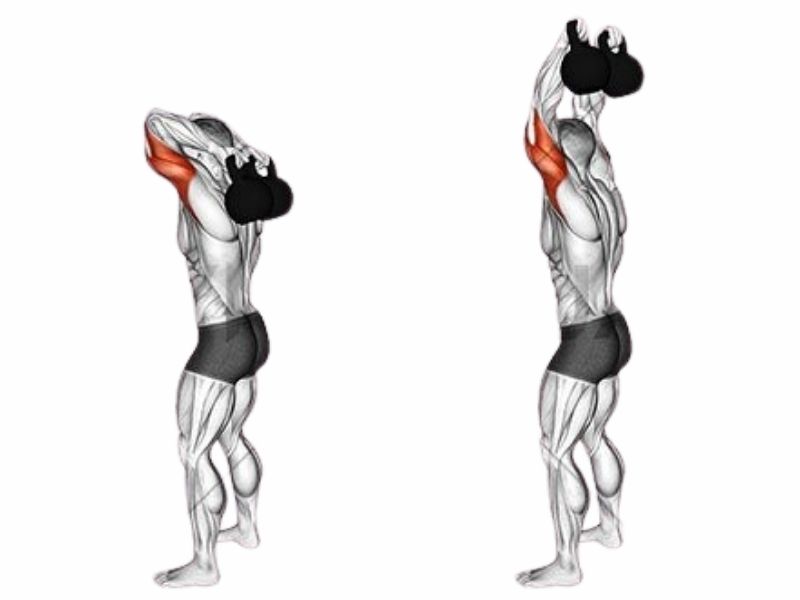

- Stand with your feet hip-width apart and hold a kettlebell with both hands by the horns.
- Raise the kettlebell overhead until your arms are fully extended.
- Keeping your upper arms close to your head, bend your elbows to lower the kettlebell behind your head until your forearms are parallel to the ground.
- Extend your elbows to raise the kettlebell back overhead and repeat.
Kettlebell Skull Crushers:


- Lie on your back on a bench or mat with a kettlebell in each hand, arms extended directly above your chest.
- Bend your elbows to lower the kettlebells towards your forehead, keeping your upper arms stationary.
- Extend your elbows to press the kettlebells back up to the starting position and repeat.
Kettlebell Incline Press:


- Set up on an incline bench with a kettlebell in each hand.
- Hold the kettlebells at shoulder height, palms facing forward.
- Press the kettlebells upward until your arms are fully extended.
- Lower the kettlebells back down to shoulder height with control.
Progression and Intensity
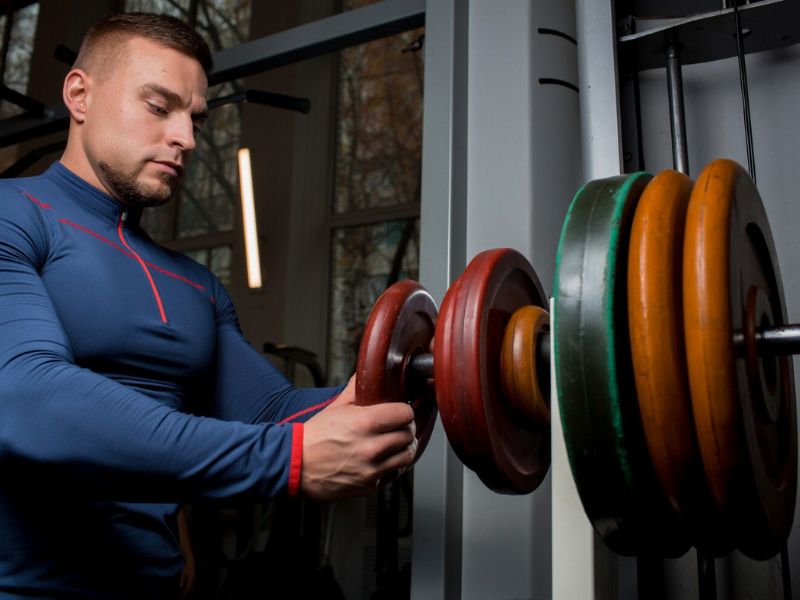

Why Progression Matters: Keeping Your Muscles Challenged
Our bodies are clever adaptation machines.
They get used to the demands we place on them, and muscle growth slows down if the challenge remains constant.
That’s why progression is crucial for continued weight loss success?
It’s about gradually increasing the difficulty of your workouts, forcing your muscles to adapt and grow stronger.
Here are some ways to progress your strength training:
- Increase the Weight: As you get stronger, gradually increase the weight you lift for each exercise. This can be done in small increments, like adding 2.5 or 5 pounds to dumbbells or weight machines.
- Increase the Sets and Reps: Once you can comfortably perform a certain number of repetitions (reps) and sets for an exercise, it’s time to bump it up. Aim to increase the number of reps per set, the number of sets you perform, or both!
- Decrease Rest Time: Shortening your rest periods between sets can also increase the intensity of your workout. This keeps your heart rate elevated and challenges your muscles for a longer duration. However, don’t shorten rest periods so much that your form suffers!
Finding Your Intensity Sweet Spot: Listen to Your Body
Intensity refers to how hard you’re pushing yourself during your workout.
While pushing yourself is important for progress, it’s crucial to find your intensity sweet spot.
Here are some tips:
- The RPE (Rate of Perceived Exertion) Scale: A great way to gauge intensity is the RPE scale. It goes from 1 (rest) to 10 (maximal effort). Aim for an RPE of 6-8 during your strength training sets. This means you should be challenged, but still able to maintain proper form.
- Listen to Your Body: Don’t be afraid to adjust the weight, reps, or rest periods based on how you’re feeling. If something feels too easy, increase the intensity. Conversely, if you’re struggling to maintain proper form, reduce the weight or take longer rest periods.
Remember, consistency is key! It's better to stick with a weight you can lift with good form for multiple sets than to ego-lift with improper form and risk injury.
Staying Motivated and Avoiding Plateaus: Here are some bonus tips to keep your workouts fresh and prevent plateaus:
- Mix Up Your Routine: Don’t get stuck in a rut! Try new exercises, change the order of your workout, or explore different training styles like circuit training or supersets.
- Challenge Yourself with Different Equipment: Explore bodyweight exercises, dumbbells, resistance bands, and weight machines to keep your workouts interesting and target different muscle groups.
- Track Your Progress: Keeping a workout log where you track weights, reps, and sets allows you to see your progress over time, which can be a huge motivator.
Staying Motivated and Overcoming Challenges
Building a sustainable exercise routine requires dedication and overcoming hurdles. This guide will equip you with strategies for:
Setting Realistic Goals: Small Steps, Big Wins
We’ve all been there – setting lofty goals that fizzle out faster than a birthday candle. The key is to start small and celebrate your victories along the way.
So, ditch the “lose 20 pounds in a month” mentality. Instead, set smaller, achievable goals like:
- Strength training 2-3 times per week for the next month.
- Gradually increasing the weight you lift by 2.5 pounds each week.
- Swapping sugary drinks for water for the next two weeks.
As you crush these smaller goals, you'll build confidence and momentum, keeping you motivated on your weight loss journey.
Finding Your Exercise Groove: Make Fitness Fun!
Let’s be honest, if you dread your workouts, consistency will be a struggle. The key is to find activities you actually enjoy! Here are some ideas:
- Love music? Blast your favorite tunes and turn your workout into a dance party.
- Craving the outdoors? Take your workout routine to the park or try hiking.
- Prefer group activities? Join a fitness class or find a workout buddy.
The point is to make exercise enjoyable! When you find activities you have fun with, you’re more likely to stick with them in the long run.
Tracking Your Progress: Witnessing Your Transformation


There’s something incredibly motivating about seeing your hard work pay off. Here are some ways to track your progress:
- Measurements: Take body measurements like waist circumference and hips every few weeks.
- Progress Photos: Take photos of yourself at the beginning of your journey and periodically throughout. Seeing the visual changes can be a huge motivator.
- Workout Log: Keep a log of your workouts, tracking exercises, sets, reps, and weights used. Seeing your progress over time is a fantastic confidence booster.
Conclusion
Strength training is essential for effective weight loss, preserving muscle mass, and boosting metabolism.
This guide provides beginner-friendly exercises and strategies to achieve sustainable weight management and a toned physique.
By incorporating strength training, you’ll not only shed pounds but also experience numerous health benefits beyond weight loss.
Stay consistent, celebrate small victories, and embrace the journey towards becoming a healthier, happier you.


I’ve been visiting this site for years, and it never fails to impress me with its fresh perspectives and wealth of knowledge. The attention to detail and commitment to quality is evident. This is a true asset for anyone seeking to learn and grow.